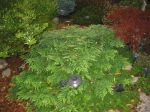Posts Tagged ‘Dwarf Plants’
24
Jun
Posted by steven1111 in Dwarf Plants, Gardens, Groundcovers, Nature, Unusual Plants. Tagged: Dwarf Plants, Gardening, Gardens, Personal Gardens, Unusual Plants. 2 comments
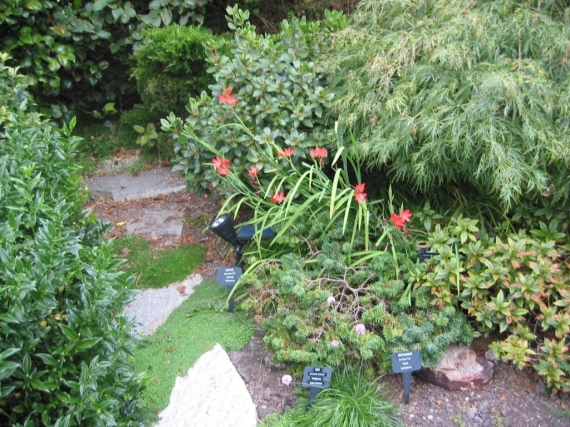
Corsican Mint/Mentha requienii
I love this little mint. It’s one of the tiniest and most delightful plants in our garden. It’s probably the smallest mint you can grow, and only gets a couple of inches tall, but it spreads indefinitely. It’s so wonderful to rub your fingers over it and inhale its sweet fresh scent. I’ll show you several places it’s growing, both where I planted it and where it decided to grow on its own. It’s all over the place now, and I didn’t plant a lot of it. I’ve never seen a flower or seed on it, but somehow it manages to jump all over and grows in the oddest places, often far from the main plants. (Ed. note – Boy I thought I was more observant than this – I just saw dozens of little blue flowers all over these beauties. Must be where the seeds come from. Duh…) Interesting and wonderful!
I first planted a 2” pot of it here among the stones of the walk to the bird feeder in 2008. I’ve had to replant it a few times over the years because it tends to die back in winter, but not always completely. It still persists in coming up and spreading on its own, even when I don’t replant it. This photo is from 2016, and it’s still there today, as you can see in the next photo.

Most of this patch spread from the plants growing among the stones of the walkway, tho I planted a bit under the maple as well. This is the largest patch of it we have, and it’s been steadily expanding over the last several years. Bits of this clump have also jumped across the lawn to grow on the other side. How it does that I haven’t a clue!
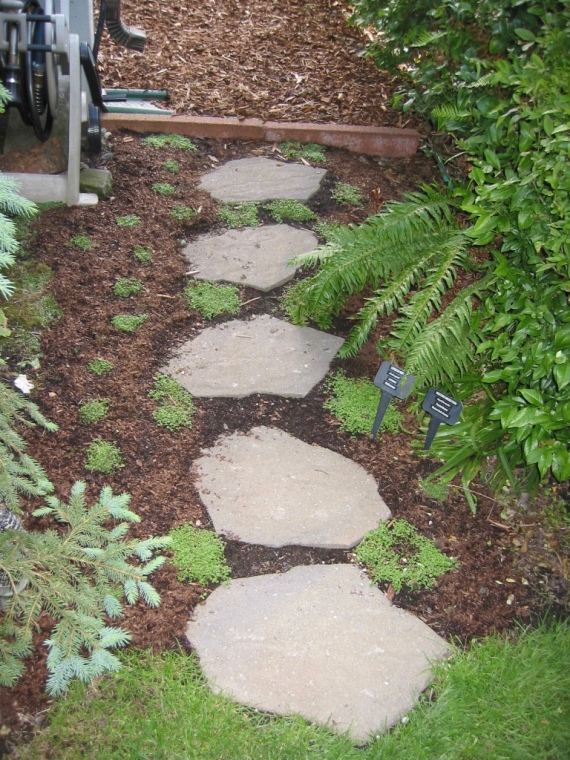
These are the stepping stones that lead to the path along the north side of the house from the front to the back. I planted a dozen little 2” pots all among them in May, 2016. You can see how well they filled in over the next few months in the next couple of photos.

This is in June, after only a month of growth. It grew quite fast, probably because I mulched it well and watered it so often!

Sorry this one is so shady, but it’s the only photo I had of it at this stage. This was taken in September of the same year. It was totally full and lush and it was a delight to walk thru it on the stone path. It’s lovely when the smell wafts up to your nose as you bruise it. It won’t take walking on directly, but if you just brush gently against it it doesn’t hurt it. It looked so gorgeous. I had high hopes that it would be there forever after such an impressive start, but it died down almost completely over the following winter. Darn…

This is what that area looks like today. I haven’t planted any more of it since 2016, but somehow little pieces of it managed to stay alive and it’s now spread around the space. It has a nice naturalistic look to it that I find very attractive. I like the little “wild” areas we have here and there in the garden. They give it a cool energy.

This is an example of how this marvelous mint jumps from one place to another all on its own. The main clump has been here for about 4 or 5 years but the little spots coming up along the lawn edge have all developed and grown this year. As I’ve mentioned I don’t have a clue as to how it does this. It obviously puts on seeds of some sort, but I’ve never seen any of them, or any flowers to give rise to them either. Oh well, I think it’s a wonderful plant mystery, so I just enjoy it.

Here’s another example of this mint jumping around. I planted a small pot of it near the gate here in 2008, very early on in the history of this garden. Later on I planted some by the purple beech too. It mostly died out where I put it but now it’s coming up in the cracks of the pavement! The seeds must be very tiny to do that. But how do they get there? Who cares? I’m in thrall to this plant – it’s so magical!


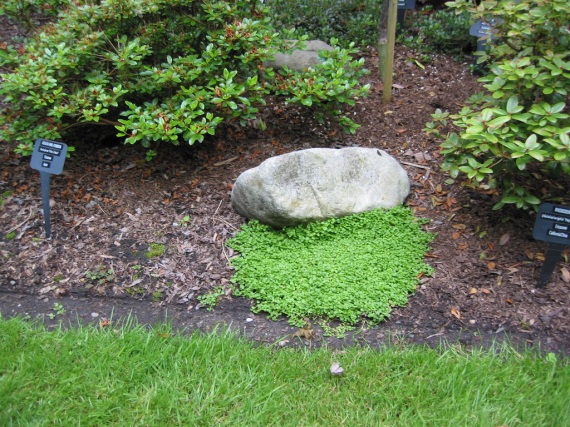

These last photos are of small 2” pots I planted in February of this year. You can see how big they’ve grown in just 4 months. Lots of water, mulch and loving care, and tons of appreciation. I give all our plants a lot of appreciation. I think they thrive on it, but maybe I’m just pretending to hear their joy when I tell them how beautiful they are. Whatever – they sure do grow well!
OK, that’s the story of the Corsican Mint, from my perspective anyway. I assume you’ve guessed that it comes from Corsica, and the Mediterranean in general. Lots of our common culinary herbs come from that region of the world. I’ve never been there but I think I’d enjoy the plants that grow there very much. The hot dry climate is similar to where I grew up in central California. Herbs, and fruits like grapes and olives, do well in both locations. Of course we’re growing this mint in Seattle, and it does just fine here, as you’ve seen. It will probably grow well your garden too. Give it a try!
Fragrantly yours,
Steve
14
Jun
Posted by steven1111 in Conifers, Dwarf Plants, Flowers, Gardening, Gardens, Grasses, Groundcovers, Pruning, Shrubs, Trees, Unusual Plants. Tagged: Conifers, Dwarf Plants, Gardens, Japanese Maples, Personal Gardens, Pruning, Sanctuary, Unusual Plants. 2 comments

Ginny Gee Rhododendron/Rhodendron “Ginny Gee” – March
This will be the last of my Random posts. I could do many more I guess but this’ll be over 5 dozen, and that’s a lot of plants to profile. This has been a fun exercise for me, and I hope for you too. In the future I’ll try to keep up with the changes in the garden more as they happen, but I got so far behind this seemed the best way to try to catch us all up. I don’t make any promises about how often I’ll post tho. I go by my emotions and they change so often, and sometimes I just can’t bring myself to write anything clever or informative. We’ll see how it goes as time goes along. Here are the last Random plants.
This is such a cute little rhode. It’s smothered in light pink blossoms, with some yellow shading to them. It grows relatively slowly and will only get to be a 2-3′ ball. It’s been in our garden for about 4 years and has grown a lot since then. I had it in a shadier spot and it only put on a few blooms last year. But I moved it to a sunnier spot and it loves it. This year it rewarded us with zillions of blooms. Again, it shows just how much difference the sun makes!

Sango-Kaku Japanese Maple/Acer palatum “Sango-kaku” – now
We planted this tree at the corner of the path to the front steps and the one into the garden. It’s also known as a Coral Bark Maple. Its red stems (supposedly) look like a tower of coral rising from the sea in spring when it puts on new growth. You can’t really see that now because the trunk grays out with age, but it’s brilliant in spring. It makes a wonderful archway with the Green pine as you walk under it into the garden. It’s gotten this big in 10 years and will grow to 25′ or 30′ in time.

Ward’s Ruby Azalea/Azalea kurume “Ward’s Ruby” – May
This may be my all time favorite azalea. I love the deep dark red and the intense effect it creates when it forms a mass of tiny blossoms. By some wonderful chance I planted it where you can see it directly from the back door of the house straight thru the garden. It’s so bright it shows up way back there. It’s been here for 10 years and won’t get much bigger, just fuller.

Wissel’s Saguaro Lawson False Cypress/Chamaecyparis lawsoniana “Wissel’s Saguaro” – now
This is one strange looking plant. It’s named for the Saguaro Cactus of the southwest area of the US because the arms spread out and up like the cactus does. It’s grown great here – to over 8′ in just 5 years. No one seems to know just how big it will eventually get. 15′, 20′, ??? – who knows? I even cut a hole in the maple above it to allow it to grow thru it if it gets big enough to reach that high. It’s a great plant to have at the front entry to the house. It gives the impression that perhaps the folks who live here are just a bit eccentric. Now why would they think that?? Ha ha…

Pacific Fire Vine Maple/Acer circinatum “Pacific Fire” – now
This is a cultivar of our native Vine Maple that grows abundantly all over the Pacific Northwest, and down into California. In the forest the species of this tree will grow to 30′ as it grows up thru the surrounding trees like a vine. In less shaded areas it’s only a bush 15 or 20′ tall and wide. This variety is called Pacific Fire because the new growth is a brilliant red and the stems keep some orangish color in them as they age. It’s been here for 3 years and has grown this big from a 5′ sapling.
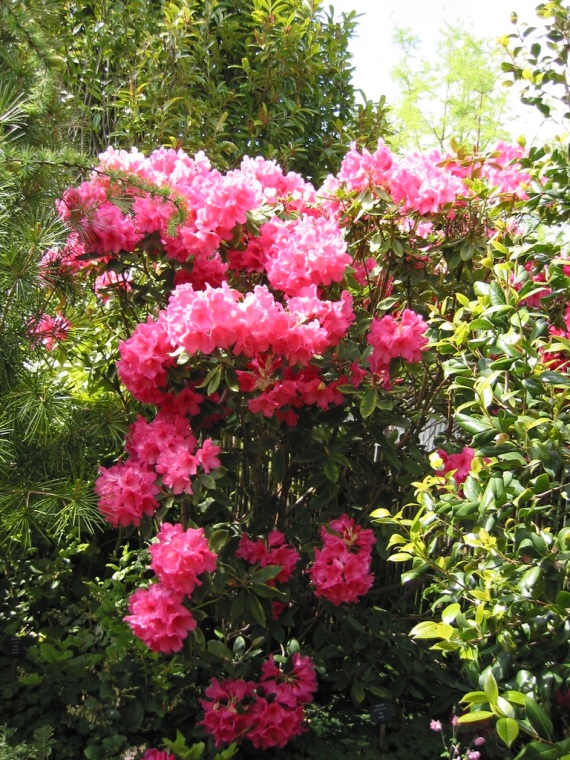
Anna Rose Whitney Rhododendron/Rhododendron “Anna Rose Whitney” – May
The flowers on this rhodie come in trusses of 10 or 12 flowers, and are so abundant the whole plant is just covered in them in spring. It’s gotten pretty big in the 10 years it’s been here, and will get bigger still. The only fault I find with this plant is that the blooms only last for 2-3 weeks – not as long as some, and not as long as I’d like. But they’re so beautiful when they bloom I’m just being picky. And after all – photos are in bloom forever!

Howard McMinn Manzanita/Arctostaphyllos densiflora “Howard McMinn” – February
I lived in the Sierra Nevada mountains of central California for many years, and the Sierras were my “backyard” as I was growing up. So manzanitas have been in my life for over 60 years. Their mahogany brown bark is a defining characteristic of them. They twist and turn and form amazing shapes as they grow. Some are as big as small trees, but this one only gets about 6′ x 5′. It’s been here 10 years. The flowers are very fragrant and the bees love them. A bee-keeper friend in the Sierras would bring us manzanita honey sometimes. It was so fine it set up and crystalized almost immediately. Yummy!

Underplanting of the Red Pygmy Maple – now
There’s no one plant to focus on here. You can see the leaves of the Red Pygmy up above and the Treasure Island Cypress at the right. In the center are 3 nice rhodies – on the left is a Ken Janeck with its new leaves such a soft light green. Next to it is a Ramapo rhodie which has light purple flowers. Barely seen behind them is an Impeditum that doesn’t get enough sun to bloom (remember what I said about enough sun??). The Japanese Tassel fern is on the right and the Japanese Forest Grass is behind the maple’s trunk. The ground cover is Redwood Sorrel, the plant that grows all under the trees in the Redwood groves on the California coast. I love it but it’s also a terribly invasive pest. Gotta go with the love I guess.

Irish Heath/Daboecia cantabrica – now
This is an unusual heath. Most heaths are Ericas, and heathers are Callunas, but this one is a whole different genus. I got it 10 years ago at the Kruckerberg Botanical Garden in a 2″ pot. I stuck it in between the heathers in this bed, which have since all frozen off. I had to move it, but it’s survived all the rest. It’s full of lush spring growth but I’ll show it off later when it’s in bloom. It has lovely lavender bell shaped flowers (like all the Ericaceae) that bloom from midsummer to early fall.

Little Heath Lily of the Valley Shrub/Pieris japonica “Little Heath” – now
This got pretty crowded over the 10 years it’s been here, so last fall I decided to prune out the deadwood and open it up to see how it would look. I was amazed. A little hint – always take out the dead wood first. You may find that’s all you need to do to make the plant look spectacular. At least always start with deadwood before you prune the rest of it. You can see the intricate form of the branches here now with a few flowers at the top (where it gets sun) and some new pinkish growth on the tips. In front of it is a small growing Gemstone Hinoki False Cypress. We just panted it over this last winter. It’s a dwarf, only growing to about 24″ tall and 18″ wide. It may take 20 years to get that big. It’s truly a gem!

Cilpinense Pink Rhodendron/Rhododendron “Cilpinense Pink” – February
One of the earliest rhodies to bloom here. It has delicate light lavender flowers that contrast nicely with the soft blue of the Snow White Lawson Cypress next to it. It’s been here for 4 years and has tripled in size in that time. It’s not super hardy tho and one year the entire set of blooms got hit by a late freeze just as they were blooming. Since then we cover it with burlap sacks to keep them safe, and it’s worked well. It also has very lustrous leaves that are a bit downy looking at the margins.

Stockholm Scotch Heather/Calluna vulgaris “Stockholm” – now
A most unusual Heather. It only grows upright and doesn’t bloom at all, supposedly. It had a few blossoms on it when we got it 2 years ago, but none since. It turns a darker purple-brown in the winter. It fits in well here with the Wild Ginger at the left and the Western Bleeding Heart above it. To the right is a Nana Dwarf Hinoki Cypress – one of the smallest Hinokis. I like how heathers and heaths have coniferous looking foliage. I’ve planted some just for their foliage, knowing that they won’t get enough sun to bloom. But that’s OK sometimes….

Entrance to the Front Garden – now
This is where you come into the front garden. You can just see the arch I created with the Japanese Maple on the left and the Oregon Green pine on the right. The ground drops slightly as you go under the arch so it really feels like you’re walking down into a little glade in the forest. It’s a charming garden to be in. I did a post called A Hidden Gem awhile ago that shows it off much more fully. You can see the Waterfall Maple at the back right, and the Silver Knight heather on the front left. Our Wildlife Sanctuary sign is just under the Maple by the heather. This seems like a good photo to stop with, so I will.
For those of you who have been counting you’ll notice that this is actually the 13th photo in this post, as opposed to only 12 in the previous 4 Random posts. I guess I had an extra one somewhere. I decided it was more important to show you all of them than to cut one for the sake of continuity. I think it was the right decision. They’re all cool photos.
I’ve really enjoyed putting out all these photos in such quick succession. I do prefer to do more informative posts, focused on certain plants or collections of plants, but this was cool to do because I didn’t have a focus. Sometimes Random is the way to go, especially in this chaotic world we live in. It just seemed natural. I have no idea when I’ll post again, but I hope it’s not another 5 months like it was this last time. As I’ve said, my moods determine when I post, and my life in general, so I just hope they give me the impetus to post more often again. Time will tell…
Randomly yours no more,
Steve
12
Jun
Posted by steven1111 in Conifers, Dwarf Plants, Ferns, Gardening, Gardens, Greenhouses, Pruning, Sanctuaries, Seeds, Shrubs, Trees, Unusual Plants. Tagged: Conifers, Dwarf Plants, Ferns, Gardens, Greenhouses, Nature, Personal Gardens, Pruning, Sanctuary, Seeds, Unusual Plants. 2 comments

Oregon Green Pine/Pinus nigra “Oregon Green” – now
I just came in from my usual morning stroll thru the garden. It was a bit damp with a slight drizzle. I particularly like to walk in the garden when it’s all wet. The plants feel incredibly alive! The rainfall is so nourishing. It seems like all the plants are rejoicing. Walking in the garden got me all excited about it so I thought it was a good time to do my next post of miscellaneous photos. Most are very recent but a few are from Fall or Winter. I’ll tell you.
I already showed you a photo of this pine from the front so you could see the candles on the outside. This is the inside. I pruned it out in February. My main goal was to open up the center for both sight and air circulation. I also just felt it was a little crowded inside. It felt like the energy wasn’t moving thru it properly. I tried to bring out the inner “flow” to it. It all radiates out from the main trunk now. The tree has done most of this itself. I pruned out the inner part but the tree itself created the sinuous form. You can’t see it in the photo but it continues to twist and turn as it reaches the top.

3 Fabulous Ferns – now
This is the west end of the fern bed that runs along the north side of the garage. The 3 ferns here are, from left to right, a Hard Shied Fern (Polystichum aculeatum), and Mackino’s Holly Fern (Polystichum mackinoi” and a Remote Wood Fern (Dryopteris remota). Underneath them all is a wonderful patch of Baby Tears (Soleirolia soleirolii). I’ve loved this little plant since we had it growing at my parent’s home in the first landscape I ever did for them. It brings back good memories.
 Tomato Seedlings In the Greenhouse – April
Tomato Seedlings In the Greenhouse – April
I started 9 seeds each of 3 different heirloom varieties. 2 I bought form the Seed Saver’s Exchange, a seed bank/seller I recommend highly. The other one I planted with seeds I grew last year. Beam’s Yellow Pears. Small sweet pear shape yellow fruits kids eat like candy, and so do adults… These were so well developed we could plant them in early May. They’re good sized now. I had way too many of course – I only planted 2 of each variety for us. So I put the others out on the front parking strip and people took them almost immediately. I love sharing the plants I grow.

Silver Knight Scotch Heather/Calluna vulgaris “Silver Knight” – now
This lovely little heather is at the foot of our front steps. In late summer it’s covered with light lavender blooms, but I planted it more for the foliage and form than the flower, since that’s what we see most of the year. We planted it about 5 years ago.

Tenzan Sugi/Cryptomeria japonica “Tenzan” – now
This is the one plant in the garden that I can say with surety is a truly rare plant. The nursery where I bought it labeled it as such and my reading confirms this to be true. It’s the smallest form of Cryptomeria there is and valued as such. Brand new here. It only grows about 1/4″ a year. It’s supposed to get about a foot big. It’s only 8″ now. It’ll take it years to do that.

Charity Mahonia/Mahonia media “Charity” – now
This one has been here about 9 years. In that time it’s grown to 12′ x 10′, give or take. It’s a prickly thing so I had to prune it back quite a bit from the path at its foot. I pruned up the branches but this year it’s putting back all the foliage I cut off! Only it’s further back from the front so I won’t have to mess with it, and it won’t mess with us. I did a post awhile back called Hummer Heaven that shows this in full bloom, covered with brilliant yellow flowers that the bees and hummers love. On the left below it is a Soft Shield Fern (Polystichum setiferum), also known as Alaska Fern, tho it’s native to Europe. Go figure.

Graciosa Hinoki False Cypress/Chamaecyparis obtusa “Graciosa” – now
I took this photo from the porch above this plant so you could see the delicate tracery on its branches. We planted this tree just last year after the snow destroyed the big Arborvitae we had here. It grows slowly at less than a foot a year. It’ll get 10′ tall and 8′ wide. It fits nicely among the rhododendrons, azaleas and kinnickinnick, under the Japanese maple at the right.

Waterfall Dissected Japanese Maple/Acer palmatum dissectum “Waterfall” – now
It does look a bit like a waterfall doesn’t it. The way the leaves overlap one another resembles water flowing down over it. This tree has been growing here since 2013. It’s grown from 2′ across to over 8′. It’s supposed to get even bigger, so I have to prune it back from the lawn every spring. It puts on 2′ of growth a year so it’s a bit of a job. It gets harder every year.

Firefly Scotch Heather/Calluna vulgaris “Firefly” – Fall
This is one of the most colorful heathers there is. In summer it’s orangish green, but the real show is in fall and winter when it turns this deep brick red. We planted a line of them along the North side of our veggie garden. It was too weird to watch the South side of the plants turn this great red color, but from the North side, where we stand to look at them, you can’t even tell the South side is red. Shows you how important it is for plants to get sun, and at the right time, to turn color in fall.
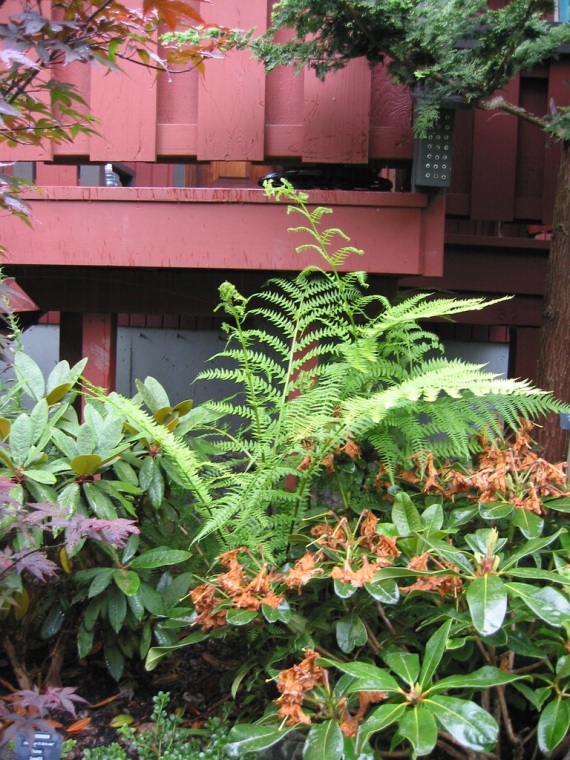
Lady Fern/Athyrium filix-femina – now
This lovely fern is a native of the Pacific Northwest. We never plant them but they come up all over the garden, often in perfect places like this one. It’s a deciduous fern so it dies back to the ground in fall. This one is over 5′ tall and got that way because it was growing behind a large Arborvitae that supported it. Now it tends to flop on the rhodies in front of it.

Bloodgood Japanese Maple/Acer palmatum atropurpureum “Bloodgood” – now
This maple is in the middle of the garden. When you look at it all from the back deck it really stands out. It’s been here for 8 years, and is now 14 1/2′ x 11′. It will eventually get large enough to fill the space it inhabits now. I’ll have to do some pruning as the years go by to encourage the trees to all fit together, as I do so often. In fall this tree gets much darker red, almost black and burgundy and is truly stunning. It’s big enough now to feel like it’s a real tree when you’re underneath it.

Primo Eastern Arborvitae/Thuja occidentalis “Isl/Prm Primo” – now
We just got this cute little thing this last winter. When we bought it it was a darkish brown color. Now it’s this lovely dark green. I love how the branches grow upward like some stone formations I’ve seen in the terrain of the inner mountain west. But this is actually from the east coast and has the same parent as the ubiquitous Pyrimidal Arborviate, the columnar tree grown so frequently as a tall fast growing hedge. By contrast “Primo” only grows an inch a year, if that.
OK, that’s another batch. I may only have one more set, but I have to count them to see. I may add a few more too, if I see some more I like. I keep taking photos so you never know. I’m really enjoying this casual flowing show of photos. It’s so much easier to just post them and write a bit about them. I don’t have to have an overarching theme to follow. But I imagine I’ll get back to that format now that I’m feeling somewhat caught up.
This blog is partly a chronicle of the timeline of the plants in this garden, so I have to keep posting their pictures as they grow up. I’ve taken over 9,000 photos of this garden so I never lack for subjects to post. It’s so interesting to me to show them as they’ve grown. It’s very educational, and lots of fun. I’ve learned a lot growing this garden. Skills I use in my daily life – Patience being the biggest one I suppose. You absolutely have to be patient to be a gardener (and I have to work at it). Plants grow on their own schedules, not ours. The same is true of life.
Acceptance that it is what it is, is the key.
Steve
10
Jun
Posted by steven1111 in Conifers, Dwarf Plants, Ferns, Gardens, Shrubs, Trees, Unusual Plants. Tagged: Conifers, Dwarf Plants, Ferns, Gardens, Japanese Maples, Personal Gardens, Unusual Plants. Leave a comment

Jade Butterflies Ginkgo/Ginkgo biloba “Jade Butterflies” – now
Back again with another dozen photos. As I mentioned in my previous 2 posts these are all miscellaneous photos I’ve taken, mostly in the last few days, with a few from Winter or Fall. I’m labelling them and telling you a bit about each one, but not in great detail. I have no theme or rationale for what I’m putting out here. I just think they’re all cool plants and I want to show them off. They’ve grown so much since I last put them out here. It felt like time I posted again.
This is a dwarf form of the incredible Ginkgo, sometimes called the Maidenhair tree, because the leaves look a bit like Maidenhair ferns. The common name suggests the leaves look like butterflies on the branches. Ginkgos are unique trees, the only member of both their genus and family. They’re millions of years old. We have a National Monument here in Washington state called the Ginkgo Petrified Forest. We’ve been there and seen tons of fossils of very old Ginkgos. This little tree is now about 11′ tall, with an expectation it will grow to be 20′ or so. It grows pretty fast so it’ll get there soon.

Robust Male Fern/Dryopteris fillix-mas “Robusta” – now
We planted this about 5 years ago and man has it grown. I thought it would be a 3′ – 4′ ball, which is pretty big already. But this one is over 5′ across. We have to dodge it to walk on the path here. But it’s no problem. It’s such a lovely vibrant fern.

Ghost Fern/Athyrium X Ghost – now
This one is deciduous. It loses all its fronds in fall. In spring it bursts forth with these wonderful light green fronds. I can see why they called it Ghost. It’s still putting on new growth as I write this, which is pretty late for a fern. It gets up to 3′ across.

Tuscan Blue Rosemary/Rosmarinus officinalis “Tuscan Blue” – early spring
I’m so amazed at this rosemary. True, it’s been here for 10 years, but it’s Huge. Here it’s covered with light blue flowers, a super bee magnet. They love to swarm it and it literally buzzes when you walk by it. It must be 8′ across and 4′ deep and 6′ tall. We get lots of good seasoning from this plant. I love to cook with it. It works well in so many dishes.

Snow Sawara False Cypress/Chamaecyparis pisifera “Snow” – now
When I planted this 9 years ago I was guided by the American Conifer Society’s website that said it would become a 16″ x 16″ box. Hmmm. Not such a good estimate. It’s 4′ tall and 5′ wide now. I have to carefully prune it back every year to keep it in this space. It’s called Snow because it has these lovely white tips in spring, as you can hopefully see here.
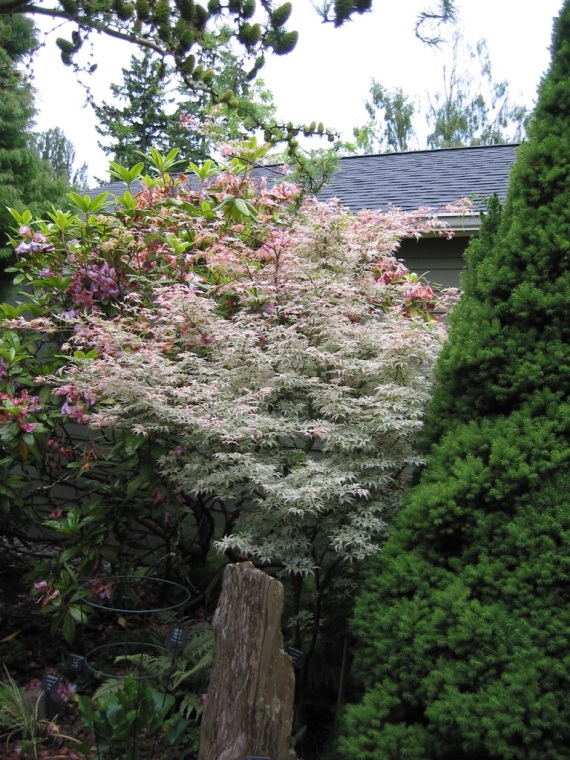
Floating Coud Japanese Maple/Acer palmatum “Ukigumo”
This was supposed to be a 20′ tree but in 10 years it’s still a bushy little thing, tho it’s started to put on longer shoots the last couple of years. You can see why it’s called Floating Cloud. The light green foliage is suffused with lots of white and pink so it looks like a cloud, especially when seen against the darker foliage at the back of the garden. It does seem to float.

Pacific Trillium/Trillium ovatum – now
In early spring the first flowers are pure white. As they age they turn this lovely light pink. I took this photo when I did just to show off this difference. I collected this plant with my pocket knife in the woods in the Cascades one day on our way back from Eastern WA. That was 9 years ago. It’s done well here since then, putting on more flowers each year.

Himalayan Maidenhair fern/Adiantum venustum – now
This dainty looking little fern is actually very hardy. It keeps this delicate foliage all thru the winter. In spring it puts on light pink fiddleheads of new growth. This is only its second year of growth here and it’s spreading well. It’ll fill the area in time.

Inverleith Scots Pine & Nootka Rose/Pinus sylvestris “Inverleith” & Rosa nutkana – now
The Pine has grown here for 10 years. Last year it had the creamy tips it’s supposed to have, but we’d never seen them before. Very nice – we’ll see if it does it again this year. It was found in the Royal Botanical Garden in Edinburgh, Scotland. It was only supposed to get to be a 10′ a 3′ tree. Labels are so deceiving. I collected the rose on my land in eastern WA.
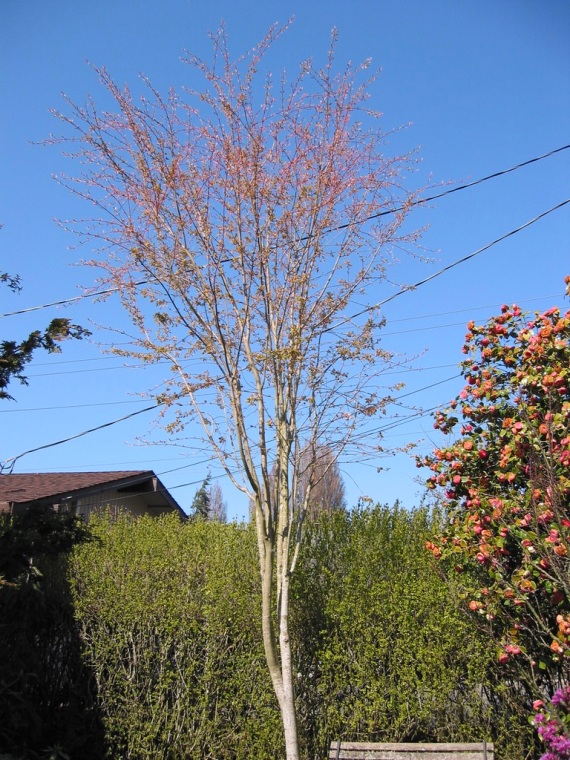
Korean Butterfly Maple/Acer tschonoskii ssp Koreanum – February
A relatively uncommon maple. This is from North Korea. It’s the first maple to leaf out in spring, and the first to lose its leaves in fall. It was a 10′ tree when we planted it in 3/14. It must be well over 25′ tall by now but I dunno how to measure it with a transit, yet. As the trees get bigger I’ll need to do it that way. This turns wonderful shades of reddish orange in fall.
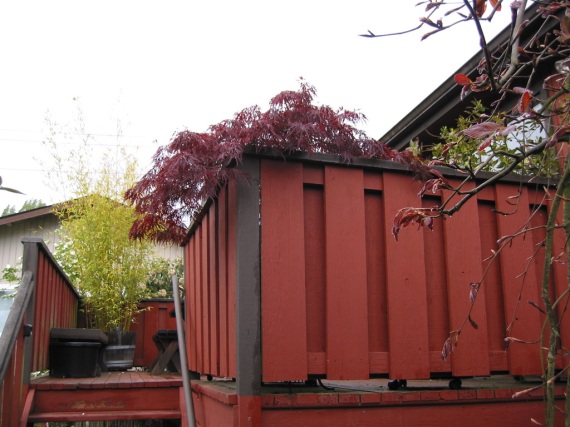
Red Dragon Dissected Japanese Maple/Acer palmatum dissectum “Red Dragon” – now
This delicate tree was getting far too large to keep on the deck, so I had a brainstorm and decided to put in on a stand so it could grow out over the steps and path. It’s high enough that no one will run into it. It’s really cool to look up thru it at the sky. You can see the fine tracery of the dissected leaves really well. It’s a deep red now and turns even darker red in fall.

Treasure Island Lawson False Cypress/Chamaecyparis lawsoniana “Treasure Island” – now
This is a new addition to the garden. We had a small globe blue spruce here that wanted to get way bigger than there was room for. So I took it out and replaced it with this golden cypress. It really stands out in the garden where it is. I used to dislike yellow plants but I think it was because I lived in central CA and they looked washed out in the hot sun. Here in grey sky Seattle they’re stunning, and I have a few of them. They make a superb contrast with all the shades of green we have.
Gee, that went fast, and my back is still in OK shape. Maybe it’s because I just spent 2 1/2 hours touring the garden and even did my PT stretches out there in the sun. I must have examined all the plants 10 times in that time. It felt so good to be out there I wanted to stay outside longer. But I decided to come in and do this post. This makes 3 dozen photos I’ve shown you so far. I have many more. I don’t want to pin myself down to a specific number but there’s a lot. I hope to do them all soon. I love all these plants so much it’s a real treat to be able to share them with others who might also enjoy them.
I hope you’ve had fun looking at them!
Steve
8
Jun
Posted by steven1111 in Berries, Conifers, Dwarf Plants, Flowers, Gardening, Gardens, Nature, Shrubs, Trees, Unusual Plants. Tagged: Conifers, Dwarf Plants, Gardens, Personal Gardens, Unusual Plants. 4 comments
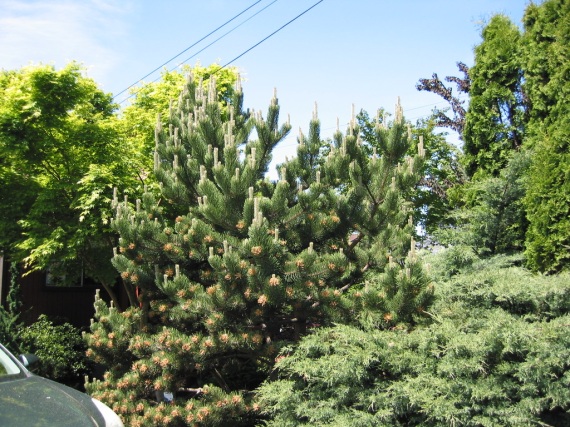
Oregon Green Pine/Pinus nigra “Oregon Green” – March
As I said in my last post I’m doing a few posts on how various plants have grown lately. Most of the photos are from this year – just a couple of days ago in fact. A few are from over the winter. They’re in no particular order. Off we go….
This tree is right on the edge of the driveway and provides a significant break between it and the garden within. This is a photo from a few months ago when the candles were still white. It’s one of the attractions of this tree. It’s called an Oregon Green pine, but it’s actually an Austrian/European Black pine. It was found or created at a nursery in Oregon so it got that name too. It’s a strong grower with very muscular branches. I pruned out the center to display the amazing structure of this tree. There will be photo of that later on in this series of random photos.

Maupin Glow Incense Cedar/Calocedrus decurrens “Maupin Glow” – now
This tree was found near the town of Maupin, Oregon, thus its name. A man was hiking and saw a brilliant flash of gold and found this tree. The new foliage is this brilliant striking yellow/gold. As the foliage grows it turns green, as you can see on the inside. It has luscious dark reddish bark and the wood smells wonderful, as do the crushed needles. Too bad it’s sited next to the dilapidated garage next door. It was the only place I could plant it.
All the websites say this will only get 15′ x 5′ (10 year size). This tree is about 18′ x 15′ after 7 1/2 years in this spot and 2 years in a pot on the deck before that – just under 10 years. I don’t really know how big it will get, but there is one old nurseryman who says it will eventually get 40′ or 50 ‘ tall. I suspect, and hope, he’s right! It can get that tall where it is without any interference. I hope I live to see it!
I grew up near the Sierra Nevada mountains in California, and the species of this tree is a major element of the forests there. I’ve been in love with this tree most of my life. It’s really wonderful for me to have it here in our garden. Reminds me of my youth running free in the woods. I was a real nature boy, living in the mountains and forests. I learned much wisdom there.
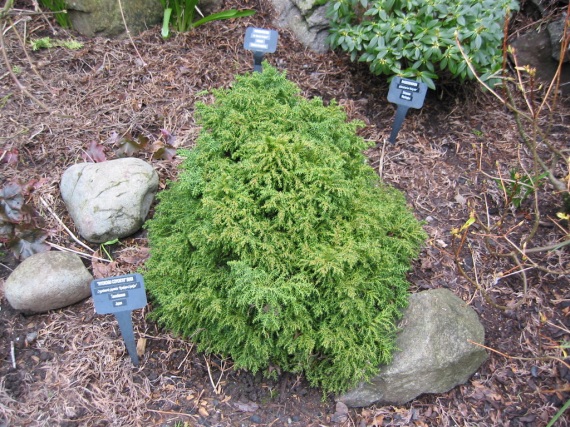
Green Jewel Dragon Sugi/Cryptomeria japonica “Ryokogu coyokyu” – now
One of the several Cryptomeria, or Sugi in Japanese, in the garden. The species of this tree is a large forest tree and is the national tree of Japan. The wood is prized for building temples and shrines, like the Hinoki. There are literally hundreds of cultivars of it. This is one of the smaller ones. It’s only about 18″ tall x 14″ wide, after 6 growing season here. It grows very slowly, only 1/8th of an inch a year, maybe. It looks like a craggy little mountain to me, but apparently someone thought it looked like a Dragon, thus its common name in Japan. Whatever, I love the little conifers like this.
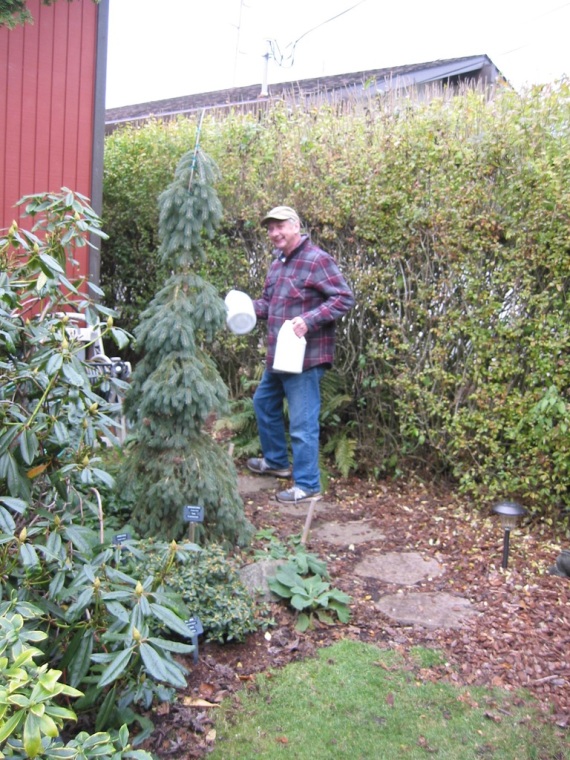
Louie – the most wonderful man in the world! – Last fall
Ours is an inspirational love story. We didn’t meet until we were both 57 years old – proving it’s never too late to find your true love, and that’s what we did. We’ve been living lovingly together for over 12 years now and are quite sure we’ll be together for the rest of our lives. We plan to live into our 90’s – we have to be able to watch the garden grow after all…!!
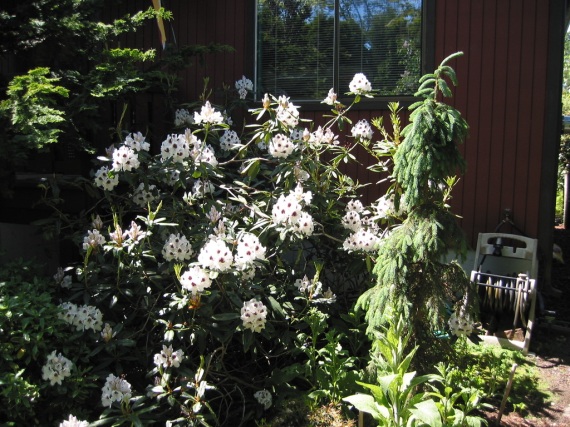
Sappho Rhododendron/Rhododendron “Sappho” – 3 weeks ago
This is one of the few plants Louie planted some 30 or more years ago. It’s an old time favorite of mine from 40 years ago. It has beautiful lavender buds that open to pure white flowers with deep purple hearts to them. That’s my study window above the shrub, so I get a wonderful view of it when it’s in bloom. Named for the ancient Greek poet Sappho, who lived on the island of Lesbos, from which Lesbians get their name.
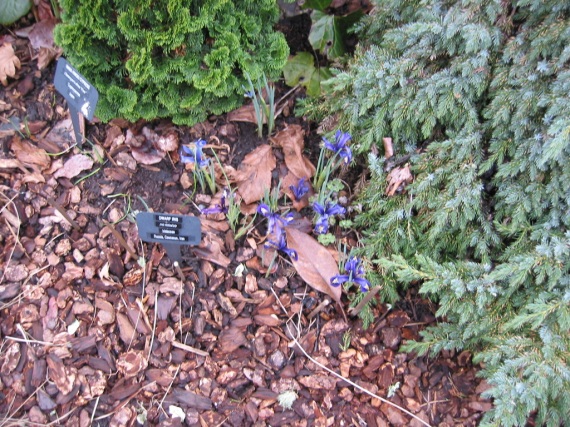
Dwarf or Reticulated Iris/Iris reticulata – early February
This is a very dwarf form of the well known Iris. As you can see they bloom very early in the year, which is pleasant when not much else is in bloom. They’re so dainty, with such deep vibrant colors. They’re well established after only 3 years here.
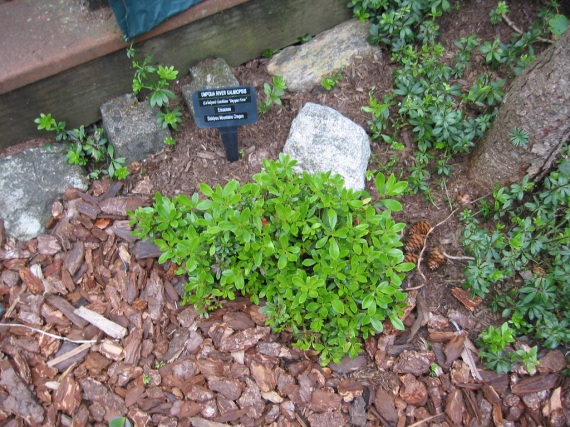
Umpqua River Kalmiopsis/Kalmiopsis leachiana “Umpqua form”
This may actually be one of the truly rare plants I have. Most are either unique and unusual or semi rare. But this is considered to be the very first member of the Ercaceae family – the Heath and Heather family, that contains everything from Rhododendrons and Azaleas to Blueberries, Cranberries and Huckleberries, and so many more. It was found in 1930 in high mountains in the Kalmiopsis Wilderness in the Umpqua National Forest in Southern Oregon. It has lovely little bell shaped flowers, a hallmark of the Ericaceae. It’s grown well here since I planted it in 8/18. I feel lucky to have it here in the garden.

Carstens Wintergold Mugo Pine/Pinus mugo “Carstens Wintergold” – Last fall
We saw this little mugo in the winter when it was this glorious golden color. That’s only two years ago. I’ve found that many plants that color up in the winter need sun to do that, tho not all of them. To be sure it would change I set this pot up on this bench last fall where it can get the most sun possible on the deck. It worked perfectly and you can see the result.
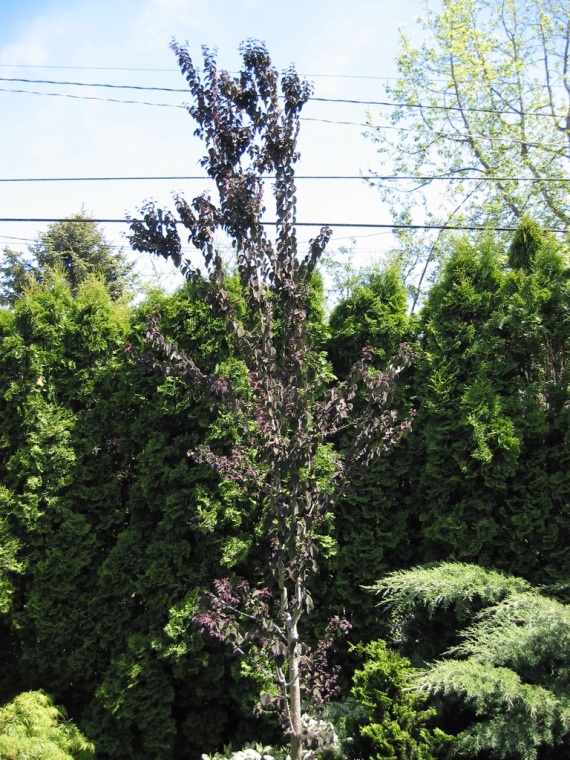
Red Fox Katsura/Cercidiphyllum japonicum “Rot Fuchs” – now
We planted this as a 12′ tree in February 2015. It’s the tallest tree we’ve ever brought home, and it stuck out the back of the VW van about 2 feet. In the time it’s been here it’s gotten too tall to measure, and I can go to 21 -1/2 ft with my bamboo measuring sticks. I pruned back the lower side branches a year ago and last year it put out a few new branches, but not many. But this year it’s literally covered with new growth. There are little branches all over it – some 5″ long and some 18″. All this beautiful purple red, which are especially lovely when you see them against the sun.
The name red fox, or rot fuchs in German, comes from a fanciful idea that the foliage looks like a fox’s tail as the branches grow upward on the tree. Ours isn’t doing that yet, but it looks like it’s going to over the next few years. I’ve seen photos of it doing that and it looks nice. But I like this one too. It’s got a nice gangly look to it that I find attractive. I love the leaf colors too. In summer they turn a deep blueish green. And in fall it turns a golden color. A very unusual tree.

The Back Garden – now
This is what it looks like from the deck right now. There is still new growth on the conifers but most of the other plants have already put on their new spring growth. It’s been an exciting time! So many things to look at when I take my morning stroll thru the garden. It’s been warm enough that I’ve been able to do them naked, as I did last year. (See World Naked Gardening Day last spring). The Weeping Giant Sequoia on the right has finally gotten taller than the plum tree that’s been here for 50 years. A few others are getting closer to its size as well. It really does feel like a little forest when you’re in the middle of it now. After 10 or 11 years the trees and shrubs really do feel sorta mature. It’s a nice place to spend time.
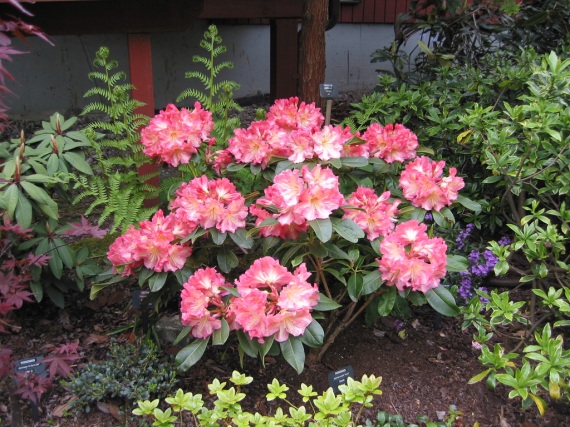
Naselle Rhododendron/Rhododendron “Naselle” – May
I’m so psyched by this rhodie. I had it where it didn’t get much sun and it bloomed poorly. So when I cleared out this space I moved it here and look at the results! It’s covered with these magnificent creamy salmon flowers in huge trusses of 8 or 9 flowers. I’m so happy with it. It shows why sunlight is good for plants. It’s in short supply in our garden, so I use it carefully.
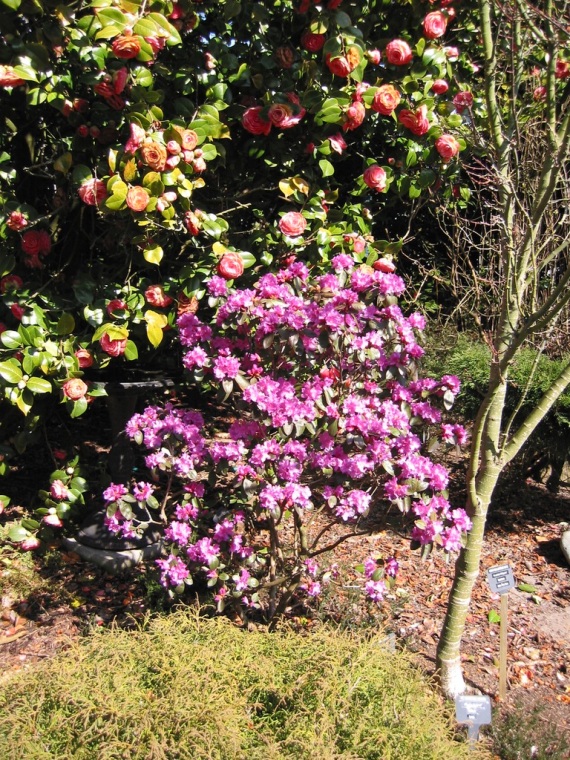
PJM Regal Rhododendron/Rhododendron “PJM Regal” – February
This is one of the earliest plants to bloom every year, as you can see. I moved it to this location a couple of years ago but we’ve been growing it since March 2015. It grows slowly but is always covered with these beautiful magenta blossoms. This is another one I can see clearly from my study window. I’m lucky to have such a nice view of the front garden.
OK, I’ve reached the point where my back once again says I’ve done enough for today. Time to go water the garden. I have several more of these to do so I don’t wanna abuse myself too much. I hope you’ve enjoyed this random look at more plants in our garden. I hope you come back for the next ones too.
Happy (almost) Summer!
Steve
19
Jan
Posted by steven1111 in Conifers, Dwarf Plants, Ferns, Garden Construction, Gardens, Greenhouses, Nature, Sanctuaries, Shrubs, Trees, Unusual Plants, Wildlife. Tagged: Conifers, Dwarf Plants, Ferns, Gardening, Gardens, Greenhouses, Nature, Personal Gardens, Sanctuary, Unusual Plants. Leave a comment

Photo taken 11/08
I thought it might be fun to do a retrospective of the whole garden from its beginning 10 or 11 years ago to today. This is what the front of the property along the street looked like when I first met Louie in February 2008.

Photo taken 1/20
Same scene today.

Photo taken 11/09
I didn’t have an earlier photo so this one was taken when the plants were first planted.

Photo taken 1/20
Fewer plants of some types, more of others.

Photo taken 11/08
This is the entrance to the house. Look how small the plants are.

Photo taken 1/20
The Himalayan Sweet Box in the center scents the whole area now. It’s grown a lot.

Photo taken 11/08
Future site of many cool herbs. It’s so empty!

Photo taken 1/20
Now this is an herb bed! Look at the Tuscan Blue Rosemary at the very back!

Photo taken 11/08
We had to take out this poor apple. It was in bad health and the apples were awful.

Photo taken 1/20
Much more open now. It’s nice to see thru it all.

Photo taken 11/08
This had grass up to the garage when we started digging. Such rich soil!

Photo taken 1/20
Many many ferns later… and a greenhouse at the end!

Photo taken 11/09
I didn’t have one from when this was empty, but there was grass to the fence before we dug it out.
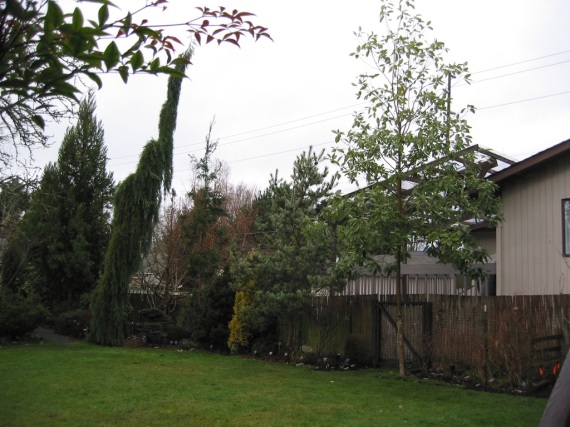
Photo taken 1/20
This is a bit wider shot so you can see we put in a bamboo fence and many plants.

Photo taken 11/08
This is the west end of the garage before we built the greenhouse onto it.

Photo taken 1/20
Looking over the veggie garden to the greenhouse.
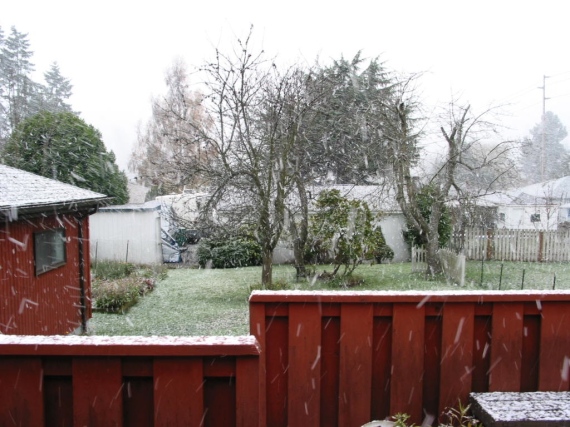
Photo taken 12/07
This was taken about 2 months before Louie and I met.

Photo taken 1/20
It’s a real Garden now!! Here’s to our little Wildlife and Nature Sanctuary!
I hope you enjoyed looking at these photos as much as I enjoyed putting them all together. I had to do a lot of searching through my photo files. I have some 8,000 photos of the garden since 2007 so there were a lot to choose from. I tried to take the “now” photos from about the same place the originals were taken but I didn’t always accomplish that. I think they still get the point across.
It’s amazing to me to look at these and see just how much things have changed. It’s possible to transform an entire yard into a beautiful garden so thoroughly. It’s why I loved creating gardens for people in my past. You can make such a difference with a few (OK maybe a Lot!) of plants and some time. It’s very rewarding. I love gardening!
Time travel has its rewards!
Steve
17
Dec
Posted by steven1111 in Conifers, Dwarf Plants, Garden Construction, Gardens, Nature, Sanctuaries, Shrubs, Trees, Unusual Plants, Wildlife. Tagged: Conifers, Dwarf Plants, Gardens, Japanese Maples, Personal Gardens, Sanctuary, Unusual Plants, wa state dept of fish and wildlife. 2 comments

This is what It looks like across the front of our property. You can see the Heavenly Bamboo (Nandina domestica “Moyer’s Red”) interspersed with Oregon Grape (Mahonia aquifolium) all across it, with Lime Marmalade Coral Bells (Heuchera “Lime Marmalade”) and Black Mondo Grass (Ophiopogon planiscapus “Nigrescens”) underneath it all. Behind them (to the left) is a large solid hedge of Pyrimidal Arborvitae (Thuja occidentalis “Pyrimidalis”). This is all a thick screen for the little garden that lies behind it. It’s a very private space for being right off the street. We’ll go for a short walk thru it now.

This is what it looks like when you walk up the driveway and peek around the screen. I’m standing on the path at the entrance to the garden. On the left it’s framed by a Sango Kaku Japanese maple (Acer palmatum “Sango Kaku”). Next to the maple is a small sign letting you know that this garden is a Backyard Wildlife Sanctuary. We had to show the WA Dept. of Fish and Wildlife that we had food, water and shelter for the many birds who frequent our gardens. It’s very exciting to watch them fly and listen to them sing. We got the sign and a wall plaque for the kitchen for our $5 donation. What a deal!
Above the sign is a Graciosa Hinoki Cypress (Chamaecyparis obtusa “Graciosa”). It’s part of a new bed of plants we put in last February to replace a lost Arborvitae killed by the snows we had then. A sad loss, but it’s a nice garden now. The thin purple stems next to the Graciosa are really a Twombly’s Red Sentinel Japanese maple (Acer plamatum “Twombly’s Red Sentinel”), which is supposed to be the only fastigiate (narrow and skinny) Japanese maple there is. In the bed with it are Azaleas, Heaths, Rhododendrons, a Gardenia and a small White Cedar.
Next we’re going to be coming into the garden from the opposite end. We’ll enter from the path from the back garden. I usually post pictures of the back yard so I wanted to show you the front for a change. So here we go…
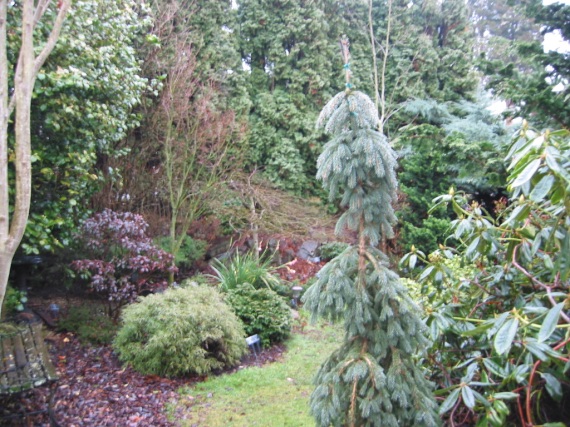
This photo is taken from the path that comes from the back garden along the north side of the house. To the left of the trunk of the Korean Butterfly maple (Acer tschonoskii ssp. Koreanum) is a long semi-deciduous hedge that screens off the north side of the yard from the neighbors and the street, especially in summer. Combined with the Arborvitaes along the front and the conifers along the driveway it creates a nice secluded space, as you’ll see.
The narrow conifer in the right side of the frame is a Weeping White Spruce (Picea glauca “Pendula”) that will eventually get a lot taller than the house for a nice exclamation point at the corner. On its right is a Sappho rhododendron that Louie planted over 30 years ago. It has white blooms with a splotch of dark purple in the centers. A very old variety. Nice.
In the center of the photo are a couple of small dwarf conifers. On the left is a Mr. Bowling Ball Arborvitae (Thuja occidentalis “Bobozam”) – the same arborvitae as the Pyrimidal in front – amazing variety, eh? Next to it is another arborvitae – this time a cultivar of our PNW native, the Western Red Cedar. This one is called Grune Kugel or green ball in German (Thuja plicata “Grune Kugel”). In winter the Bowling Ball turns light green, and the Grune Kugel has red tips.
Above the conifers is a deep purple PJM Regal Rhododendron (Rhododendron “PJM Regal”). Blooms early with light lavender blossoms all over it. Behind it is a huge old Camellia that’s been here since the ’40’s. It has kind of mediocre red blooms in early spring but it’s so covered with them it’s still nice. Next to it is a small growing version of the Japanese maple called Lionshead (Acer palmatum “Shishigishara”). Interesting crinkled leaves turn a striking orange-red in the fall.
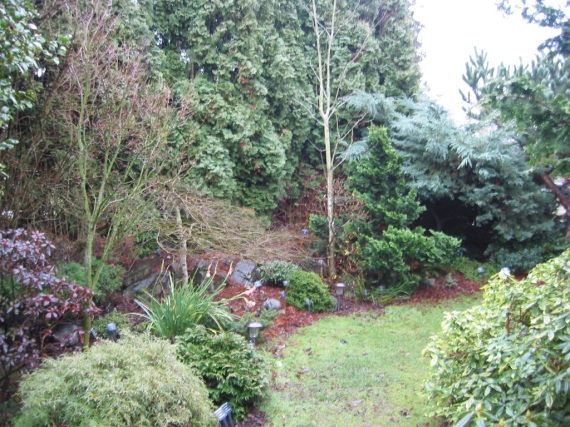
This is your view as you turn the corner and come fully into the garden. The Lionshead maple is much clearer here and next to and below it you can see the Waterfall dissected Japanese maple (Acer palmatum dissectum “Watefall”). The tall tree near the center is a Red Fox Katsura (Cercidiphyllum japonicum “Rot Fuchs”). It has purple leaves in spring that turn a nice deep blueish color for summer and yellow-orange for fall. A unique tree that grows upward, but not out, supposedly. To its right is another commonly planted dwarf Hinoki (Chamaecyparia obtusa “Nana Gracilis”).
Forming the screen at the end of the garden is a large blue Pfitzer juniper (Juniperus pfitzeriana “Glauca”) that Louie planted when he did the Arborvitae hedge 30 some years ago. You can see how it merges with the Arborvitae hedge out front to form a solid screen. Makes it very private in here. On the low right is a Winter Daphne (Daphne odora “Marginata”). It is one of the smelliest plants in the world. It fills the whole garden with its intoxicating sweetness in late winter. Wow…
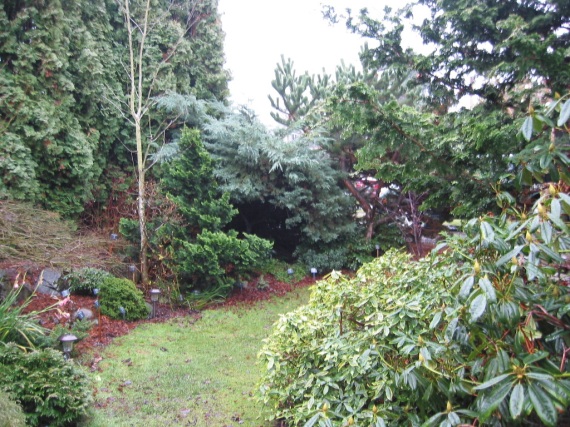
You have a better view of many of the plants I’ve mentioned so far. The Arborvitae and Katsura on the left, the Hinoki next to it, the blue Pfitzer juniper and the Daphne at the bottom. At the back you can also see in the arms of the Oregon Green pine (Pinus nigra “Oregon Green”) sticking up. It merges with the Pfitzer to complete the screen around the corner to the path I stood on in the first photo. Above the Daphne and Sappho are the arms of a species tree of the Hinoki Cypress (Chamaecyparis obtusa). It encloses the front porch to make a lush dark green entrance to the house.

We come full circle here to the opening on the gravel path I stood in at the start of this little tour. You can see the blue Pfitzer at the far left with the Green Pine seeming to grow out of it. I’ve trained the pine and the Sango Kaku maple on the right to form a cool arch you walk under to come into the garden. I love plant arches…. I think it makes it seem a bit more mysterious to walk into a garden under an arch. Especially in summer when the maple is in full leaf.
I think I’ve covered all the trees and shrubs you can see, with the slight exception of a couple of Rhododendrons you can barely see in the center of the photo (Rhododendron “Naselle” and Rhododendron “Sir Charles Lemon”). The Naselle is loaded with buds for next spring but the Sir Charles won’t bloom for years they say. It has cool leaves with indumentum on the undersides. It’s that furry brown stuff you find on the undersides of evergreen Magnolias. A cool feature.
This was a short tour of photos, but long on explanations. I hope it was enjoyable for you all. This little private garden is so secluded I was able to come out here and garden naked all summer long. (See “World Naked Gardening Day” from last May for more on that subject…). It was kind of fun to hang out here working and hear people talking as they walked by in the street outside the hedge. If only they had looked behind the screen! Privacy has all kinds of benefits…
Stay warm!
Steve
11
Dec
Posted by steven1111 in Berries, Conifers, Dwarf Plants, Garden Construction, Gardens, Grasses, Nature, Peat Bogs, Pruning, Sanctuaries, Shrubs, Snow, Trees, Unusual Plants, Vegetables, Wet Soils. Tagged: Conifers, Dwarf Plants, Gardens, Nature, Peat Bogs, Personal Gardens, Pruning, Sanctuary, Unusual Plants, Vegetables, Wet Soils. 2 comments
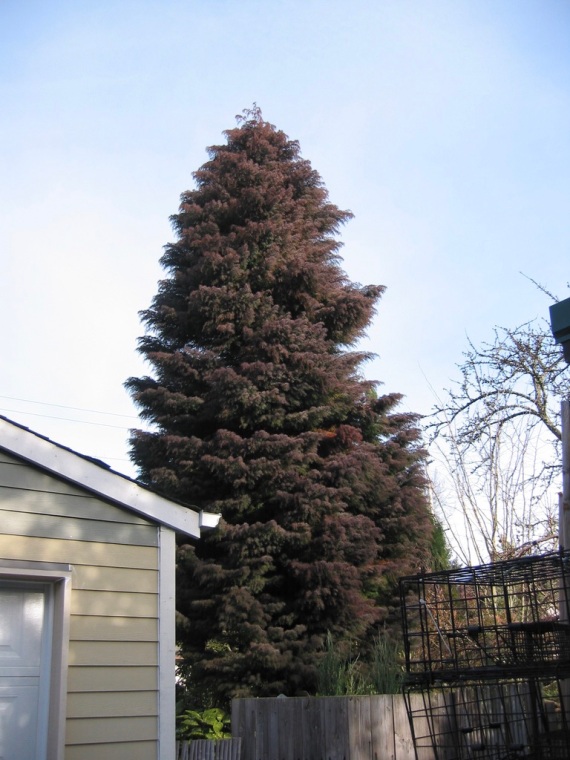
This is the Elegans. It’s formally called Cryptomeria japonica “Elegans”, or Elegans Sugi in Japanese. This is a photo I took from our neighbor’s yard because you can’t see this full a picture from our yard. Too many trees in the way. I planted it about 10 years ago from an 18″ sapling. I’d say it’s closing in on 30′ now. Wow. It’s one of my favorite “pettable” trees because you can literally pet it it’s so soft and luxurious. Not like other conifers at all – the ones that stick you so readily.
The photos in the following series form a panoramic view of the back garden from the base of the Elegans, on the other side of this photo. From there you can pretty much see the whole back garden. It’s a comfortable, dry spot to stand at times when there’s a little bit of drizzle like we have coming down today. I’ll show you in the next photo.
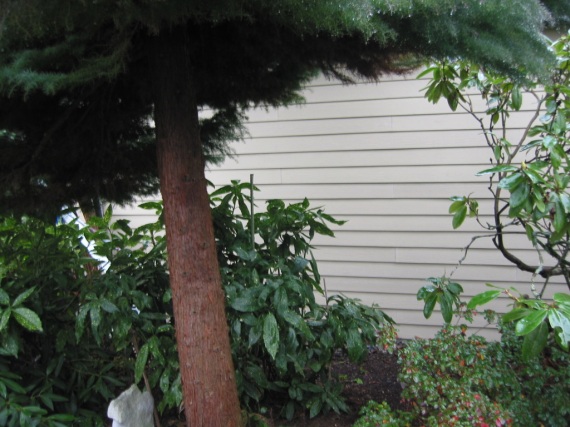
This is where I’m standing. The trunk is angled in such a perfect way that I can lean back against it and it supports my back like a recliner. Nice for a bad back – the gardener’s curse. Underneath the Elegans is what’s left of the formerly large Gold Dust plant (Aucuba japonica) that I almost killed by planting the Eleagns were I did. Silly me. I was able to prune the Aucuba so that it now grows luxuriously on the margin of the Elegans. It gets lots of sun and can grow tall again.
On the right is a Blue Peter rhododendron that Louie planted here some 30 years ago. In the spring it’s a mass of light purple flowers with darker purple centers. A lovely older variety. Below is the most wonderful azalea in the garden, in my opinion. It’s a Kurume called “Ward’s Ruby” (Azalea kurume “Ward’s Ruby”). When it blooms it’s covered with the deepest red blossoms imaginable and can be seen from the house. It loves it here. In fact all the Ericaceae (Heather family) thrive in the deep, wet, peaty soil we have here in our little Nature Sanctuary. You’ll see a variety of acid loving plants here.
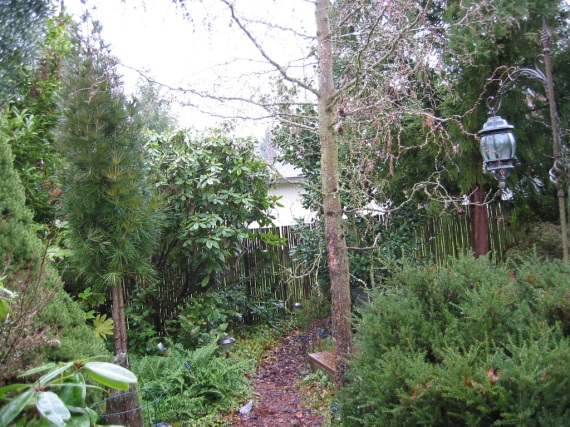
This is what I see when I look to my left. The tall spindly tree on the left is a “bound” Japanese Umbrella Pine form called “Wintergreen” (Sciadopytis verticillata “Wintergreen”). It’s bound because it was damaged in the “snopocalypse” we had in February (we don’t get much snow here so we tend to be dramatic about it when we do get it….). I had to tie up all the branches because they were drooping so badly from the weight of the snow. I’ll keep the ties on for a year or so and then remove them. The branches will (hopefully) bounce back up to where they’re supposed to be. Below it is a huge patch of Licorice fern (Polypodium glycyrrhiza). It’s a PNW native you often see on the trunks of trees in the rainforest.
Next to is is a stalwart rhodie called Anna Rose Whitney. It’s about 6′ x 7′ now and when it blooms in spring it’s a mass of brilliant hot pink with huge trusses of 8 or 10 flowers each. Very impressive. The tall tree with the twisty branches to the right is a “Diana” contorted Japanese larch (Larix kaempferi “Diana”). It’s one of the handful of deciduous conifers in the world. It has apple green needles all summer that turn a marvelous shade of deep orange before dropping in the fall.
At the bottom right is a rarely seen Alpine Yew Pine (Podocarpus alpinus “Red Tips”). It’s from New Zealand and is related to the better known Japanese Yew Pine (Podocarpus macrophylla). It has beautiful reddish purple tips in late spring. It looks like a haze over the whole plant. Above it is the trunk of the Radicans Sugi. That’s the big dark green tree in back, behind the lamp. It covers an edge of the little deck we built so we could hang out in the garden. More on the Sugi in a moment.
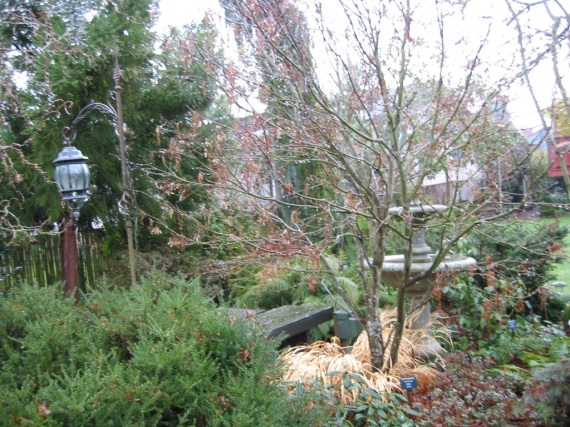
When I turn to my right I see the Yew Pine in the foreground with the hanging light above it. The reddish brown trunk to its left belongs to the Radicans Sugi (Cryptomeria japonica “Radicans”). It’s like the Elegans in size now but is definitely not pettable. It gets bigger too – up to 55 feet or so they say. The tall dark shape in the background is a Weeping Giant Sequoia (Sequoiadendron giganteum “Pendulum”). It’s grown over 35′ tall it 10 years, and is the tallest tree we’ve planted.
In the middle foreground is a Red Pygmy Japanese Maple (Acer palmatum “Red Pygmy”). Below are a couple of nice rhodies – Ken Janeck and Ramapo. The light yellow plant is a large clump of Japanese Forest Grass (Hakanechloa macra “All Gold”). Behind the maple is the fountain, which we keep empty in the colder times of the year. It’s raining now so it’s full.
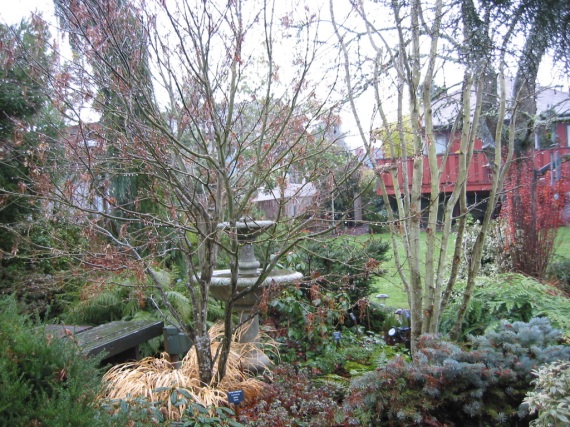
Going clockwise some more you can see the fountain more clearly and a fuller view of the Red Pygmy. I’ve recently pruned it out and I’m very pleased with my efforts. It all seems to be growing the way it wants to and should be a fine strong structure over the years to come. I’ve been reading about Aesthetic Pruning lately. The descriptions sound like what I’ve been doing for decades, more or less. When I was first starting out in the landscape biz I worked with a tree pruner who did “Aesthetic and Therapeutic” pruning. I took it to heart and have tried to emulate his practices ever since. It’s about the health and beauty of the whole garden environment, taking all factors into consideration. Seems like common sense to me.
On the right is a Vanessa Persian Ironwood (Parrotia Persica “Vanessa”). I’ve trained it quite a bit to be very narrow at its base since it tends to spread out as it gets taller and we need to be able to walk around both sides of it. It’s turned out really well and I think it will grow companionably with the big plum behind it. (You can barely see it on the right). The Ironwood turns a spectacular brilliant golden color in the fall. You can see it shining from the back door of the house.
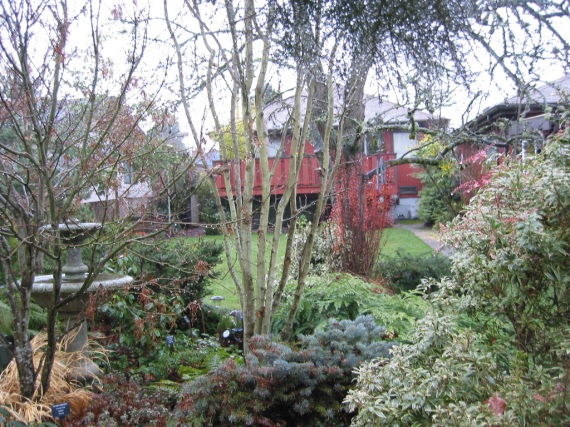 In this one you can see the Plum and why I need to prune the Parrotia away from it. They have to agree to share the air space above them. I think I did a good job of preparing them to play nice. The small blue conifer at the bottom is a RH Montgomery blue spruce. It wants to get bigger than it can here so I have to prune it very judiciously to keep it looking nice and healthy where it is. We’ll see how long I can do that. At the right is a mid-size Lily of the Valley shrub called Little Heath (Pieris japonica “Little Heath”). It has lovely racemes of small white bell shaped flowers in early spring. The leaves are nicely variegated with light green and pink on the margins, especially in spring. It’s another plant in the Heather family.
In this one you can see the Plum and why I need to prune the Parrotia away from it. They have to agree to share the air space above them. I think I did a good job of preparing them to play nice. The small blue conifer at the bottom is a RH Montgomery blue spruce. It wants to get bigger than it can here so I have to prune it very judiciously to keep it looking nice and healthy where it is. We’ll see how long I can do that. At the right is a mid-size Lily of the Valley shrub called Little Heath (Pieris japonica “Little Heath”). It has lovely racemes of small white bell shaped flowers in early spring. The leaves are nicely variegated with light green and pink on the margins, especially in spring. It’s another plant in the Heather family.
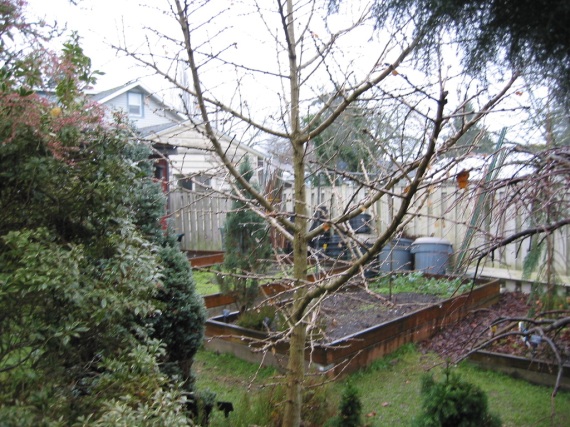
On the left is the Little Heath and in the middle is a Jade Butterflies dwarf Ginkgo (Ginkgo biloba “Jade Butterflies”). It’s so named because the leaves look like little butterflies. Ginkgos are supposed to turn a spectacular shade of golden yellow in the fall. They’re known for it. But for some odd reason ours never does this. lt’s usually a pallid shade of yellow. Except last year when Everything was brilliant it did what it’s supposed to do. ???
Behind the Ginkgo is a snatch of our veggie garden, with a Spaan’s Slow Column Scots pine (Pinus sylvestnis “Spaan’s Slow Column”) at the north end of the veggies where it won’t shade them. You can see a patch of Lacinato Kale at the back. They’ll be in fine shape to start to grow at the very beginning of spring. They overwinter quite well. The blue barrels hold garden soil, compost and fertile mulch for when we need a bit of help with things. It’s handy to keep a bit of each on hand.
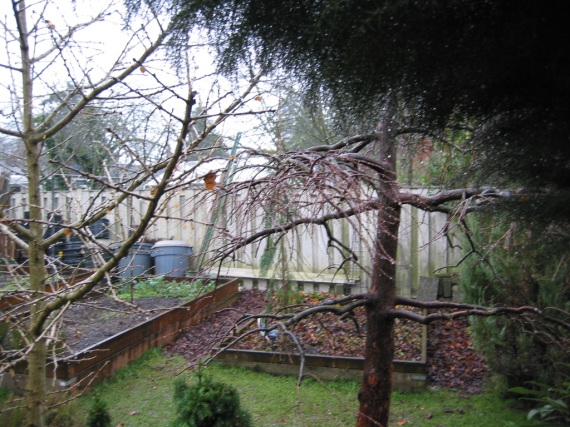
This is the final shot in the panorama. You can see the Ginkgo on the left and in the middle is the Miss Grace Dawn Redwood (Metasequoia glyptostroboides “Miss Grace”). It’s another of the few deciduous conifers that exist. We also have a third – a dwarf Swamp Cypress (Taxodium distichum). (It didn’t show up in this series of photos). Both the Metasequoia and Ginkgo are very ancient trees, formerly found only in the fossil record. It’s nice to have them in cultivation. You can see the strawberry bed better here. It’s not that big but we get quarts of berries. Fresh fruit is so wonderful to pick and eat right out of the garden. Above you on the right is the Elegans again. We’re almost back where we started.

Here we are back at the trunk again. I intentionally pruned up a hollow in this tree so we could stand under it when it rains, which it was doing just now when I took all these photos. I didn’t plan for this to be such a wonderful viewing spot but I’m so glad I “discovered” it one day when I was perambulating the garden, which I try to do every morning. I like to keep up on the doings of all the plants and do bits of “micro pruning” to keep everyone growing happily and harmoniously together. It’s a magical sanctuary but it takes constant, careful work to keep it that way. Having a spot like this where I can overlook the whole garden at once helps me get a more holistic perspective on things. It’s easier to comprehend it all as one large entity.
I hope you enjoyed these panoramic views of the garden. It all feels so much bigger when you’re in the thick of it.
Relaxing on a rainy day,
Steve
19
Sep
Posted by steven1111 in Climate Change, Conifers, Dwarf Plants, Ferns, Garden Construction, Gardens, Nature, Peat Bogs, Sanctuaries, Shrubs, Trees, Unusual Plants, Vegetables. Tagged: Conifers, Dwarf Plants, Ferns, Gardens, Japanese Maples, Nature, Peat Bogs, Personal Gardens, Sanctuary, Unusual Plants. 2 comments

This is the sort of photo I usually present of our garden. It shows you the south side of the main ornamental garden, with a few marigolds and tomatoes from the veggie gardens in the foreground. It was taken from along the fence in the back of the veggie garden. It’s a nice colorful photo full of plants that lets you see what this whole side of the garden looks like, tho I guess this one’s a bit impressionistic, isn’t it. Lots of colors, textures and forms all blended together. Getting nice wide shots like this generally means shooting them from outside the garden itself.
This time I’m going to show you photos that were taken looking out from inside of the small forest we’re creating here in the rich peaty soils of our intensely planted little Nature Sanctuary. It’s what we see when we venture off the lawn and onto the soft bark paths that wind thru the trees. It almost feels like you’re walking in an actual forest, and it smells like it too. Inside you’re enveloped within the lush scents of the trees and all the other amazing plants growing in here. Many of them are taller than we are so it all feels much bigger inside it than it ever looks like from the outside. It’s a bit different, as you’ll see.

This one was taken from a crossroads at the back of the path that leads into the south side I showed you in the last shot. The big Elegans Sugi is on your right, and it really feels big when you stand right next to it. The Red Pygmy maple is on the left, and standing in between them you feel enclosed in the trees’ energies. It feels deep, calm and peaceful.

This is taken from the same spot as the last one, only now we’re looking directly under the Elegans sugi. You can see how soft it looks. It is. It’s one of my main “pettable” trees because the needles won’t stick you like most other conifers will. Being next to it you can really pet it! It’s only been here 10 years and has grown from 18″ to over 25 feet tall in that time!

As you move back into the depths of the forest on the same path you can see the green, white and pink variegated leaves of the Ukigumo Japanese maple on the right, with the soft droopy Elegans Sugi in the back and the deciduous Japanese Larch “Diana” on your left. The Larch is all contorted and twists and turns around on itself. Very cool! The big “Blue Peter” Rhododendron in the middle has been here for well over 30 years! The ground is covered with Kinnickinnick.

This is what you see when you turn around and look back behind you, past the Larch and towards the edge of the garden. You can just see the Japanese Umbrella Pine on the left, with a big rhodie next to it that encloses the space nicely. The little Licorice Fern on the lower left gives the lush feel of the PNW rain forests. It dies back every year but returns even better.

If you stand in the same spot again and look towards the deck you’ll see our garden lamp and its wrought iron post. The Larch is on your left and the Red Pygmy Japanese maple is on your right, with the Alpine Yew Pine in the foreground.

As you move up onto our little deck under the Larch branch you can see the bench and the light, with the fountain in the middle at the back side of the bench. The Red Pygmy maple is right in front of you and the Bloodgood Japanese maple is the red tree on your left. And no, we didn’t kill the deer whose horns grace our bench. Consider it a “found” item….

This is taken from the same spot on the deck as the last shot, only looking to your left a bit. The huge fern at the bottom left is an Alaska fern that has gotten huge in its 10 years here. I cut it back to a foot high every spring and it grows back to this! You can see the Bloodgood maple more clearly here. On the left edge of the photo you can see the stairs to the house.

And finally, turning all the way to the left you can see the edge of the deck and the path leading back out of the forest to the outside again where the lawn is. On the edge of the lawn the large conifer on the left is a 30′ tall Weeping Giant Sequoia. It leans a bit to the neighbors – eek! The big tree on the left is a Radicans Sugi which is now at least 25 feet tall. You feel small next to it and can hardly see the top of it when you stand on the deck now. All this from a 5 foot tree planted in 2013!
So did you feel the difference being inside the forest? I hope so. It’s so hard to convey just how cool it is to wander around under these trees and in between the shrubs. Seeing them up close like this you get to admire all their unique foliages, forms, textures and growth habits. You get to touch and smell them. They become real creatures to you, not just colors and shapes you see from a distance. It changes you to be in there. It’s all pretty well kept and even semi formal, but it’s full of wildness too. The plants make it so. In just 10 years this has become a truly lovely little Nature Sanctuary and Forest. It’s all part of our efforts to save and enhance a vibrant little part of the Natural World! Combat Climate Change – Plant a Forest!!
Make your own little Nature Sanctuary!
Steve
16
Aug
Posted by steven1111 in Dwarf Plants, Ferns, Gardens, Groundcovers, Nature, Shrubs, Unusual Plants. Tagged: Dwarf Plants, Ferns, Gardens, Nature, Personal Gardens, Unusual Plants. 2 comments

Alaska Fern (Polystichum setiferum)
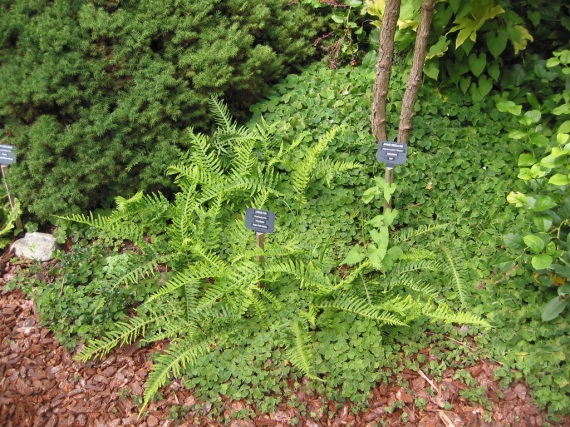
Licorice Fern (Polypodium glycyrrhiza)

Japanese Tassel Fern (Polystichum polyblepharum)

Remote Wood Fern (Dryopteris remota)

Makino’s Holly Fern (Polystichum mackinoi)

Hard Shield Fern (Polystichum aculeatum)

Deer Fern (Blechnum spicant)
I called these ferns “riotous” because they’re all growing so outrageously, and it’s the middle of August!! It’s hot out! They not supposed to do this, are they? I suspect it’s all the water I give them, but whatever it is I’m thrilled! They’re each putting on several new fronds and are filled with amazing green energy. They’re as beautiful as you could want a fern to be – and these are all evergreen so they’re lovey all year round.
I see plants everywhere in the garden thriving with such lush new growth right now, but these ferns are special, each one a unique world in itself. Ferns are often used to illustrate the concept of self-similarity in fractals. The more you dive down into a fractal the more it looks the same. Start with a wide view and slowly move your gaze all the way down into the center of a large fern sometime and you’ll see what I mean. It will transfix you. Amazing!!
I hope you’re as impressed as I am with the vigor of these ferns, and in such an unlikely season. Riotous they are indeed!!
Steve
20
Jul
Posted by steven1111 in Conifers, Dwarf Plants, Gardens, Nature, Pruning, Sanctuaries. Tagged: Conifers, Dwarf Plants, Gardens, Personal Gardens, Sanctuary, Unusual Plants. Leave a comment

Dwarf Alberta Spruce (Picea glauca var. albertiana f. conica)
All the conifers I’ll be showing you in this post are small ones that only grow up to 10′ tall. I love the little ones a lot. They take up little room so there’s space to plant several of them in small areas. Of course I have them all over the garden. These two have been growing here for over 35 years. Louie planted them long ago and they’ve gotten quite large in that time. They’ll get still bigger, but not more than 10′. Discovered in 1904 they are native to SW Canada and across the Northern US to Maine. You’ve probably seen these all over, as they are sold as christmas trees at holiday time. Naturally no one ever realizes just how large they get and are surprised when they outgrow their tiny planting spaces. Ah well… Live and learn…
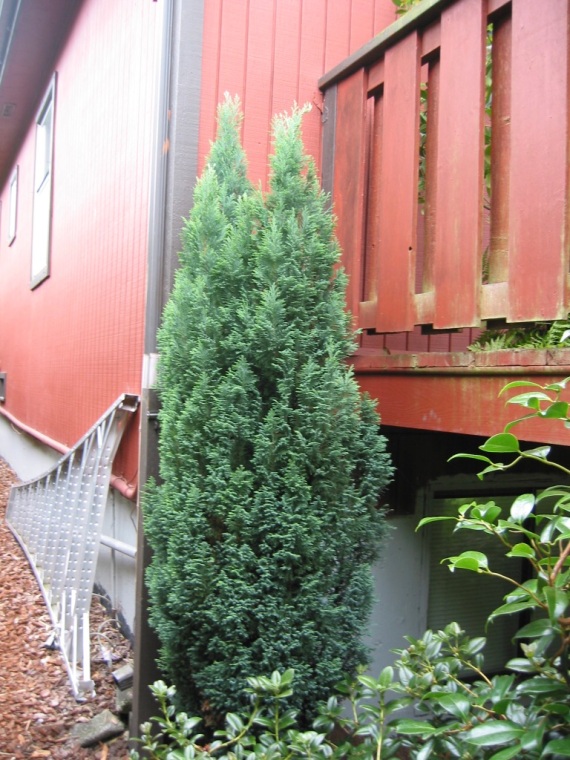
Snow White Lawson Cypress (Chamaecyparis lawsoniana “Snow White”)
This is a dwarf form of the Lawson Cypress, or Port Orford Cedar, that grows in southern Oregon. The species tree is a large forest dweller that gets quite tall, but this one will only get 6 or 8′ tall. It’s 6 1/2′ now after about 10 years in the ground here. It’s soft and fluffy to the touch and is tinged with a light yellow white color in spring. One of my favorites.

Red Star Atlantic White Cedar (Chamaecyparis thyoides “Red Star”, aka “Rubicon”)
We jump across the United States from the last one with this Red Star False Cypress. I just planted this a few months ago and it’s still very small, but it will get 4-5′ tall in time (some people say much larger, but who knows…). Its blue green juvenile foliage turns a warm red purple in winter and is quite lovely. A slow grower, it will take years to achieve its full size.

Mr Bowling Ball Arborvitae (Thuja occidentals “Bobozam”)
Where do they get these names anyway? Doesn’t look much like a bowling ball to me, and I don’t have a clue why it’s called Bobozam, but it’s kind of a cool name. Native to the NE United States and SE Canada it has filiferous foliage that turns this lovely light color in winter, when this photo was taken. It’s green now. It might become a 3′ ball, but it will take awhile.

“Grune Kugel” Western Red Cedar (Thuja plicata “Grune Kugel”)
This is a dwarf form of the signature PNW tree – the mighty Western Red Cedar. This special tree was used by the indigenous people for just about everything. They made buildings and canoes of it, used it for basketry, and used it in ceremonies. It was the “buffalo” of the Northwest, as far as its utility to the native people goes. It will take it years to become much more than a 2′ ball. It always amazes me to see a small dwarf form of a huge tree. Trees do such incredible things!

Blue Star Juniper (Juniperus squamata “Blue Star”)
A very slow growing juniper with a lovely bluish color to it that looks great next to its neighbors. It’s a nice contrast at the front of the garden as you view it from the house. It will never get very big – maybe 2-3′ x 3-5′ in a long time. I’ve heard they look ugly when they get old but this one is 10 years here and still looks great to me. I expect it to stay nice for years.

Spreading English Yew (Taxus baccata “Repandens”)
Slow and elegant looking, this dwarf English yew is native to many parts of Europe and Asia. The main species tree is well known in old churchyards in England, which I saw for myself back in the late 60’s when I was there. This will only get 3-5′ tall and 4-7′ wide, but I have to keep it gently pruned to keep it in its space here. 10 years have gotten it to this size.

Amersfoort English Yew (Taxus baccata “Amersfoort”)
This is a rare one, that many people think may be a cross between English and Japanese Yew, but they call it English, for now anyway. It’s kind of weird looking, almost reptilian. I have to carefully remove the new growth in late spring every year to keep it from attaining its full size of 5 – 8′. It’s next to the fountain and I want to be able to see the fountain from the house so I keep it low. Yews take to pruning very well and it always comes back great. It was found on the grounds of the Amersfoort Insane Asylum in Holland and some wits in the nursery trade describe it as “one crazy plant”. Whatever…

Elegans Nana Sugi (Cryptomeria japonica “Elegans Nana”)
Sugi is the Japanese name for Cryptomeria, or Japanese Cedar (tho it’s not a true cedar). The large species tree is the national tree of Japan. I love the way this looks like a mop headed Sesame Street character. It’s pretty slow growing and has taken 8 years or so to get this size. There’s a full size Elegans next to it and they look similar but also quite different. There are several hundred cultivars of Cryptomeria, from dwarves only a foot tall to trees over 150′. A very versatile tree.

“Kelly’s Prostrate” Coast Redwood (Sequoia sempervirens “Kelly’s Prostrate”)
It’s hard to believe that this is the tallest tree in the world, maxing out at over 365′ tall! This is a very dwarf form that is now only 2 1/2′ tall and about 7-8′ across. It grows pretty fast and has been here for a good 9 years now. I got it in a 10 gallon can that was very big when I planted it, but it’s gotten way bigger since then. Native to the California and N. Oregon coast.

Tansu Sugi (Cryptomeria japonica “Tansu”)
Another Japanese Cedar, this is one of the smallest ones. In 10 years it’s still less than 2′ around. It’s grown very slowly to get even this big and will never get a lot bigger. It’s a bit prickly to the touch but I love the craggy mountainous look of it.

Alpine Yew Pine (Podocarpus alpinus (“Red Tip”)
Native to Australia and Tasmania this is called Red Tip because the tips of the branches turn a deep purple red in late spring. It looks very nice when the color is on it. I don’t have many plants from the Southern Hemisphere, but I have a few, like this one here. Most podocarpus are native to Asia and some are large trees, but this will never get more than 4′ or so.

“Ryokogo Coyokyu” Sugi (Cryptomeria japonica “Ryokogo Coyokyu”)
Also called Green Jewel Dragon, a much more interesting name than the botanical one, this is another very small Japanese Cedar. It looks a little like the Tansu in that they both look like small craggy mountains and grow very slowly. This one puts on about 1/16″ per year. You can barely see it grow. The tips turn a nice reddish color in the winter.

Japanese Plum Yew (Cephalotaxus harringtonia “Fastigiata”)
Not a yew at all, this is actually in the Cephalotaxaceae family. (say that fast three times…) It’s a very narrow plant, only getting 2-3′ wide but close to 10′ tall in many years. This has been here for 9 years and has put on a foot of growth every year. I’m very fond of it, but had a hard time shooting it. I had to stand on the deck above it to get the whole thing.

Wissel’s Saguaro False Cypress (Chamaecyparis lawsoniana “Wissel’s Saguaro”)
This may actually grow to over 10′, but it seems no one really knows how big it will get. It’s called the Saguaro because it looks so much like the famous Saguaro cactus in the desserts of Southern California. The tree is a form of the Lawson Cypress I mentioned earlier. This mad cap form was developed in Holland, or maybe it was just “found”, I’m not sure. Planted at the entrance to our house, it’s a very cool plant to greet our visitors.

Baby Blue Sawara Cypress (Chamaecyparis pisifera “Baby Blue”)
When I planted this it was a 1 1/2′ ball, but over the last 10 years it’s turned into a very nice cone shaped small tree. It may get somewhat taller but not a lot. It’s a little over 6′ now and is one of the softest plants we have. I love to “pet” it. The blue makes a nice contrast to the surrounding plants and gives a bit of color, besides green!, to the back garden area.

Nana Hinoki Cypress (Chamaecyparis obtusa “Nana”)
Supposedly one of the smallest forms of the Hinoki Cypress, or Fire Tree, this is native to Japan. The species tree is used for building temples and ceremonial purposes there, and is considered a sacred tree. As with Cryptomeria there are literally hundreds of cultivars of Hinoki Cypress. The species is a tall forest tree, but the cultivars range down from there to this one.

Graciosa Hinoki Cypress (Chamaecyparis obtusa “Graciosa”)
We just planted this one in February after we had “snowmageddon” here that dropped a couple of feet of snow on the Seattle area and destroyed the large arborvitae we had here. It was tragic, but we took it out and re-made the whole area. It looks really nice and open now, tho we lost our major privacy. It’ll come back tho, since this tree grows to become 8-10′ tall and 6-8′ wide. It grows a foot a year and is very soft to the touch and looks quite graceful – thus Graciosa.

Carstens Wintergold Mugo Pine (Pinus mugo “Carstens Wintergold”)
Mugo pines are small trees native to Europe. This cultivar was created/found in 1988 in Germany. It turns this gorgeous golden color in winter, but in spring it reverts back to a plain old green mugo pine. It only grows 2″ a year so it will stay in this pot for quite some time. It needs sun to change color well so I’ll have to move it soon so it gets enough by fall.
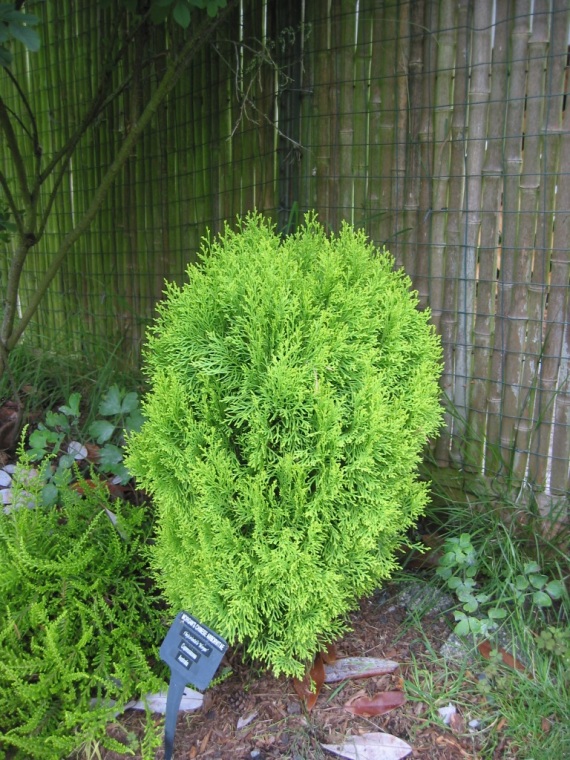
Morgan’s Chinese Arborvitae (Thuja orientalis “Morgan”)
I don’t have a clue why they call this “Chinese” since it comes from Australia, another one from the Southern Hemisphere. It’s a wonderful plant for color that turns purple in the fall, warm orange/brown in winter and then this fine lime green in summer. I had to site it in a sunny spot so it would change color. This place seems to work just fine for that.

Chirimen Hinoki False Cypress (Chamaecyparis obtusa “Chirimen”)
Chirimen is a type of crinkly kimono fabric that gives its name to this unique plant. It grows very slowly and only gets 4′ tall and not very wide, as you can see. I pruned off the inner foliage some years ago and kinda wish I hadn’t, but it still looks OK. It’s in a very shady spot and does just fine there.
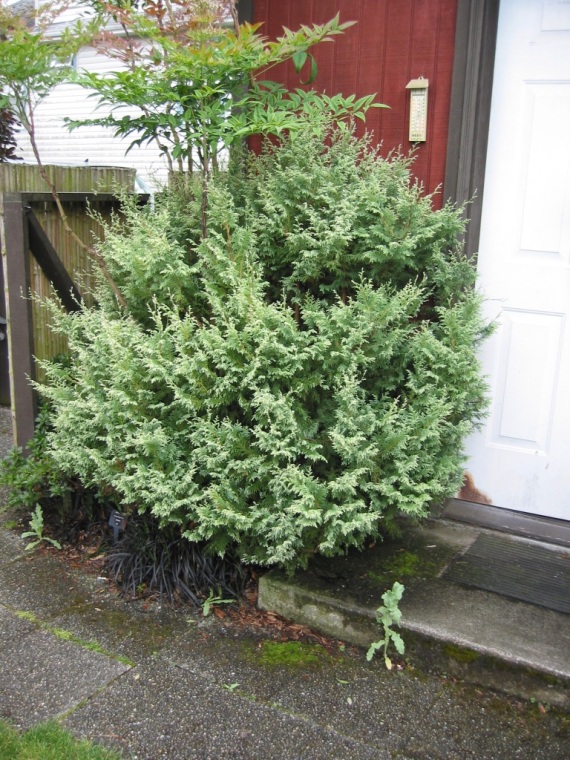
Snow Sawara False Cypress (Chamaecyparis pisifera “Snow”)
This is the same tree as the Baby Blue I showed you earlier. The tips of the plant turn this lovely whitish color as they grow, even in the full shade it’s in. The American Conifer Society tag on it said it would only get 16″ tall!! Huh?? I saw one in a botanical garden that was 4′-5′ around. I’ve had to carefully prune it so it will still fit here. Very soft and elegant.
That’s it! All the little ones. I have so many more conifers to show you, but I figured I’d limit it by size this time. As I said, none of these is supposed to get even 10′ tall, tho some come very close to that, as I’ve mentioned in the commentaries. I’m a big fan of conifers and these 22 plants are just a small sampling of all the conifers in general here in our little Nature Sanctuary. Conifers can be enjoyed all year round with their evergreen, or blue, or gold, foliage. They form the backbones of many gardens and offer a great deal of stability. I love them, as you can probably tell!
Evergreenly yours,
Steve
24
May
Posted by steven1111 in Dwarf Plants, Gardens, Sanctuaries, Trees, Unusual Plants. Tagged: Dwarf Plants, Gardens, Japanese Maples, Personal Gardens, Red Plants, Sanctuary, Unusual Plants. Leave a comment

Waterfall (Acer palmatum dissectum “Waterfall”
They say you should never prune these dissectum maples to fit a space by cutting back the edges. But since I planted it in the wrong spot and didn’t give it room to grow so I have to trim it every year. It’s a tricky dance but so far I think I’ve done a pretty good job of it. We’ll see how it looks as time goes on. It turns a brilliant shade of orange-red in the fall.

Shirazz (Acer palmatum “Shirazz”)
This one is a bit wonky looking now. It froze back very badly a couple of years ago and only the base of the trunk stayed alive. I was heartbroken, so I talked to the nursery and they said they’d never heard of a Japanese maple freezing around here. Of course it happened to me! It’s got lovely variegated foliage and turns a wonderful bright red in the fall.

Bloodgood (Acer palmatum “Bloodgood”)
This is an old variety. It’s been around for a hundred or more years. It was found in an old churchyard on the east coast. It has these wonderful dark red leaves all year and turns an even darker flush of deep reddish-purple in the fall. Truly lovely.

Red Pygmy (Acer palmatum “Red Pygmy”)
This is a dwarf variety that is only supposed to get 10 feet tall, which it is already after 10 years or so. It has dark red leaves when it first leafs out but it turns to a greenish red over the summer, before changing to a fiery orange in the fall.

Red Dragon (Acer palmatum dissectum “Red Dragon”)
Another dissectum that has deeply cut leaves and is always this incredible deep red. In the fall it turns an even darker shade of red and is very showy. It may get too big for the deck and I don’t know what I’ll do then. I’m sure something will work out.

Lion’s Head (Acer palmatum “Shishigashira”)
This is an old cultivar that has deeply crinkled leaves. In the fall it blazes with bright orange-red color. It’s a late one that opens late and stays in leaf late, well beyond the others. It’s a treat to have it here!

Twomblys’ Red Sentinel (Acer palmatum “Twombly’s Red Sentinel”)
This is our latest acquisition. We only had a space for it recently when an old arborvitae here was crushed by the February snow and we had to take it out. This is a unique one in that it’s the only Japanese maple that is columnar in its growth habit. It only gets 10 feet wide at most. It will stay this color all year and in fall will turn dark red. It’s a sport off an old Bloodgood.

Roseo Marginatum (Acer palmatum “Kagiri Nishiki”)
This is the first Japanese Maple I ever bought, back in the early 70’s, for my parent’s yard. It’s got unique leaves that are all different and have a sickle shape to them, with creamy white and pink variegation to the margins with green on the inside. Because it’s on the north side of the garage the inner leaves are shaded and are often yellow or orange as you can see here. It’ll turn a lovely orange fall color.

Floating Cloud (Acer palmatum “Ukigumo”)
This is named for its beautiful “floating cloud” effect when it’s in leaf like this. It has creamy white leaves with pink margins. It turns a deep orange-red in the fall. It really does look like it’s floating in the garden here. I love the planes of the foliage.
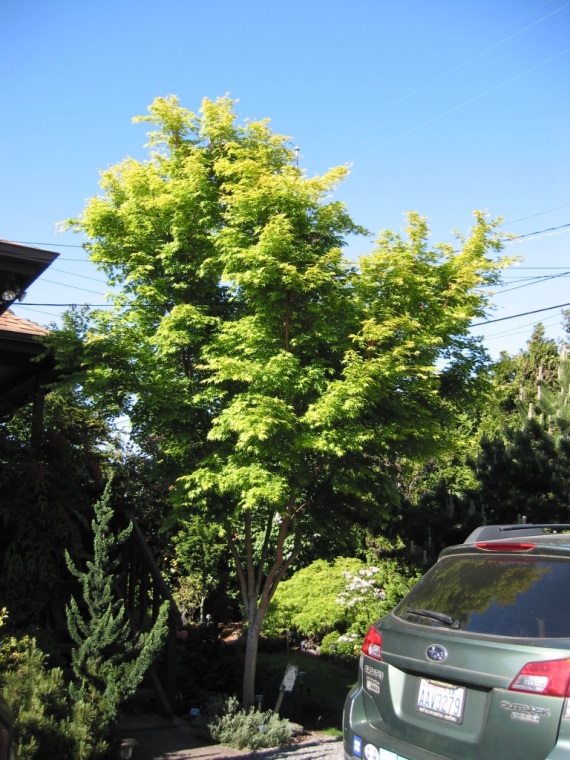
Coral Bark (Acer palmatum “Sango Kaku”)
This one is known by the new red stems you can see when the limbs are young. They’re called Coral Bark because they resemble the towers of coral rising from the sea. You can’t see the red stems now because there are too many leaves, but they’re there. You can see them when you look up into the tree. It’s the largest one we have, getting to 25 or 30 feet tall and wide. It’s a great feel to walk under it to the door.
These are all the Japanese maples we’ve got here in our little garden sanctuary. I’d love to have more but we’re out of room and are so happy to have such a nice variety in the ones we have. They’re all different in some ways so we get a large tapestry of colors and shapes and sizes. A couple of them get big but most are dwarfs and will stay small forever, or at least sort of small. Is 15 feet small to you? To a tree it is. I like them when they get taller than I am. Then they feel like a real tree to me. They all seem to grow very fast and none of these is older than about 9 or 10 years, at least in our garden. Who knows how old they were when we planted them. This is why the normal 10 year sizes they usually say on the labels are always off and much smaller than reality. You really have to just let them grow to see how big they’ll eventually get.
I hope you enjoyed this little tour of the Japanese Maples we have here. A Northwest garden would be incomplete without at least a couple of them as well as the ubiquitous rhododendrons. We have a lot of them too. Add in the ferns and conifers and you have most of our garden. It’s a unique collection of over 200 individual specimens, each different in some way from all the others. I’ve got botanical labels on all the plants so you can see their common names, botanical names, families and origins. They help me remember them all… 😉
Thanks for visiting our maple collection!
Steve
23
Apr
Posted by steven1111 in Conifers, Flowers, Gardens, Groundcovers, Shrubs, Trees. Tagged: Conifers, Dwarf Plants, Flowers, Gardens, Personal Gardens. Leave a comment

This is a view of the front of the back garden. This whole image covers a space only 20 feet wide. It’s a small garden, as I’ve said before. I know sometimes it may seem bigger because of the way I post things but in reality it’s a tiny space. This will be a real “copse” or mini forest when it grows up more. Some might say I’ve planted the trees too closely, and I probably have, but it will be wonderful to have such a splendid little forest here. I love so many trees and just don’t have room for them all, but I still try! Soon all the deciduous trees will have leaves on them and the whole area will look very different. The flowering shrubs will fade away and the conifers and other evergreens will assume dominance. But right now is the time of new growth and little buds are starting to open all over. It’s an exciting thing to watch them open and grow.

This is the same area from the side. You can see the shrubs still blooming in the background. In the front center is a beautiful patch of our native bleeding heart (Dicentra formosa). In the winter this same area is covered with the native wild ginger (Asarum caudatum) but in spring the bleeding heart covers it all and we see the lovely little heart shaped blooms. By summer they will fade and the ginger will take over again. It’s a nice trade off and makes the space look lush all year.
I hope you’re all enjoying the rebirth of Spring and the new growth all around us. It’s such a remarkable time of year. Get out and look closely at the tips of the trees and shrubs. It’s a real treat to watch them slowly open and turn into leaves and flowers and new branches. It’s a fascinating process, so do it soon so you don’t miss out on all this incredible beauty!
Loving Spring!
Steve
4
Apr
Posted by steven1111 in Conifers, Dwarf Plants, Flowers, Gardens, Greenhouses, Sanctuaries, Shrubs, Trees, Unusual Plants, Vegetables, Wildlife. Tagged: Conifers, Dwarf Plants, Flowers, Gardens, Greenhouses, Personal Gardens, Sanctuary, Unusual Plants, Vegetables, wa state dept of fish and wildlife, Water Barrels. 2 comments
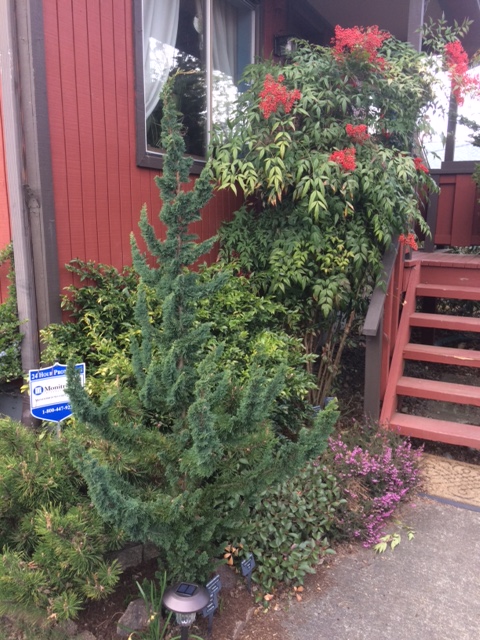
Welcome to the front entrance to our home. The tree in the center is a cultivar of the Port Orford Cedar, or Lawson Cypress, called “Wissel’s Saguaro”, due to its branches sticking out like the arms of a Saguaro cactus. An interesting creature to greet our visitors. The shrub with the red berries behind it is a large Nandina domestica “Moyer’s Red”.

Entering the front garden. There used to be a large Arborvitae shrub where all the small plants on the left are now. It was some 8′ across and 7′ tall. That was until the snow hit in February and crushed the life out of the center of it. We had to remove the whole plant (tons of work!) and replace it with a new collection of wonderful plants. We lost our privacy but gained a new view of the garden entrance. It feels very welcoming now as you enter under the arch formed by the Japanese maple on the left and the Oregon Green Pine on the right. The wonky looking sign in front is from the Washington State Dept. of Fish and Wildlife, designating us as a Backyard Wildlife Sanctuary. We welcome many wild creatures here.

Taking the next steps into the garden. On the left you can just see a very fragrant Winter Daphne, and on the right is a gorgeous PJM Regal Rhododendron in full bloom. The bench is a fine place to sit and read or just view the garden.
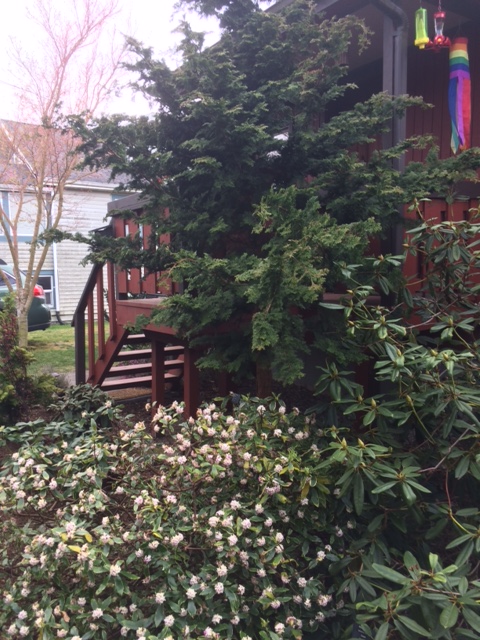
A better view of the Daphne, with a species Hinoki Cypress over it. The tree will get large in time and provide a nice sheltered corner for the front porch. At the right is a large Sappho Rhododendron waiting to bloom. The hanging items are a hummingbird feeder, a wasp trap and our rainbow wind sock. More food for the birds and safety and beauty for us.

Sitting on the bench and looking back at the entrance to the garden. The large deciduous tree on the right is a Sango Kaku Japanese maple and the conifer on the left is the Oregon Green Pine. You can see a bit of the arch they create together. The large shrub in front of the bench is a Mr. Bowling Ball arborvitae. It has very interesting foliage and cool winter color.

The stone path leading to the back garden. On the left is a small Weeping White Spruce we put in to replace the large Blue Spruce we removed last fall because it was going to get too big. A sad loss but it’ll save us heartache in years to come. The hedge on the right is deciduous and just greening up. It’s been here for over 40 years and it’s still going strong!

Entering the back garden from the path by the house. The walk is covered with several inches of bark to keep it clean and attractive. Nothing will grow there because it’s too shady. Oh the left you can just see the light lavender flowers of the Rhododendron cilpenense and a bit of a red Unryu camellia. The small Magnolia on the right suffered greatly in the snow and will never be the same. But I staked it up a lot and it will recover at least somewhat. Much patience will be required!

A view of the center of the back garden. You can’t see the trees too well because they’re still dormant. They’ll look much more lush in a few weeks. Sorry it’s so dark here – it was an overcast day, as is common in April here in Seattle.
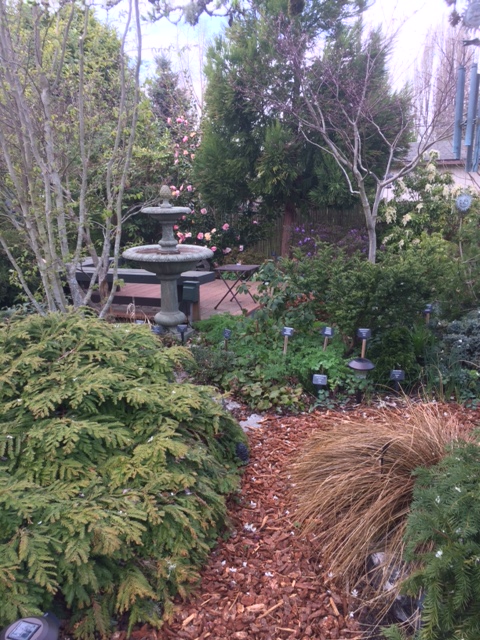
The center from a side view. The large shrub on the left is a dwarf Coast Redwood called “Kelley’s Prostrate” that only grows to 2 feet tall and about 7 feet wide, so far. The species gets a huge 360 feet tall. It’s so nice to have the redwood foliage here in our small garden that could never accommodate the larger species tree. The fountain gives us hours of pleasure listening to its gentle sounds, much like a small creek or stream. Imagination does wonders when your eyes are closed!

Looking into the side of the garden a bit further down from the last shot. The small pink flowers on the right belong to a “Howard McMinn” Manzanita, and the bright pink one on the lower left is a “Kramer’s Rote” heath. Above the heath is a small Lily of the Valley shrub and at the back is a large “Pink Icicle” camellia just coming into bloom.

You’ll see this as you walk the path I showed in the last photo. The tree in the back is a “Wintergreen” Japanese Umbrella Pine, which also took a hit in the snow. All these branches used to stand straight up. Now they’re all wonky. I doubt they’ll pull themselves back up, but ya never know. I’ll give it time before I do any corrective pruning. On the right you can just see the trunk of a contorted Japanese Larch called Diana. The branches twist and turn most interestingly. It’s been leafing out for a month now with its small bright apple-green needles. I’ll do a post on it someday.

This is taken from the same spot as the last one only turned a bit to the right. You can see the camellia and the cool lantern we had made for us out of wrought iron. It helps light up the small deck you can see below it. In the back is a large Radicans cryptomeria which will dominate the area in years to come.

A few more steps bring us to this shot of the deck, with the lawn and the house in the background. This little deck is a sweet place to hang out and read or just listen to the sounds of the fountain next to it (you can’t see it here). The upper deck by the house is a great place to spend some time sunbathing in private, and is a good place to have company over for cookouts.

Full circle – this is a shot of the walkway we entered the back garden through. The bare tree on the left is an “Eddie’s White Wonder” dogwood just about to burst into bloom. It got Anthracnose last year so we’re spraying it with Neem oil every week or so to try to eradicate it. It won’t kill the tree but it looks terrible as the summer progresses. I hope we can kill it off!

Here we circle back to the inner yard to see the veggie gardens and the greenhouse on your left. The water barrel gives us enough to water the greenhouse most of the year, except in summer when it doesn’t rain. (Yes, we have Very dry summers here!)

A closer view of the greenhouse. You can see the seed starting bed on the left with its plastic cover that holds in the moisture and heat to help the seeds germinate. I put the curtain over the lower part of the door so I can go out and work in the greenhouse naked without spooking the neighbors. I do it outdoors too when they’re all gone. More on that later on!

Here’s one of the veggie gardens. We planted the trees and heathers along the north end to tie the beds to the other parts of the garden. We lost some planting space but still have plenty of room for many crops. The bees love the heather flowers and they help pollinate the garden. We grew enough onions and carrots last year that we’re still eating them today. It’s so yummy to grow your own food. We even have some Kale that overwintered in the back by the fence. Sweet and tasty!

This is the last shot. It shows how the veggie gardens and the ornamental ones merge with the path through the lawn between them. We have gates on all sides of the garden to be able to visit the neighbors. So far we’ve had good ones, though we’re waiting to see who buys the house next door. They all help make this a great neighborhood to live in!
So that’s the tour. Sorry it was an overcast day, but I hope the photos came out well enough for you to see what I was hoping to show you. It’s an exciting time in the garden now with so many plants bursting with their new spring blossoms and others just breaking dormancy and starting to leaf out. It’ll all look so different in a few weeks as the trees put on their new summer leaves and the other plants continue to bloom. It’s such a joy to be in a garden in the Spring!
May your own gardens grow bountifully!
Steve
25
Mar
Posted by steven1111 in Dwarf Plants, Flowers, Gardens, Groundcovers, Shrubs, Unusual Plants. Tagged: Dwarf Plants, Flowers, Gardens, Personal Gardens, Unusual Plants. Leave a comment

Pieris japonica “Little Heath”
This is one of the first flowers to show up in early January. It’ll bloom for two or three months with its small urn shaped flowers so typical of the Heather family – the Ericacea. It has lovely little variegated leaves that come out a nice pink a bit later. It’s supposed to be a “dwarf”, but it’s over 6′ tall and 4′ wide now and I think it’ll get even bigger. A lovely plant and so nice to see it’s flowers so early in the year.

Helleborus orientalis “Mardi Gras Pink” – Lenten Rose
This is another early bloomer that is no doubt familiar to most of you. It’s named Lenten Rose because it blooms at Lent, obviously. It tends to hold its flowers downward so you almost have to crawl under it to see them.

Iris reticulata
This little gem was blooming in February when we had the big snow I showed you in the last post. It’s a dainty thing but it came thru 12″ of snow without a blemish or a crushed petal. They’ve started to naturalize here in this spot and have come up for 3 years now and are forming bigger clumps each year.

Erica carnea “Springwood White”
This little ground cover is a Heath, which started blooming back in December and is still going strong. It will spread out to cover this whole area in time and it even blooms well in the shade of the Metasequoia above it. It also has the little bell shaped flowers typical of the Heather family.

Erica x darleyensis “Kramer’s Rote”
This is another early blooming heath called Kramer’s Rote. It’s been here for about 9 years now and has taken over part of the path so I have to keep it pruned back a bit so we can walk thru. I love the deep rose color. We can see it from the house, which is a joy when the weather is bad and we can’t go out to look at the garden more closely.

Pieris japonica “Mountain Fire”
Another Lily of the Valley shrub. This usually has more flowers, and I’m not sure why it’s not covered with them this year. It’s still lovely and gives us early flowers like it’s smaller cousin, the Little Heath. The new foliage is a bright mahogany red which is why it’s called Mountain Fire.

Tete a Tete Daffodils
These little wonders are right by the front walk into the house, so everyone can see them when they visit us. They also have naturalized here over the last 3 years and come up faithfully each spring. You have to get down low to really see them but they’re still pretty when you walk by.

Bluebells
I suspect everyone knows these cute little flowers. I’ve seen them take over large areas and it’s amazing to see them like that. These are just tucked away near a couple of conifers and don’t have room to spread but they also have naturalized and come back every year. I love blue flowers so I treasure them, even tho they’re so common.

Arctostaphyllos densiflora “Howard McMinn”
This is a wonderful small Manzanita that is native to the California coast. The flowers are so tiny it’s hard to see them I know, but they are very fragrant and are formed with the same urn shape as the other Heather family members. The bark is a notable feature on this plant. It’s a dark reddish brown and also grows in an interesting, gnarly shape.

Daphne odora “Marginata”
Talk about smells! This is one of the strongest smelling plants I know of. You can smell its sweet fragrance all over the front yard, even out to the driveway and up on the front porch. It got a bit clobbered by the big snow last month and I had to do some major corrective pruning, but it came out fine and is blooming as beautifully as it always does. The smell is truly intoxicating, especially when you stick your nose deep into a flower cluster!
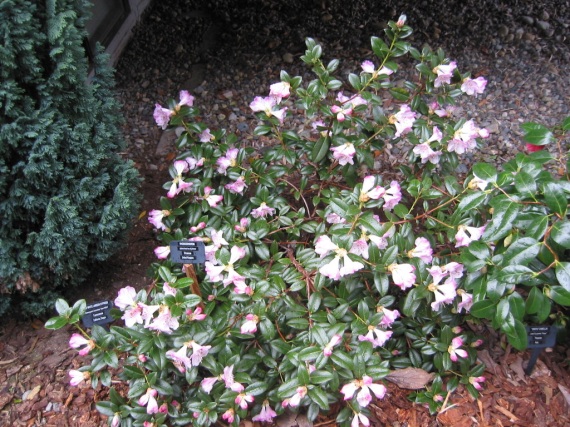
Rhododendron “Cilpinense Pink”
This is one of my favorite Rhodies, and the first to bloom in our garden. The lovely light lavender rose flowers are blooming profusely now, and contrast nicely with the blue Lawson Cypress next to it. Last year there was a deep freeze when the buds were still closed and it killed them all, so we had no blooms whatsoever. I covered it with a burlap sack when we had cold weather this year and it did fine.
There are more plants slowly coming into bloom but I wanted to share a few of these early ones for those of you still snowed in and waiting for signs of spring. We’re lucky here in Seattle to have such a mild climate where Rhodies and other Heather family members can thrive and give us such stunning blooms each spring. The winter was generally kind to us and we were even able to do some gardening during the easier times. But the snow was hard on many of our plants. Thankfully they seem to be coming back well, and will bloom as the spring and summer progress.
Hope you enjoyed this little touch of early spring!
Steve
9
Feb
Posted by steven1111 in Conifers, Dwarf Plants, Gardens, Nature, Snow, Trees, Unusual Plants. Tagged: Conifers, Dwarf Plants, Gardens, Japanese Maples, Nature, Personal Gardens, Snow, Unusual Plants. 4 comments

The Back Garden

From the Street
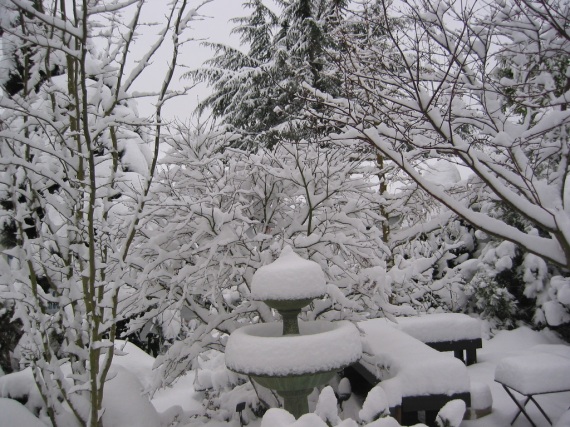
The Fountain with Red Pygmy Japanese Maple behind

Tuscan Blue Rosemary

Waterfall Dissectum Japanese Maple
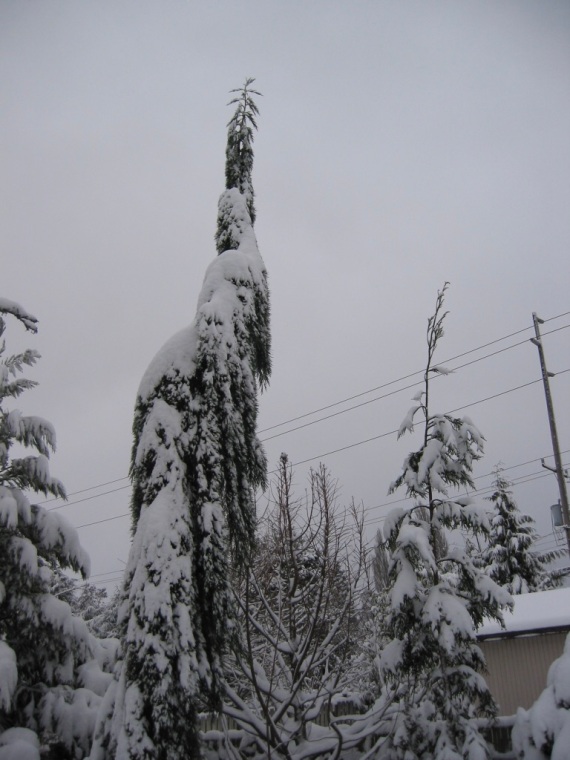
Weeping Giant Sequoia, Dwarf Swamp Cypress, Rasen Cryptomeria

Cryptomeria Radicans
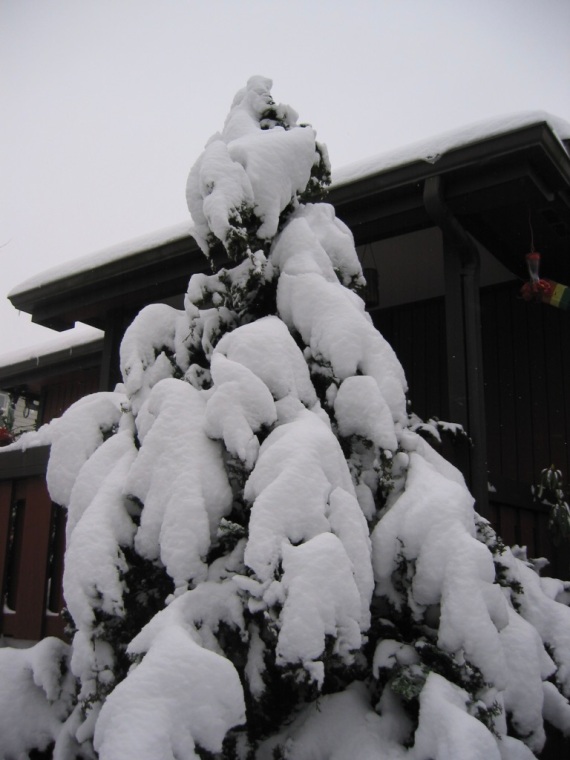
Hinoki Cypress

Metasequoia Miss Grace, Ginkgo Jade Butterflies

Maupin Glow Incense Cedar

Sango-Kaku Japanese Maple

Ginkgo, Cryptomeria Elegans

Charity Mahonia (so sad…)
It rarely snows this much in Seattle. But today we have over 10″ here in our garden. Not bad by Midwestern or East Coast standards, but here in Washington the Governor called a State of Emergency because it’s so bad all over the state. I bravely (!!??) ventured out to take some photos before the wind blew all the snow off – it won’t melt for days because more snow is predicted for today and for the next week or so. We’re glad the power and water are still on, and we’re well stocked with food and drink, and have generators and even extra water. (We’re trying to be prepared for the Big One that’s going to hit the PNW one day, hopefully not in our lifetimes!!)
Most of the plants will recover from the snow when it melts, but the last picture of the Mahonia shows a plant in serious distress. I tried to pull it back up but it’s frozen in this position. We may lose it, as well as the huge Winter Daphne in the front yard. It’ll be hard to lose either one of them, and both at once will make me crazy. But you can’t control the weather as all gardeners know. I guess we’ll just have to grin and bear it. After all it’s not bad here compared to how it could be. At least it’s only in the 20’s and teens, not below zero! We know we got it good….
Hope everyone dealing with snow is doing OK, and not freezing their butts off! Stay safe!
Steve
16
Jan
Posted by steven1111 in Conifers, Dwarf Plants, Gardens, Nature, Peat Bogs, Sanctuaries, Shrubs, Trees, Unusual Plants. Tagged: Conifers, Dwarf Plants, Gardens, Nature, Peat Bogs, Personal Gardens, Sanctuary, Unusual Plants. Leave a comment

We’re starting in the very front of our garden this time – on the street. We always think we’ve done all the planting we can, then we come up with more ideas. Here we’ve planted a new mixed border of Lime Marmalade Coral Bells (Heuchera “Lime Marmalade”) in with a bunch of Black Mondo Grass (Ophiopogon planiscapus “Nigrescens”). I know the black of the mondo grass is hard to see but it’s there in amongst the yellow. See the bright red stems at the end? That’s a Pacific Fire Vine Maple (Acer circinatum “Pacific Fire”). It stands out nicely from the Oregon grape (Mahonia aquifolium) surrounding it and the David’s Viburnum (Viburnum davidii) below it.

Next we move to the front entrance to the house. This Heavenly Bamboo Nandina domestica “Moyer’s Red”) is loaded with berries at this time of the year. It’s nice to have them to augment the decorations we put up for Solstice. Next to it, and barely visible, is a Himalayan Sweet Box (Sarcococca ruscifolia) that is so sweetly scented right now you can smell it from several yards away. The two together are a colorful and fragrant way to greet visitors at this rather bleak season of the year.

Here’s another scenario we didn’t at first envision. There used to be a largish Goshiki osmanthus (Osmanthus heterophyllus “Goshiki”) and another Sweet Box here, but they were both outgrowing their spaces so I removed them (shocking I know!!!) and replaced them with a couple of different dwarf conifers we had on the deck in pots. In front is a Mr. Bowling Ball Arborvitae (Thuja occidentalis “Bobozam”) with its yellowish winter color, and a Grune Kugel Western Red Cedar (Thuja plicata “Grune Kugel”) (Green ball in German). It’s also got some subtle colors to it now. To the left is a purple PJM Regal Rhododendron (Rhododendron “PJM Regal”) I moved from next to the Dissectum Japanese Maple you can see in the middle spreading its arms out towards the lawn. I just moved it across the path to the birdfeeder but it still does a fine job of keeping the birds safe from our resident hawk. In the middle of the conifers is a dormant Lion’s Head Japanese Maple (Acer palmatum “Shishigashira”). It was a glorious reddish orange not too long ago, but now you can see its fine structure more clearly.

I was standing next to this Korean Butterfly Maple (Acer tschnoskii ssp. “Koreanum”) when I took the last picture. In fact you can see Mr. Bowing Ball in the foreground. This is the first maple to leaf out in spring and the first to lose its leaves in fall. That’s after they turn a striking reddish orange that lights up that part of the yard. And now when you sit on the bench you can see thru the whole front yard, whereas before the Osmanthus and the Sweet Box blocked the view. That’s part of why I took them out, besides their size.

We’re into the back yard now, by the side gate that goes to the driveway. This is a Purple leaved Weeping Copper Beech (Fagus sylvatica “Purpurea Pendula”). This is the time to see the fascinating structure of this tree. My plan is to slowly train it up over the gate, but that will take years and years of growth. We’ll see how it goes.

I took this picture of the North side of the back garden a few steps away from the Beech. This is when the conifers shine. On the right of the conifer line is an Inverleith Scots Pine (Pinus sylvatica “Inverleith”). Its bluish foliage contrasts nicely with the bright yellow of the Golden Spire Western Red Cedar (Thuja plicata “Daniellow”) next to it. That one goes well with the Black Dragon Sugi (Cryptomeria japonica “Black Dragon”) to its left. Its dark foliage gets even darker in age. The skinny weird one to its left is another Sugi – a Rasen (Cryptomeria japonica “Rasen”), which means barber pole in Japanese, no doubt because of its thin and twisted form, and its needles that grow all around the stem, even on the trunk. It’s fascinating to get close to it. On the far left is a bit of a Weeping Giant Sequoia (Sequoiadendron giganteum “Pendulum”). It’s gotten to be around 30′ tall, after about 9 years of growth. It’s fast!!

Next we jump over to the South end of the yard, where the veggie garden is. This is another bit of new planting. We put in a line of conifers along the edge of the growing beds, with Scotch Heathers in between them. They make a nice avenue of trees and shrubs to separate the ornamental from the vegetable garden, and also connect the garden across the lawn. The first tree is a Golden Italian Cypress (Cupressus sempervirens “Swane’s Golden”), found in Australia in a nursery there. 30′ x 3′ in time. In the next bed is a small growing hybrid yew. It’s called Beanpole (Taxus X media “Beanpole”) and grows slowly but very tightly. It only gets a foot or so wide. It’s a cross between the Japanese and English Yews. You may have a hard time seeing the next two. First is a bluish Spaan’s Slow Column Scots Pine (Pinus sylvestris “Spaan’s Slow Column”), another tight grower, but short, to 12′ or so (maybe 30′??) To its left is a tall narrow form of Lawson Cypress called Filip’s Tearfull (Chamaecyparis Lawsoniana “Filips’ Tearfull”). It may get 20 – 40′ tall and 3′ or so wide some day – long after we’re gone I suspect. At the end is a Skyrocket Juniper (Juniperus scopularum “Skyrocket”). It’s been there for a few years already. All of them form a nice break and connection between the two sides of the garden.

On the other side of the lawn are these two prehistoric specimens. Both are ancient trees. On the left is a Miss Grace Dawn Redwood (Metasequoia glyptostroboides “Miss Grace”) and to its right a Jade Butterflies Ginkgo (Ginkgo biloba “Jade Butterflies”). They have strikingly different forms but it’s a nice contrast to see them together. The Dawn Redwood in particular looks ancient already, especially when it’s bare like this.
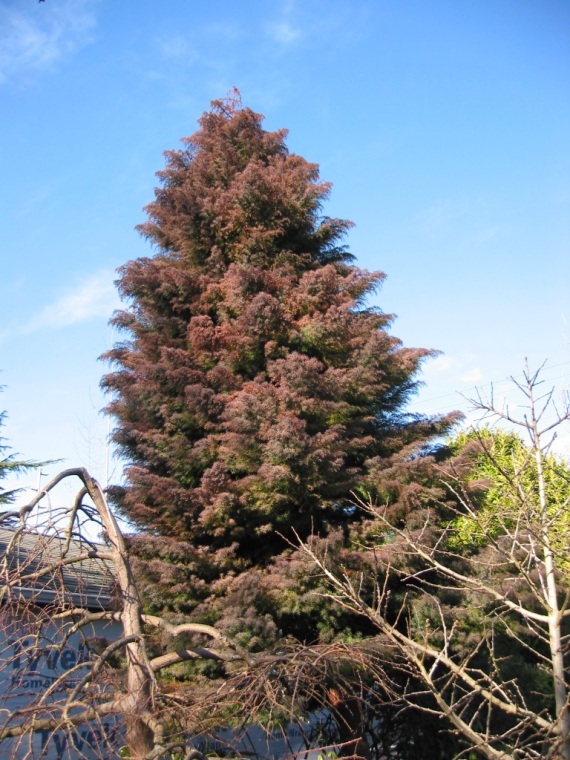
Above the last two trees is this lovely one. It’s another Sugi (I l love them – there are hundreds of cultivars!!). This one is called Elegans (Cryptomeria japonica “Elegans”) and turns this incredible shade of purple in winter. It’s a feathery deep green the rest of the year. It’s one of my “pettable” trees because the needles are so soft to the touch. You can literally pet them and not get stuck, like you do with most conifers. A very cool and fast growing tree.

I took a similar picture to this one a little while ago in a post called “The Heart of the Garden”. This is that heart when the leaves are gone. It’s a very different scene. In the left foreground you can see the Kelley’s Prostrate Coast Redwood (Sequoia sempervirens “Kelley’s Prostrate”). It’s now about 2 1/2′ tall and 8′ wide. Very small for a Redwood but big for a dwarf. Above it the vase shaped tree is a Vanessa Persian Ironwood (Parrotia persica “Vanessa”). It’s far more narrow than the species but it’ll still get pretty wide in this space. Careful pruning will be required at some point in the future. There’s a Bloodgood Japanese Maple here too and a Helmond’s Pillar Japanese Barberry. Both are out of leaf and hard to see, but in the summer they’re both lovely shades of purple. I love to have colored plants in the garden. They’re like “flowers”, so to speak. They liven the garden up wonderfully.

To the left of the last scene is this Contorted Japanese Larch (Larix kaempferi “Diana”) with its spindly twisted branches. You can really see them now that it’s lost its needles. It’s a deciduous conifer – like the Metasequoia and the Ginkgo are. Rarities in nature but fun to have in the garden. I have one more – a Taxodium – the Bald Cypress of the swamps of the SE United States.

This is the final shot. It’s of the entire back garden. You can see how different it is with all the leaves gone. I planted the whole center of the garden with deciduous trees and the outer ring with conifers to back them all. It’s a great effect to be in the middle of a bare garden with lush greenery all around you. And in the summer it’s like a little forest to be in there now that the trees have grown so much. I’m amazed at how well all the plants have grown here, but then we’re in a peat bog and have deep dark rich soil that the acid loving trees and shrubs we’ve planted just love. We feel very fortunate to live with this wonderful little Nature Sanctuary all around us every day. Gardening is healing to the soul, and I need that very much. It may seem like I take care of this garden, but in reality it takes care of me…
Happy Winter,
Steve
1
Dec
Posted by steven1111 in Dwarf Plants, Gardening, Gardens, Grasses, Groundcovers, Unusual Plants. Tagged: Dwarf Plants, Gardens, Japanese Forest Grass, Personal Gardens, Unusual Plants. Leave a comment

This is one of the last plants in the garden to have great fall color. I showed you most of our other ones in my last post. It’s a luscious light green in summer but in fall it turns this spectacular golden shade. It really stands out in the garden now that all the trees around it have lost their leaves and all we see are their bare branches. It always provides a lush presence in the garden but I especially love it when it gives us this bright spot of color in an otherwise green understory beneath a stark upper landscape and a drab sky. It’s surrounded by Rhododendrons and ferns and normally blends in well with them all, but now it’s a striking contrast to them. The leaves hang on for several months as they gently fade in color and eventually meld into the surrounding soil.

I struggled to grow this plant for some time until I finally put it in the right location. It’s in deep shade underneath our Red Pygmy Japanese maple, as you can see in the first photo, and below the fountain as you can see in the second one. Once I grew it there it just took off. Funny how that works, isn’t it? It’s supposed to grow into a 1′-2′ mound and ours has gotten about that big now. Japanese Forest Grass (Hakonechloa macra “All Gold”) has an appropriate varietal name of All Gold based on what we see at this time of year. I planted it in this spot about 5 years ago, so it’s not particularly fast growing, but it will show off its delicate beauty for years to come.
Happy Autumn!
Steve
9
Nov
Posted by steven1111 in Dwarf Plants, Gardens, Nature, Sanctuaries, Shrubs, Trees, Unusual Plants. Tagged: Dwarf Plants, Fall Color, Gardens, Japanese Maples, Personal Gardens, Sanctuary, Unusual Plants. 2 comments

Acer palmatum dissectum “Red Dragon”

Ginkgo biloba “Jade Butterflies”

Acer palmatum “Sango-Kaku”

Cryptomeria japonica “Elegans”

Acer palmatum “Bloodgood”

Acer palmatum dissectum “Waterfall”

Vaccinium corymbosum

Asparagus officianalis

Acer palmatum “Shirazz”

Acer palmatum “Red Pygmy”

Cornus florida x nuttallii “Eddie’s White Wonder”
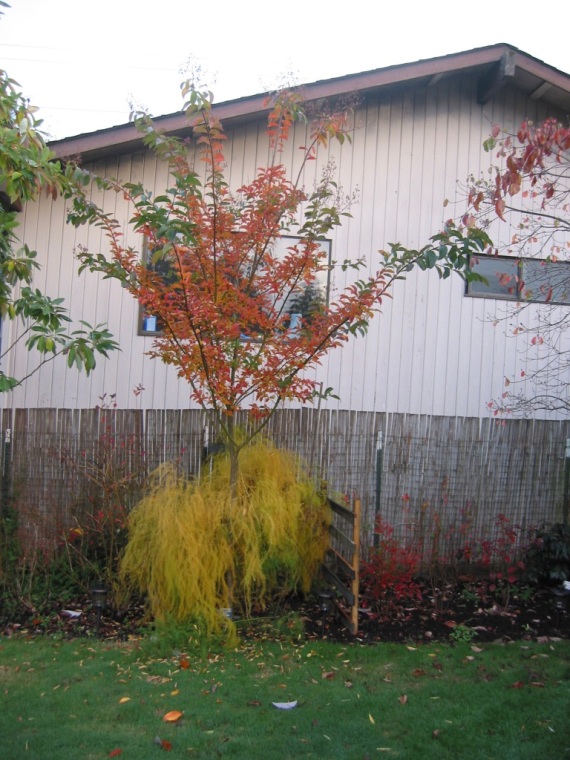
Lagerstroemia indica x fauriei “Muskogee”

Acer palmatum “Goshiki Kotohime”

Parrotia persica “Vanessa”

Fagus sylvatica “Purpurea Pendula”
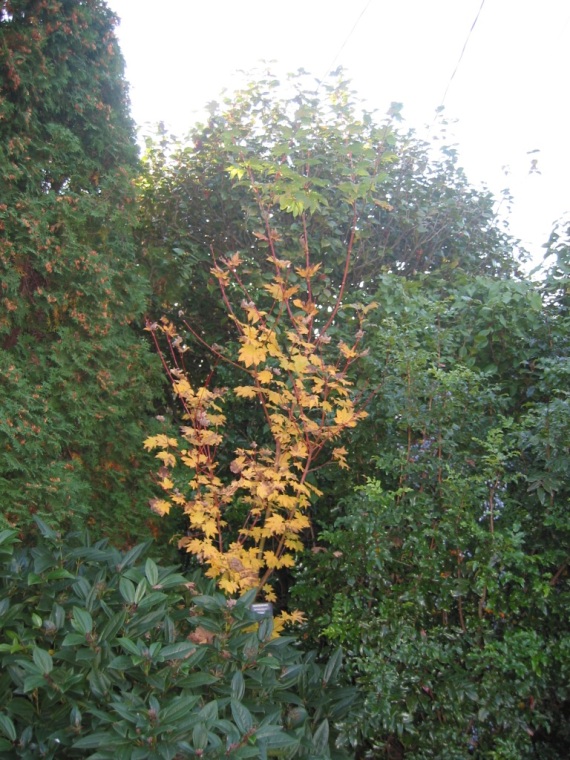
Acer circinatum “Pacific Fire”

Acer tschonoskii ssp. “Koreanum”

Rhododendron “PJM Regal”

Larix kaempferi “Diana”

Metasequoia glyptostroboides “Miss Grace”
I didn’t realize just how many plants we had here in our little Nature Sanctuary that turned lovely fall colors until I started doing this post today. I know when I’ve gone into the garden for the last few months there have always been new plants that had changed to their amazing colors so I guess I shouldn’t have been surprised. They have been changing since late August and early September and are still doing so, with some still just beginning to turn now.
Most of these are deciduous dwarf trees, but a couple are evergreens that change color in the winter cold. I also included a couple of unusual plants for color – like the blueberries and asparagus. I don’t think most people think of these plants for fall color, but to me they’re beautiful. I’ve listed them all by their botanical names so they can be correctly identified, but you can easily find the common names with a little research on the internet.
I’m always amazed by autumn colors, but this year has been spectacular here in the Pacific Northwest. Not only did all the trees here in Seattle turn incredible colors, but the ones on the east side of the Cascades did as well. Driving over to my land in the Okanogan Highlands in Eastern Washington we saw striking colors on the vine maples, creek dogwoods, cottonwoods, aspens and many others, including shrubs. Probably the best show I’ve seen in my 35 years of traveling over the mountains to my land. We were impressed, to say the least.
The changes in color are the result of the loss of the green chlorophyll in the leaves of plants leaving the underlying pigments of red, yellow, orange, purple and blends of them all. The weather affects them too and this year has been very dry here so I think that helped increase the depths of color we’re seeing. They shine from within and cause your stomach to drop and make you weak in the knees. At least they do that to me! This effect is especially potent around dusk, and I’ve included a couple of pictures I took at that time. The flash highlights just how deep the colors glow from inside the leaves.
Walking thru the garden this fall has been so delightful, as so many of the trees in the the back of the yard turn some shade of yellow-orange-red, though they’re all a bit different. It’s almost spooky to walk amongst them at this time. You feel like you’re in some surreal landscape of color and texture. It makes me catch my breath with wonderment. I love fall, perhaps because my birthday is now – this Sunday in fact, so I came into the world at this time and it’s deep in my soul. At least that’s what I think anyway….
I hope that the plants where you live are also giving you as much pleasure as they’re giving me, as they turn their remarkable colors and give us some of nature’s finest shows. We’re lucky to see this and I’m so grateful for all the trees that offer us this brilliant and wondrous experience.
Fall Color rocks our world!
Steve
8
Oct
Posted by steven1111 in Conifers, Dwarf Plants, Ferns, Flowers, Garden Construction, Gardens, Groundcovers, Nature, Sanctuaries, Shrubs, Trees, Unusual Plants. Tagged: Conifers, Dwarf Plants, Ferns, Gardens, Japanese Maples, Nature, Personal Gardens, Sanctuary, Unusual Plants. Leave a comment

This fountain is in the approximate geographical center of our little Garden Sanctuary. But it’s more than that. As a water element it’s truly the heart of the garden – what else could that be but water? It’s the life force that the plants need most to survive and thrive, as do we. This is a bit of a shrine to those water energies. It also serves as a focal point to draw all the disparate elements of the garden together. Its gentle babbling sounds are just like a small stream in the forest, which this area is slowly becoming, tho a small forest I’ll admit.
We like to sit on the deck behind it and read or just sit and visit. It’s lovely to have the fountain as a backdrop to our conversations. It’s a very peaceful and calming place to be. It’s one of my favorite spots in the garden, for all these reasons, and more. Water has always been special to me and I love to hear its gentle sounds. It’s so healing to just hang out here and allow yourself to fall under its spell for awhile. There’s a small stone path that leads to the fountain. I stand there and just appreciate all the beauty.
In effect we’ve created a little grotto here and it’s filled with all sorts of cool plants to enhance that feeling of being enclosed in a small private space. The plants around it, in spiral fashion radiating out from the left hand corner are: a purple leaved Helmond’s Pillar Japanese Barberry next to the straight stems of a relatively fastigiate form of the Persian Ironwood tree named Vanessa. There is a Japanese Tassel Fern at its base and small Alpine Water Ferns covering the floor all around it. Behind these and above the ferns is a Red Tip Alpine Yew Pine, with a Ken Janeck Rhododendron at its foot.
Right behind the fountain is a Red Pygmy Japanese maple, with a lush stand of Japanese Forest Grass right below it. In back and to the right of it are a few branches of a Diana Japanese Larch that is just starting to turn golden. The whorled plant next to it in back is a Japanese Umbrella Pine cultivar called Wintergreen. To its right is an Anna Rose Whitney Rhododendron with a bit of the Radicans Sugi showing to the right of it. The red tree is a Bloodgood Japanese Maple and the evergreen at its base is an Amersfoort English (some say Japanese) Yew. The ground cover in the middle is our native Wild Ginger, while the whitish plant in the foreground is Euonymous Emerald Gaiety.
There are still a few more plants you can’t see, like a Bow Bells Rhododendron, and a small Lawrence Crocker Daphne. Near it is another beautiful small fern – the Dwarf Crisped Golden Scale Male Fern – a huge name for a 12″ plant! You can’t see the Western Bleeding Heart that comes up every spring because it’s dormant now, tho it fills the area in front quite well then. There are also some areas of white flowered Sweet Woodruff here and there. There’s a tiny patch of Victor Reite Thrift and on the left is an imposing Kelley’s Prostrate Coast Redwood that creates a large part of the feeling of enclosure. And finally there’s a wispy Toffee Twist Sedge at the base of the Barberry.
I haven’t listed any botanical names this time in the interests of brevity, which I seem to have failed at anyway. Oh well, I know I do ramble on about plants, but I get so excited about them all I can’t seem to help myself. I’m a little manic about them I guess. I love to know their names. It makes me feel closer to them as friends. I like to just hang out in this grotto and meditate on the gentler aspects of a garden. It’s a good place to do that because the energies of the plants and the water are so strong here. You definitely feel it all surround you and know they are the ones who own this little Sanctuary, not you. It can be a humbling experience if you let it be…
peace,
Steve
29
Sep
Posted by steven1111 in Conifers, Dwarf Plants, Gardens, Nature, Parks, Sanctuaries, Trees, Unusual Plants. Tagged: Conifers, Dwarf Plants, Gardens, Giant Redwoods, National Parks, Personal Gardens, Unusual Plants. Leave a comment

12/2009 – at planting

5/2011 – after one year’s growth

11/2012 – tied up to keep it straight

11/2013 – wonky top develops

4/2014 – another view
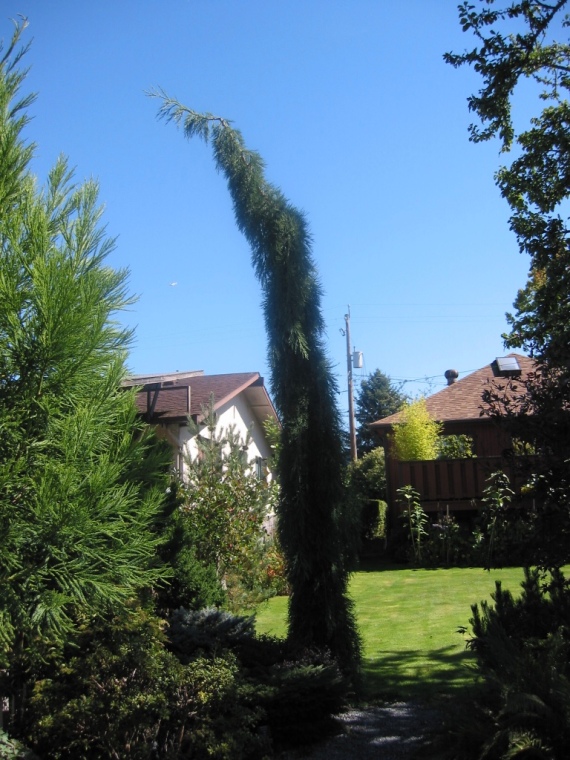
9/2015 – bending over a bit

7/2016 – heading north

10/2017 – lots of bends in it
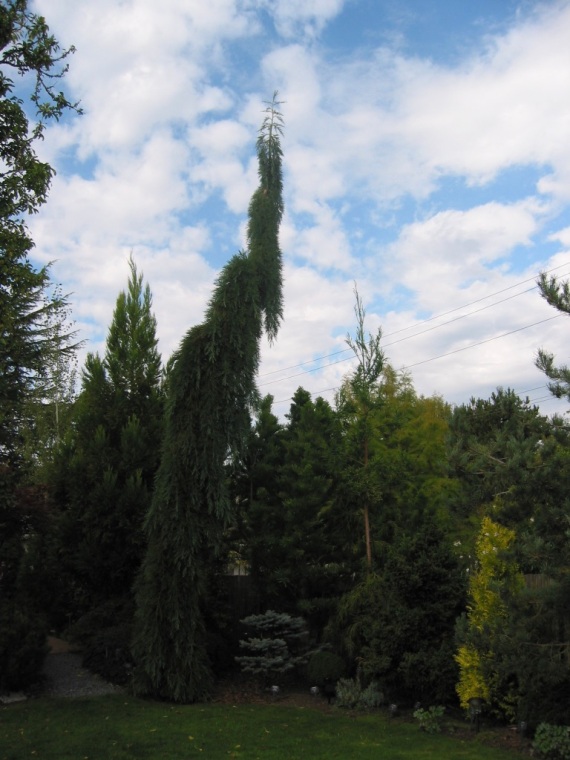
9/2018 – going up straight again, sort of

9/2018 – from the ground up
This is a cultivar of the largest tree in the world – the Big Tree, Giant Sequoia, Sierra Redwood, or Wellingtonia – many names for one amazing tree. It can grow over 350 feet tall with a girth of over 30′. Wow… This version is a smaller “dwarf” that only grows up to 35 or 40 feet tall. The tree near it in the next to last photo I recently measured at 22′, so the Sequoiadendron must be close to 30′ or more now. It’s so hard to tell from the ground without surveyors tools. I especially like the last photo which I took standing at the base of the tree looking up. It’s sort of a Jack in the Beanstalk picture to me. Imagine climbing up it! Pretty awesome.
These trees are native to a small area of the Sierra Nevada mountains in central California. There are only a few groves of Giant Redwoods left and they are protected in National Parks or Sanctuaries now, tho in the past they logged them, if you can believe the nerve!! They were so big that they shattered when they fell so they eventually gave up on that, tho they cut down far too many. Personally I think that logging old growth trees, of any kind, should be a crime – seriously. There aren’t many of these giants left and once they’re gone they’re gone forever, or for several thousand years anyway. I’ve loved these Redwoods since I was a kid and my family visited them for picnics in the Sierras near where we lived. They’re my friends, so to cut them down and kill them is murder in my book. Just my personal opinion…
This cultivar was found in a garden in France around 1863. They’re now growing all over the world in temperate climate zones, and are considered one of natures unique oddities. They are often referred to as Ghost Trees because they look so otherworldly in the fog and give the impression of some spook. It’s pretty cool to see a grove of them!
As you can see it grows really fast. It only has 9 years of growth on it so far and it’s gotten this big. I apparently didn’t take too many photos of it when it was young, unfortunately, but I have enough to give you an idea of how it develops. This one is pretty straight but many twist and turn back on themselves in all manner of directions. I had to tie this one to the plum tree near it to keep it somewhat straight and off the path next to it. But it curves as it will and it once headed into the neighbors yard but is now coming back into ours. People always comment on this tree when they visit our garden, and I’m very pleased with it. It’s kinda quirky, like I am. It suits me. 🙂
Save the Redwoods!!
Steve
2
Jul
Posted by steven1111 in Conifers, Dwarf Plants, Gardening, Gardens, Trees, Unusual Plants. Tagged: Dwarf Plants, Gardening, Gardens, Personal Gardens, swamp cypress, Unusual Plants. 2 comments
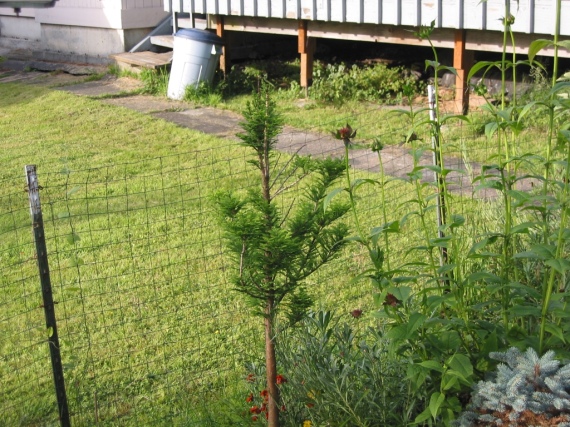
7/9/2011

8/23/2012
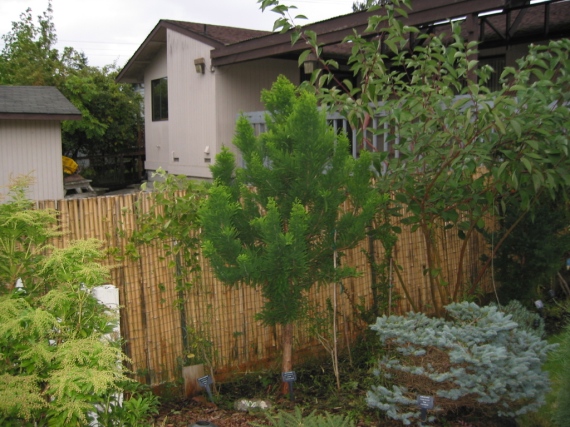
9/16/2013

8/13/2014

9/10/2015

7/18/2016
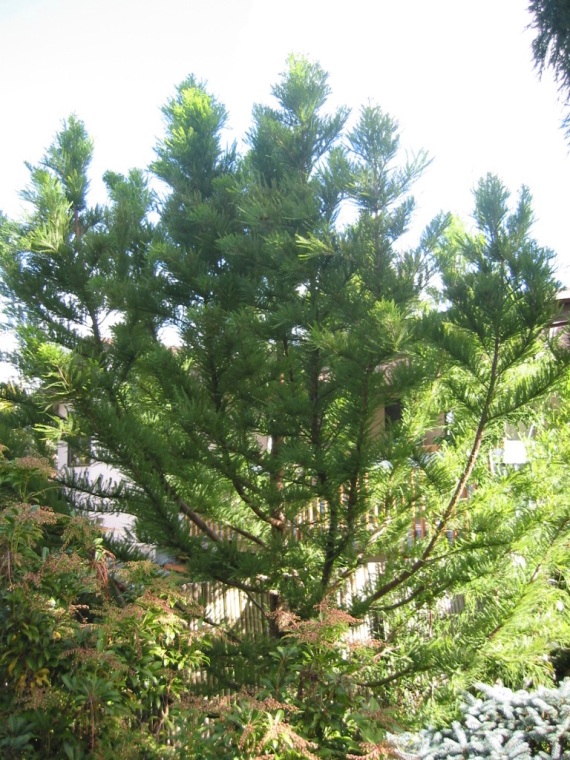
10/10/2017

7/2/2018
I know I’ve done this tree before, (https://gardeningingreenwood.wordpress.com/taxodium-distichum-peve-minaret/) but it’s grown so much since then I just had to show it off again. (That’s what I said last time! I don’t want to repeat myself too much so if you want to know a lot more about this tree go to the link.) This is a dwarf version of our native Bald Cypress (Taxodium distichum), so called because it loses its leaves in the fall. You wouldn’t know that to look at them would you? A deciduous conifer is quite a rarity, as there are only a handful in the world. I have 2 others – a Metasequoia and a Larch. All of them are amazing and unique trees.
It’s native to the SE portion of the united States and is a magnificent tree that grows to 100-120 feet tall. The largest one known is 145′ tall and another is 1,620 years old, making it one of the oldest tree species in North America. It’s also known for putting up “knees” in the swamp water it so often grows in – for support I understand, not oxygen as some have thought. (like me…). The wood is very water resistant and lasts for generations so it’s known as “wood eternal”. It’s needles turn a beautiful orange brown color in the fall, tho I have to say mine isn’t as beautiful as the species I’ve seen. It was discovered by a nurseryman name Pete Vergeldt in the Netherlands in 1990 as a seedling in his stock. You never know what you might find among this years crop!
I call it one of my “pettable trees’ because the foliage gets so nice and soft like ferns, and just begs to be touched. It’s now 11 1/2′ tall, as of this morning, but it started out as only 5′. So in the 8 years it’s been here it’s put on almost 10” a year, tho it seems much faster. That’s probably because it’s gotten so incredibly wide. It’s over 9 feet across! In any event, it’s large for a dwarf that all the garden sites online predict will be less than 10′ x 4′, tho some have the courtesy to tell you it may get to 20 feet tall, perhaps. That’d be splendid for us if it doesn’t interfere too much with the giant sequoia next door, and who knows who will win that one? I have a few such challenging interactions in the garden from ignorant and overzealous planting at times. So I prune and tie a bit here and there to alleviate the pressure. It seems to be working so far… 🙂
I hope you enjoyed this latest update on a lovely tree,
Steve
10
Jun
Posted by steven1111 in Conifers, Dwarf Plants, Gardens, Unusual Plants. Tagged: Dwarf Plants, Gardens, Personal Gardens, Unusual Plants. Leave a comment

Cryptomeria japonica “Ryokogu Coyokyu”
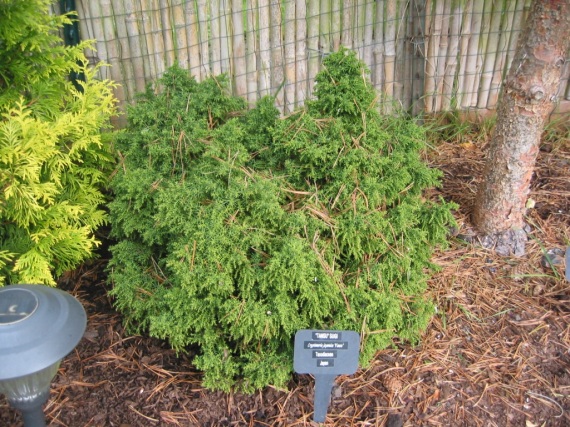
Cryptomeria japonica “Tansu”

Cryptomeria japonica “Pygmaea”
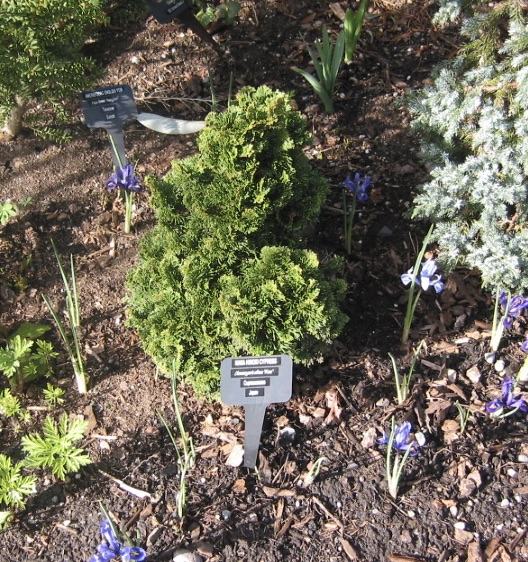
Chamaecyparis obtusa “Nana”
I have many dwarf conifers, but these are the smallest. None of these will get over 12-18″ tall and wide. They’re all getting to be near that size now and it’s taken them years to get this big. There are dwarf conifers smaller than these here, not by too much. I’m especially fond of little things in the garden. You have to really look for them to appreciate them. They don’t jump out at you like the bigger forms do. The Cryptomerias I’ve shown you are but a small fraction of the many cultivars of this tree available, and some of the smallest selections, so far as I know, tho it’s not an exhaustive sampling by any means. These are just what I happen to have. The Chamaecyparis is a Hinoki and it’s supposed to be the smallest form around, but I doubt it. There are literary hundreds of cultivars of them as well as the Cryptomerias so I’m sure there are littler ones too. Both of these trees are revered in Japan – Cryptomeria is the national tree and Hinoki is used to build temples. I’m so glad to have these little gems to provide a pixie’s eye view of the garden. It’s a small world after all…
Stop and look at the little things in your world – you’ll be delighted at what you see!
Steve
2
Jun
Posted by steven1111 in Conifers, Dwarf Plants, Gardens, Sanctuaries, Shrubs, Unusual Plants. Tagged: Dwarf Plants, Gardening, Kelley's Prostrate Redwood, Personal Gardens, Sanctuary, Unusual Plants. 6 comments

This little treasure is a dwarf form of the tallest tree in the world – the Coast Redwood (Sequoia sempervirens “Kelly’s Prostrate”). They grow along the coast of northern California and a ways up into Oregon. They can grow up to 380 feet tall and live for 1,200 to 1,800 years or more. This dwarf cultivar is only 2′ tall and measures about 8′ long and 7′ wide. I bought it in a 10 gallon pot and it was 3-4′ across then, but only 8″ tall. That was in June, 2010 so it’s been in the garden for exactly 8 years, and My how it has grown! It loves the moist peaty soils we have here, and I spray it often because the leaves are used to getting much of their moisture from fog in their native habitats. I paid more for it than any other plant I’ve ever purchased – over $200!! And, yes, I am a bit crazy, at least for this plant! 🙂
I’ve loved redwoods since I was a kid and we don’t have the room for the huge species so this is the perfect choice for us. It’s covered with fresh new growth right now and looks incredibly attractive. It even smells like redwoods! We’ve had friends think it was a giant fern because of its soft aspect. It’s one of several unusual dwarf conifers we have in our little Nature Sanctuary. But this one is the prize for me. I hope you find it as beautiful as I do.
Save the Redwoods!
Steve
28
May
Posted by steven1111 in Dwarf Plants, Ferns, Gardens, Groundcovers, Peat Bogs, Sanctuaries, Unusual Plants, Wet Soils. Tagged: Dwarf Plants, Ferns, Gardens, Peat Bogs, Personal Gardens, Sanctuary, Unusual Plants, Wet Soils. 4 comments

Maidenhair Fern – Adiantum aleuticum

Ghost Fern – Athyrium x Ghost

Korean Rock Fern – Polystichum tsus – sinensis
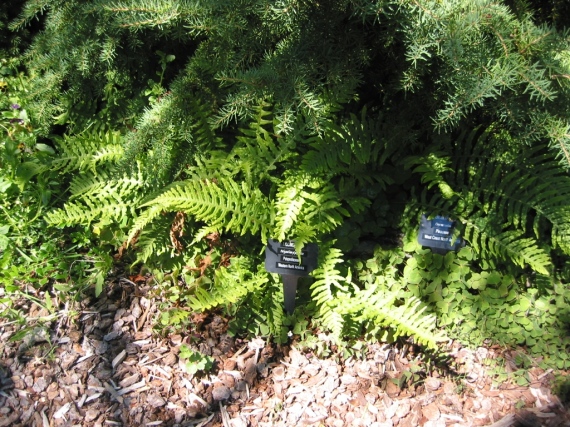
Licorice Fern – Polypodium glycyrrhiza
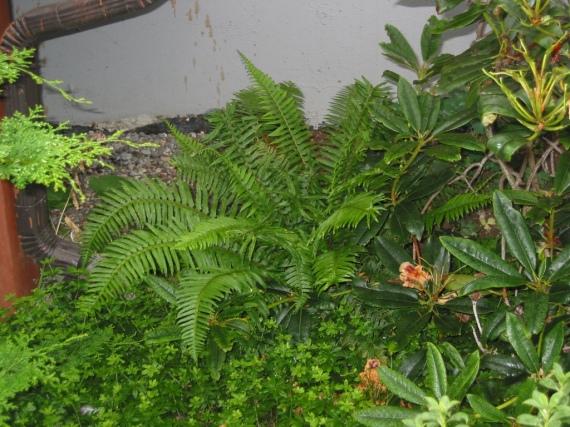
Western Sword Fern – Polystichum minutum

Auriculate Lady Fern – Athyrium otophorum
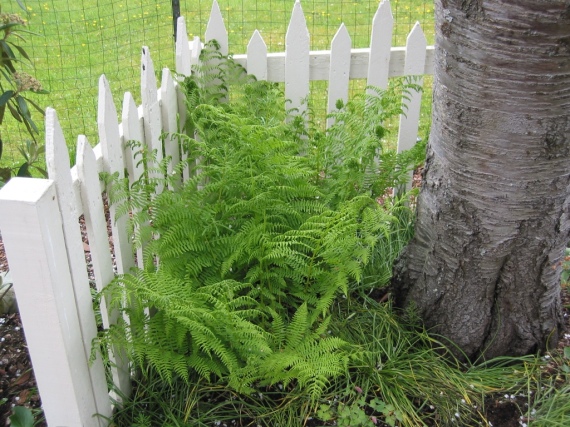
Lady Fern – Athyrium filix-femina

Soft Shield Fern – Polystichum setiferum “Diversilobum”

Japanese Painted Fern -Athyrium nipponicum “Pictum”
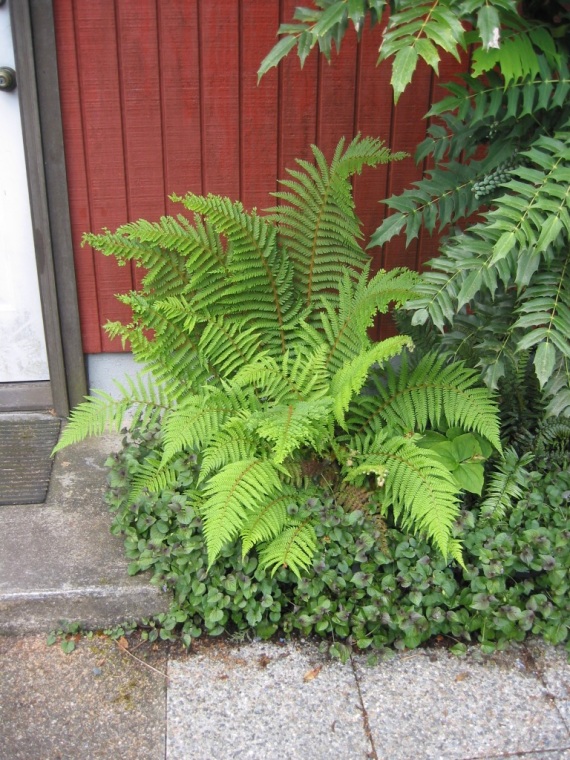
Alaska Fern #1 – Polystichum setiferum

Japanese Tassel Fern – Polystichum polyblepharum – Left side by tree
Alpine Water Fern – Blechnum penna-marina – All thru the middle

Silver Saber Fern – Polystichum xiphophyllum

Unknown Fern #1

Unknown Fern #2

Robust Male Fern – Dryopteris filix-mas “Robusta”

Alaska Fern #2 – Polystichum setiferum

Dwarf Crisped Golden Scale Male Fern – Dryopteris affinis “Crispa Gracilis”
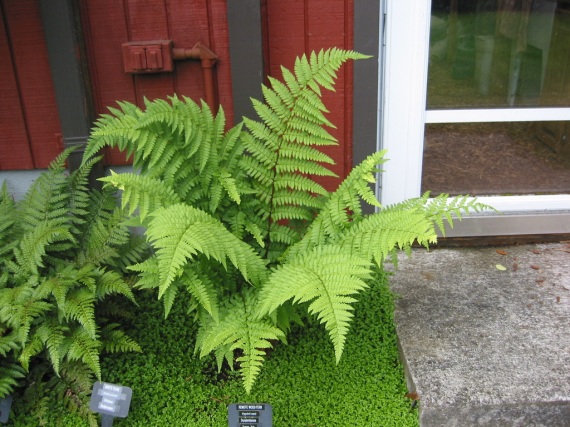
Remote Wood Fern – Dryopteris remota

Mackino’s Holly Fern – Polystichum mackinoi
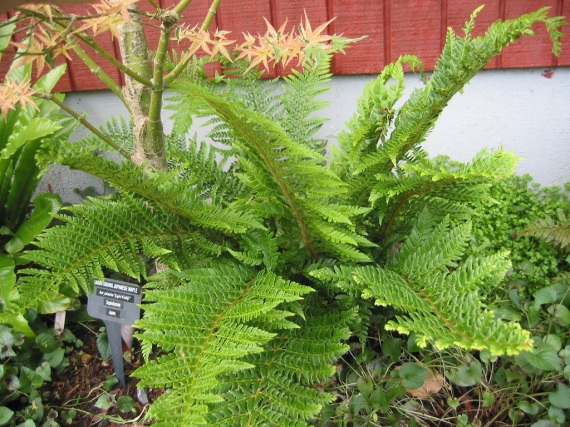
Hard Shield Fern – Polystichum aculeatum

Deer Fern – Blechnum spicant

Hart’s Tongue Fern – Asplenium scolopendrium
You might think I have too many ferns, but how can you have too many of these delicate and diverse wonders in your garden? They seem to thrive here in our Nature Sanctuary in the wet soils of this peat bog we garden in. I’ve included some of my favorites that are no longer with me, unfortunately. Sometimes they just die on you – for no apparent reason. Very frustrating. But enough of them live and thrive to make me happy.
Several of these are along the garage wall in the “Fern bed”, while others are scattered throughout the garden. I count 23 different ferns here, of which 19 still live. Not a bad record, tho I’ve replaced a few over the years. I had to include them all because they’re just so cool! BTW – if you recognize either of my Unknown ferns (I lost the labels!) please feel free to enlighten me as to their names – Thanks!
I hope you’ve enjoyed this display and may have found some ferns you’d like to put in your own garden.
Ferns Rock!
Steve
1
May
Posted by steven1111 in Conifers, Dwarf Plants, Gardening, Gardens, Nature, Sanctuaries, Shrubs, Unusual Plants. Tagged: Colors, Dwarf Plants, Gardening, Gardens, Nature, Personal Gardens, Sanctuary, Unusual Plants. Leave a comment

I love this little scene. I’m always impressed with the way the colors, textures and forms compliment one another and create an interesting tableau. From the left, the plants in this picture are a white and green Winter Creeper (Euonymus fortunei “Emerald Gaiety”) and in the center, all gloriously purple, (even in the shade which I wasn’t sure would happen since so many colored plants lose their color in the shade, especially the deciduous ones – conifers seem to do better…) is a Helmond’s Pillar, or Columnar, Barberry (Berberis thunbergii “Helmond Pillar”). In the center the brown grassy thing is a wild looking Toffee Twist Sedge ( Carex flagellifera “Toffee Twist”), that has grown this big from a 4″ pot in just Two Years! And to the right is a dark green Spreading English Yew (Taxus baccata “Repandens”). In the back in the center is the trunk of an Italian Plum we harvest each year for its delicious fruit. We also give a lot away to the City Fruit organization that gives them to food banks around the area. Way cool…
I’ve tried to arrange my plantings so that the colors contrast nicely or maybe just compliment one another in form and texture, as you can see in this picture. It’s a harmonious way to arrange things and I have lots of different plants that congregate here in this little Nature Sanctuary. At the moment I think we have around 220 different cultivars, species or varieties in this garden that is only a few hundred feet square overall. I just love so many plants that I’ve gone a bit crazy and collected as many of my favorites as possible. I’ve also found new favorites to add to the pile. Whew!! But now I’m just about out of room for anything larger than flowers, so I’m going to concentrate on them in the future. Bulbs are so mysterious and cool, annuals rock every summer and perennials share their beauty with us year after year. I’ll have plenty to do…
What a glorious thing a garden is! So much to see and to marvel at. It truly nurtures my soul just to see it all from the house, and to walk among the trees and shrubs as they get bigger and bigger each year. Louie and I both feel so lucky to have even this small space to garden in and to enjoy the freedom to express our personalities through our gardening. Who could ask for more?? (Well I could, but that’s for my other blog, Naked Nerves, so I won’t go there now… 😉
Creating compelling contrasts,
Steve
29
Apr
Posted by steven1111 in Dwarf Plants, Ferns, Gardening, Gardens, Nature, Unusual Plants. Tagged: Dwarf Plants, Ferns, Gardening, Gardens, Nature, Personal Gardens, Unusual Plants. 4 comments
10
Apr
Posted by steven1111 in Berries, Conifers, Dwarf Plants, Flowers, Gardening, Gardens, Nature, Shrubs, Trees, Unusual Plants, Wildlife. Tagged: Dwarf Plants, Flowers, Gardening, Gardens, Japanese Maples, Nature, Personal Gardens, Unusual Plants. 2 comments
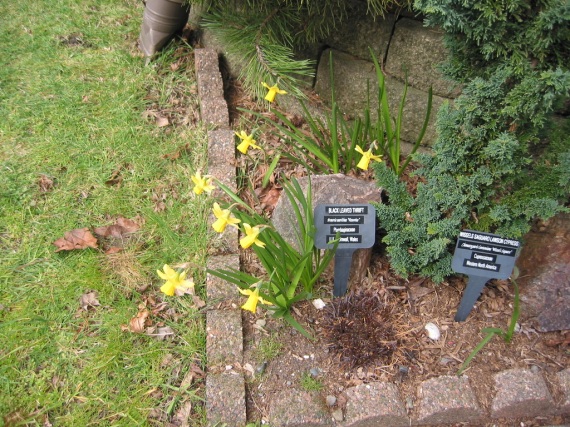
How could I start with anything but Daffodils?? These are called “Tete a Tete” and have multiplied for 3 years now. So nice at the entrance to the house.
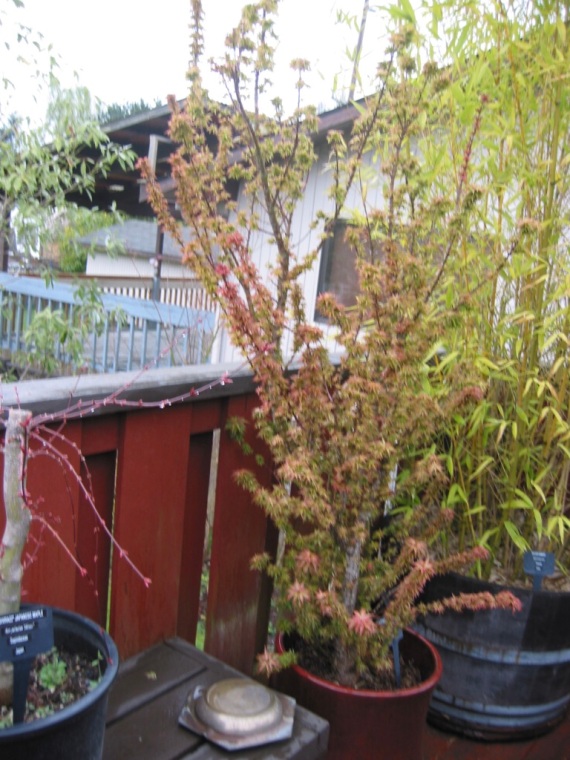
A Goshiki Kotohime Japanese Maple (Acer palmatum “Goshiki Kotohime”). The name of this beautiful maple means 5 colored Old Harp for the multi hued leaves as it opens up, and for the Koto, a traditional Japanese instrument that is harp like. It’s the first Japanese maple to leaf out every spring and has grown in this pot for years now. I hope it does so for awhile longer cause I can’t figure out how to get it out!!
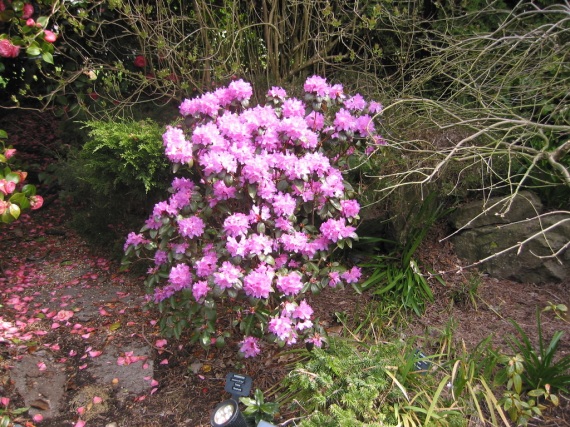
A PJM Regal Rhododendron (Rhododendron “PJM Regal”). This is a very early Rhodie that is just vibrant with its color. It adds some bright color into the grey days of Spring and brings some beauty to the front garden.
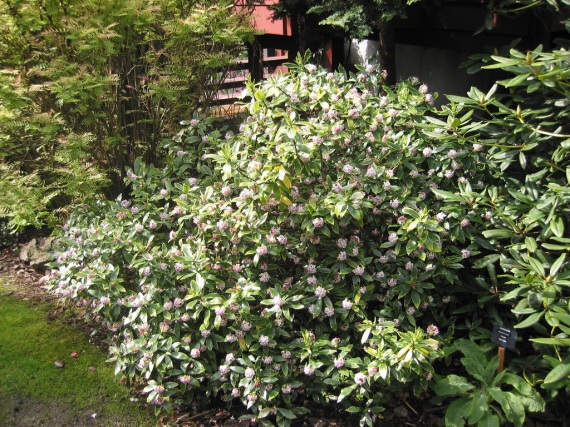
I wish I could let you smell this one. It’s a Winter Daphne (Daphne odora “Marginata”) and is one of the most fragrant plants in the garden world. We can smell it all over the front yard, even when we walk up onto the front porch. It’s a classic!
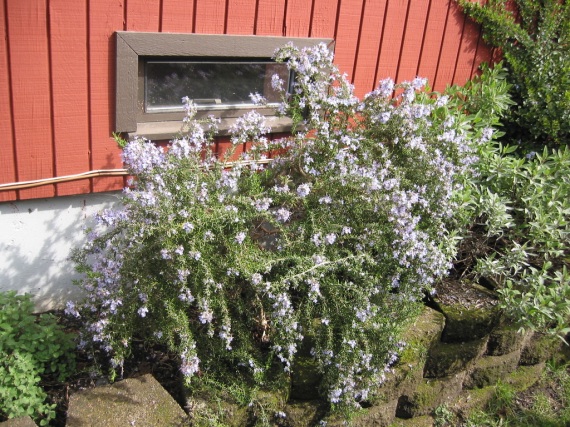
This is a Prostrate Rosemary (Rosemarinus officinalis “Prostratus”). It’s a weeper that sometimes falls over the edge of the wall here. But it occasionally freezes back – it’s only mostly hardly. It’s very fragrant to touch.
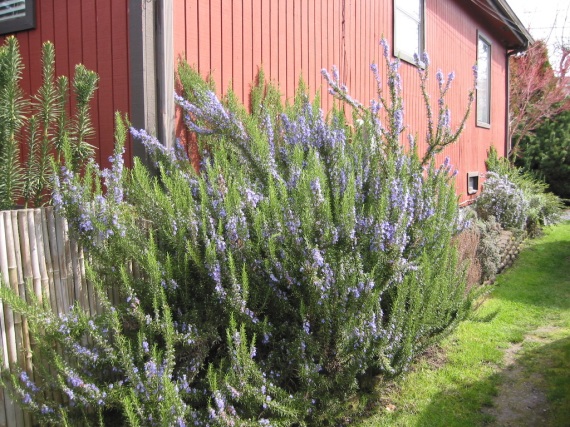
This is another Rosemary – one that most people would more easily recognize than the last one. It’s a Tuscan Blue Rosemary (Rosemarinus officinalis “Tuscan Blue”). It’s notable for having been introduced to the plant world by the noted author and traveler Vita Sackville-West. It’s delightful to brush by this plant and smell it on your hands as you walk away.
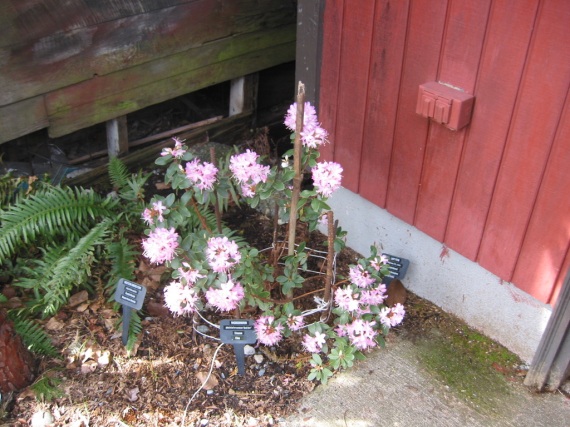
This is what’s known as a species Rhododendron. That means it’s not a cultivar but rather one found in nature, (tho this one is a cultivar of the native (confused yet?). It’s a Rock Rose Rhododendron (Rhododendron racemosum “Rock Rose”). I’ve tried to grow this plant for several years, but they keep dying on me. This one was trashed by the raccoons that ran over it from the old garage next door. I put re-bar around it and that solved the problem, but I still sorta wanted to eat raccoon for dinner that night! (Not really….!)

This is a unique plant. It’s called a Zig Zag Camellia (Camellia japonica “Unryu”). The name means “Dragon in the Clouds”. The branches all grow at 45 degree angles to each other. It’s very interesting to watch it become itself. Lovely flowers too.
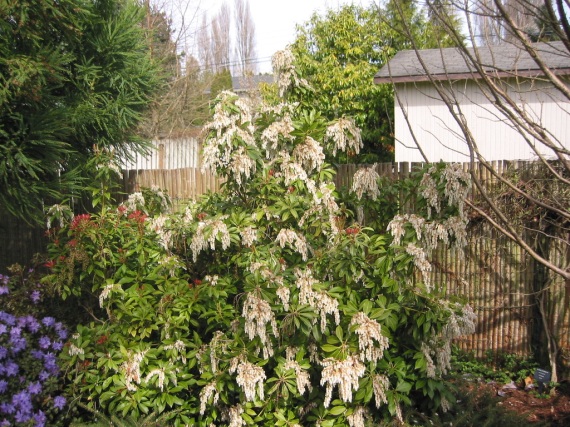
A lovely specimen of Lily of the Valley shrub (Pieris japonica Mountain Fire”). The new growth is fiery red and looks like flowers it’s so bright. The flowers are fragrant and are bell shaped – the hallmark of plants in the Ericaceae – the Heath and Heather family, which also includes blueberries and rhododendrons as well as many other familiar plants.
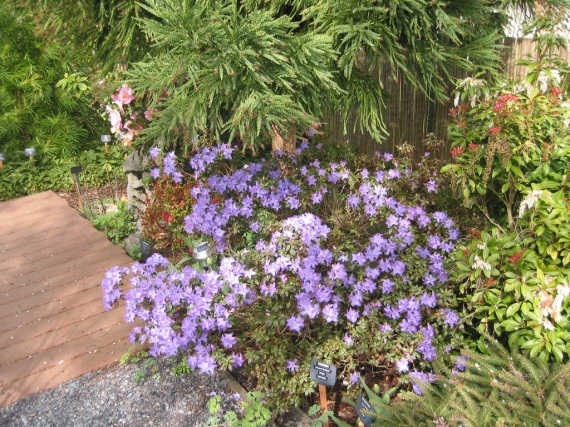
Near the Pieris is this lovely Blue Diamond Rhododendron (Rhododendron “Blue Diamond”), another early blooming one. There aren’t a lot of Rhodies that are this kind of blue or purple, so it’s unique for us here. It stays small.
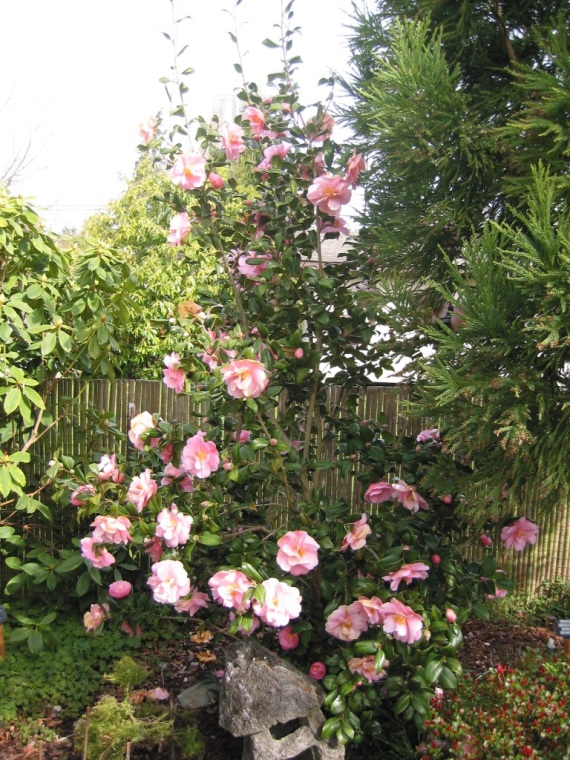
Next to the Rhodie is this Pink Icicle Camellia (Camellia hybrid “Pink Icicle”). We got this as a large plant and it’s put on several more feet of growth in the last few years. It blooms early and has lovely pink blossoms with orange centers.
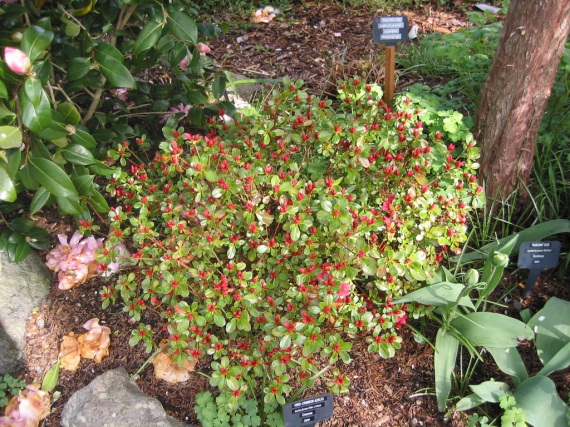
This one is subtle, but I wanted to include it because it’s a wonderful plant. It shows how the color develops first on the buds. It’s a Hino Crimson Azalea (Azalea kurume “Hino Crimson”). It’s a brilliant scarlet red when it blooms and is covered almost totally with tiny bright red flowers.
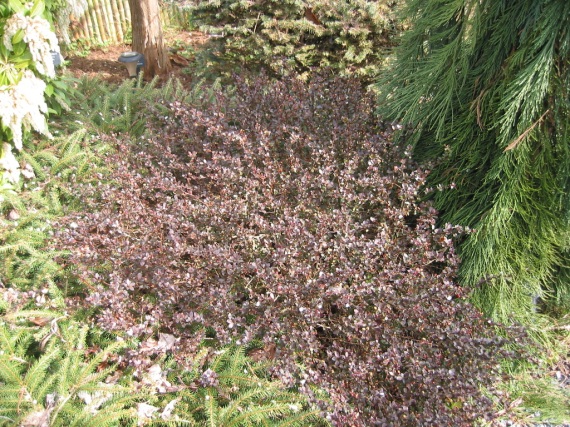
No flowers here. This is a Crimson Pygmy Barberry (Berberis thunbergii “Atropurpurea Nana”). I’m showing it for the purple new growth. It leafs out early and looks very nice next to the rock path beside it.
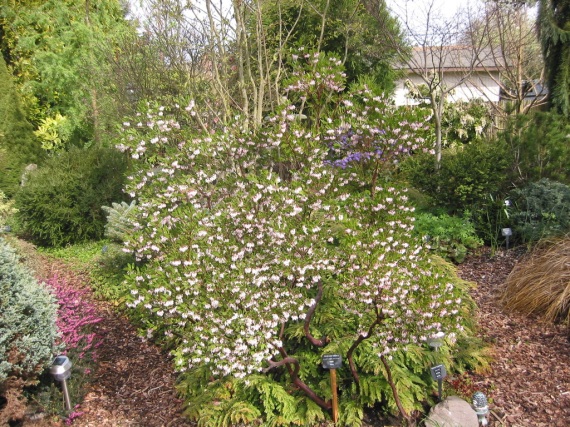
I love this one. It’s a Howard McMinn Manzanita (Arctostaphyllos densiflora “Howard McMinn”). It has wonderful brownish red bark that I’ve exposed by pruning up the branches. This smells so sweet and is prized by the bees and hummers, and by people too!! Manzanita means “little apple” in Spanish and some of the species have small red orbs after the flowers leave, but not this one. Too bad…
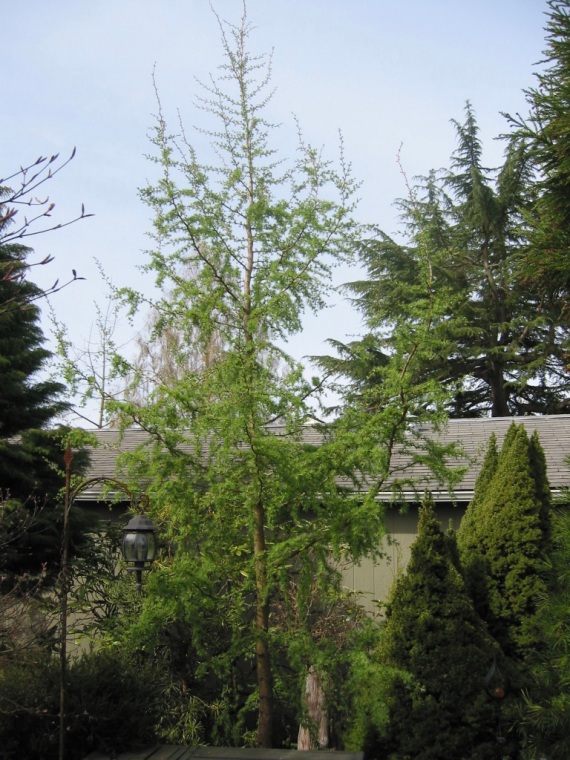
This is a big one, and again no flowers. It’s a Diana Japanese Larch (Larix kaempferi “Diana”). I’m showing it for the light green needles it’s rapidly covering itself with. They look so delicate but this tree is very hardy. It’s put on some 13 feet in the last 3 years alone! I can’t wait to see what it becomes!
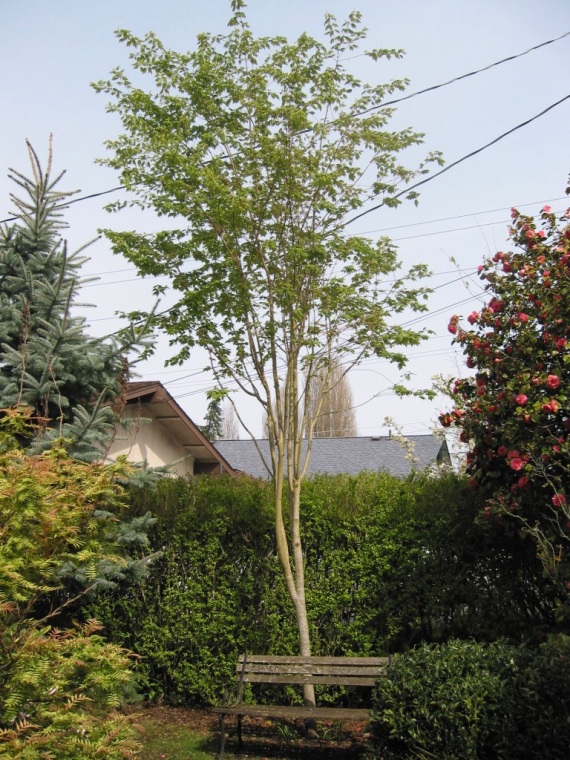
This tree is the first to leaf out in the whole garden. It’s a Korean Butterfly Maple (Acer tschnoskii ssp. “Koreanum”.) It’s another fast grower and has gotten to this size in only 4-5 years. It turns a striking color of reddish orange in early fall.
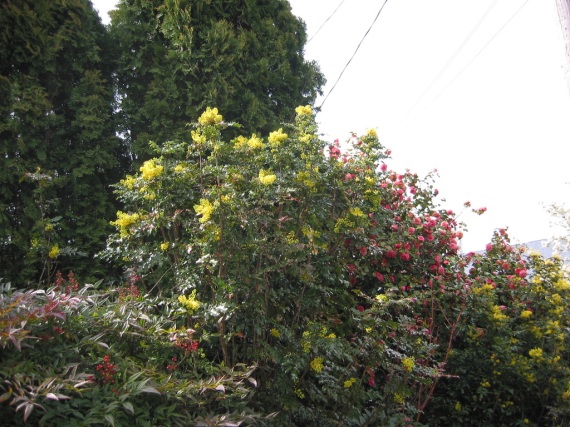
Here’s the last one – an Oregon Grape (Mahonia aquifoloium). It has these wonderfully bright yellow flowers in early spring, then they turn into edible blue berries. Even people eat the fruit but it’s the birds who love them. But they’re a bit dangerous to be around – they’re prickly – and Louie keeps threatening to blow them up with dynamite cause they scratch him when he mows the lawn. But I won’t let him… Obviously…
This is just the beginning of the flowers to come, but I wanted to give you a taste of what it looks like around here this time of year. After a dull grey Seattle winter with little color, it’s so exciting to see all these flowers and leaf colors now, and it’s just glorious. Everyone loves flowers don’t they? I hope you do!!
Happy Spring!!
Steve
12
Feb
Posted by steven1111 in Dwarf Plants, Gardening, Gardens, Nature, Pruning, Trees, Unusual Plants. Tagged: Dwarf Plants, Gardening, Gardens, Japanese Maples, Metasequoia, Nature, Personal Gardens, Pruning, Seasonal Changes, Unusual Plants. 4 comments

Harry Lauder’s Walking Stick (Corylus avellana “Contorta)
I usually like to showcase lush green gardens or individual plants in this blog, with some miscellaneous posts here and there. But it’s Winter and there isn’t much lushness around now. So I thought I’d do something different. It’s always fascinated me to look at the trees in the fall and winter when they’re bare of leaves. You can finally see the structure of them. They look so different without their clothes on and you can really see how the buds look and the ways they grow. I’ll show you a few of the deciduous trees in our garden so you can see this structure and appreciate the trees from a whole new perspective. They’re still beautiful to look at now, and you can see how I’ve pruned them to attain their current shapes. It’s something that’s so much harder to see when they’re in full leaf. Hope you enjoy the tour…

Jade Butterflies Ginkgo (Ginkgo biloba “Jade Butterflies”)
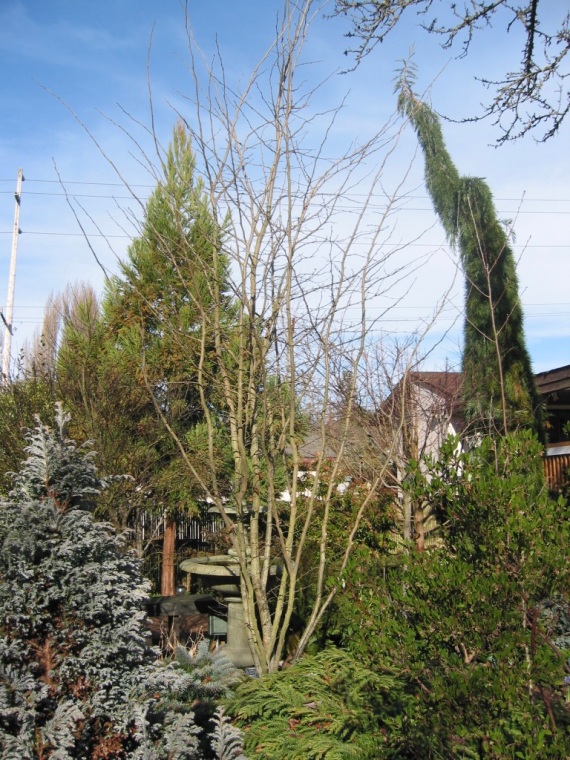
Vanessa Persian Ironwood (Parrotia persica “Vanessa”)
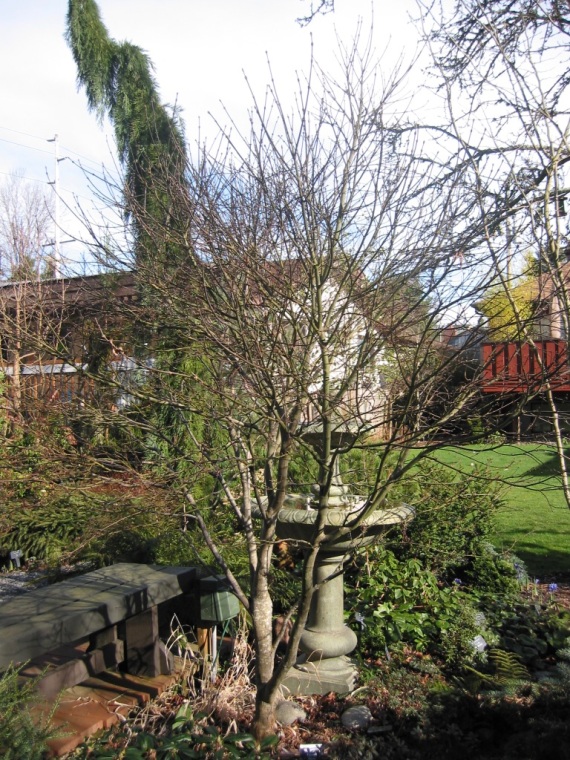
Red Pygmy Japanese Maple (Acer palmatum “Red Pygmy”)

Diana Japanese Larch (Larix kaempferi “Diana”)
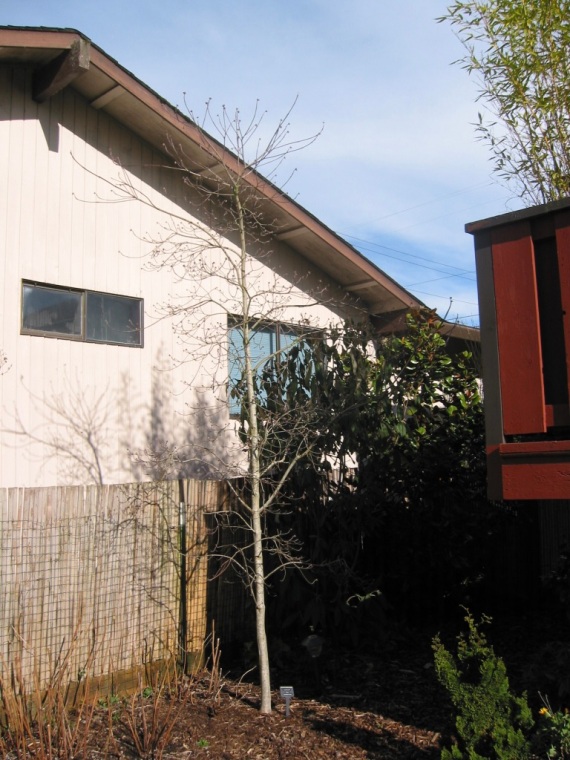
Eddie’s White Wonder Dogwood (Cornus florida x nuttallii)

Coral Bark Japanese Maple (Acer palmatum “Sango-Kaku”)

Korean Butterfly Maple (Acer tschnoskii ssp. “Koreanum”)

Waterfall Japanese Maple (Acer palmatum dissectum “Waterfall”)
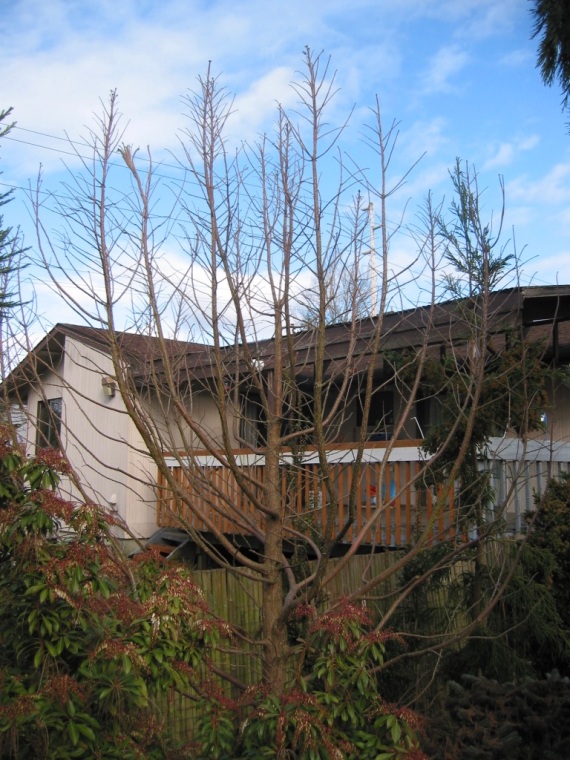
Dwarf Swamp Cypress (Taxodium distichum “Peve Minaret”)

Bloodgood Japanese Maple (Acer palmatum “Bloodgood”)

Miss Grace Dawn Redwood (Metasequoia glyptostroboides “Miss Grace”)
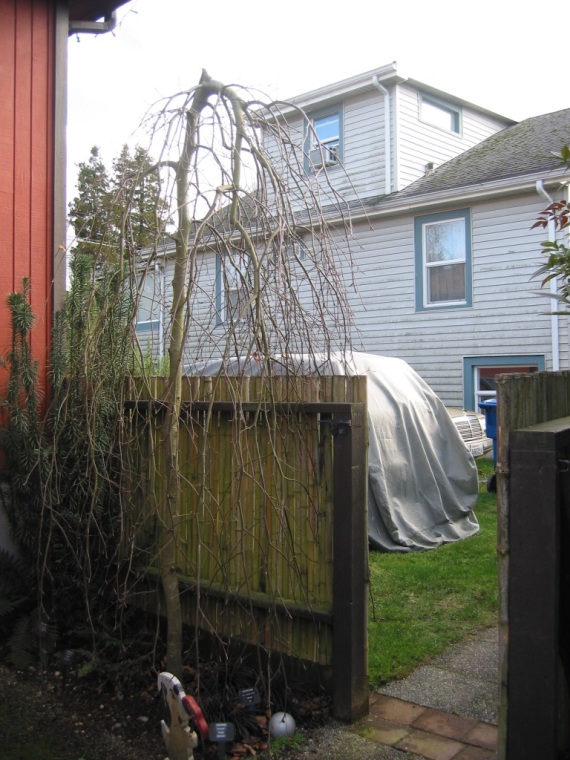
Weeping Purple Copper Beech (Fagus sylvatica “Purpurea Pendula”)

Red Fox Katsura (Cercidiphyllum japonicum “Rot Fuchs”)
I hope this little story has given you a different idea of a new way to look at trees when they don’t have their leaves on them. It’s a true art to learn to identify them by their buds and growth habits, without the leaves to guide us. It takes practice, and I’ve personally found that the aspect is an easier way to identify them then the buds are, but that’s just because I haven’t learned the buds as well. It’s a lot harder to do, but totally worthwhile to try to learn them. There’s so much more going on beneath the leaves…
Seeing thru them,
Steve
10
Feb
Posted by steven1111 in Art, Conifers, Dwarf Plants, Ferns, Flowers, Garden Construction, Gardening, Gardens, Groundcovers, Nature, Shrubs, Trees, Unusual Plants. Tagged: Art, Dwarf Plants, Ferns, Flowers, Garden Shows, Gardening, Gardens, Japanese Maples, Nature, Personal Gardens, Unusual Plants. 4 comments

As I mentioned in my last post Louie and I spent several hours the other day at the NW Flower and Garden Festival. It’s celebrating its 30th year as America’s largest family-owned garden themed show. It’s truly amazing! There are a number of of demonstration gardens, which are what I’ll be showing you here. But there’s also a huge marketplace with hundreds of vendors selling all manner of garden products, as well as miscellaneous show type stuff. There’s also a large plant market with a number of specialty nurseries who offer miniature conifers, bulbs and tubers, even Japanese maples. I could only handle it for a few hours before sensory overload hit and we had to leave. But I got a lot of good pictures and I want to share them with you here.
All of these gardens were created by dedicated teams of volunteers in just the 72 hours preceding the show! Incredible! Of course none of them would make it outdoors as planted – they’re not meant as literal gardens themselves and their job is to showcase various themes and styles rather than an actual garden design. They move in literally tons of rock, soil, mulch and of course hundreds of plants, ranging from a few inches to 20 feet or more tall. I always get a lot of ideas for my own garden, but of course it’s already so over-planted I don’t really have room for more. But next year I’ll plan ahead better and get some bulbs at least. But then the reason we go is just to enjoy the sights. I hope you do too!
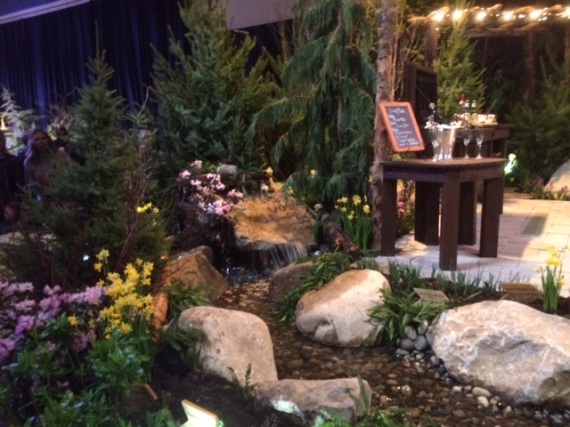
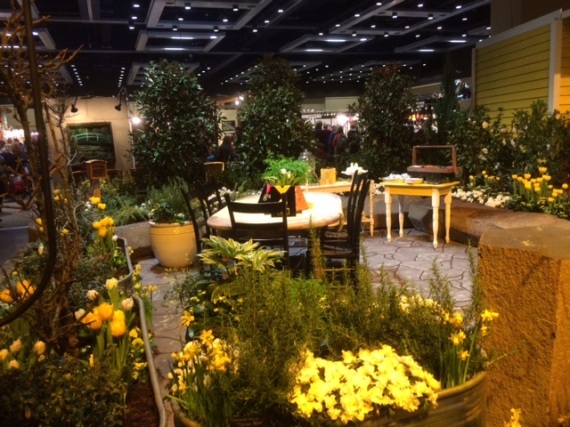












OK, thats about it. It’d be nice if I’d been able to remember each display, but I didn’t have writing materials and it would have been too hard to remember each one anyway. But I hope that just the designs themselves will be satisfying for you, as it was for me. If you have a garden show in your area please do find time to go to it. You’ll be supporting a good cause and be able to see some amazing garden displays and get your own ideas for your garden at home. It’s worth the trip.
Happy Viewing,
Steve
3
Feb
Posted by steven1111 in Conifers, Dwarf Plants, Gardening, Gardens, Groundcovers, Nature, Shrubs, Trees, Unusual Plants. Tagged: Blue Plants, Dwarf Plants, Gardening, Gardens, Nature, Personal Gardens, Seasonal Color, Unusual Plants. Leave a comment
There aren’t many flowers blooming in the garden in Winter, so we look to the ones with colored foliage to give us some interest in the garden this time of year. A couple of these change color with the cold during the change of seasons, but most of them are colored all year long. But they’re especially valued in this otherwise rather drab season.

This Cryptomeria elegans is one that changes from a lush green in summer to this lovey purple in winter. It’s one of the fastest growers in the garden. It’s only 8 years old and has grown over 20 feet in that time. The bark is a beautiful reddish brown that adds even more color to it. It’s one of my favorite plants in the garden all year, but it’s especially nice now.

From one of the tallest plants in the garden to one of the smallest. This is a small patch of Black Mondo Grass (Ophiopogan planiscapus “Nigrescens”). It’s this lovely black all year long, one of only a few black plants I know of. This clump is by the back gate and under a weeping purple beech. You can’t see them much in the summer, tho what you can see goes well with the purple beech. So this is their time to shine. The silver globe is an old cannon ball we painted, just for fun. Art is everywhere…

Here’s’ a large one that is easily recognizable – a Colorado Blue Spruce (Picea pungens “Glauca”). A common enough plant but its blue is so beautiful all year it’s a treat to have all the time. It’s in the front yard and provides a nice focal point to the corner of the garden. It gets big and it’s very prickly – the specific name “pungens” mean sharp, so I’ll have to prune it carefully so we can walk by it safely.

This is another small one – a Morgan’s Chinese arborvitae (Thuja orientalis “Morgan”). I didn’t even know there were arborvitae in Asia so this was a treat to find in a nursery when I was looking for a yellow plant to provide some bright color in the front yard. It won’t grow to be more than 3′ x 2′ and it’ll take it years to get that big. That’s OK because I love dwarf conifers and have a lot of them.

This is another one that changes color with the colder weather. It’s a Heavenly Bamboo (Nandina domestica “Moyer’s Red”), and not only offers us a beautiful color change but also these lovely bright red berries. Unfortunately they’re not good bird food but they sure are nice eye candy. This is at the corner of the entrance to the yard so it gets viewed all the time by passers by. You can see it a block away.

This one shows two plants in one shot, really three if you count the tiny Iris reticulata by the Blue star Juniper (Juniperus squamata “Blue Star”) at the top of the picture. The juniper is always this nice blue but the one in the front is the really cool one to me. It’s a Toffee Twist Sedge (Carex flagillifera “Toffee Twist”) and it’s gotten to this size in one year from a 4″ pot! We step on its leaves all the time so it stays “trimmed”, and that seems to work OK.

Here’s another nice blue one. It’s a Snow White Lawson Cypress (Chamaecyparis lawsoniana “Snow White”). It’s a nice columnar plant and it works well at the corner of the yard by the gate. It grows very slowly and will only get 6′ tall they say, and it’s almost that tall now, so I think it may get bigger. It’s also blue all year, even in the shade where most colored plants won’t color well. It’s very soft to the touch and has upright branching, as opposed to the shaggy downward branching of the species.

This is another one that changes color in the fall and winter. It’s a PJM Regal Rhododendron (Rhododendron “PJM Regal”) and turns this nice purple in winter. It’s an early bloomer and will be in bloom in the not too distant future. It has wonderful bright pinkish purple flowers that stand out nicely against the dark green of the pyramidal arborvitae behind it. It’ll get 5′ tall in time.

One of the few golden plant we have, this is a Daniellow Western Red Cedar (Thuja plicata “Golden Spire”). It grows a foot and a half a year and will get to 20′ in time. It’s a cultivar of the most useful tree of the Pacific Northwest, as far as the native people were concerned. It’s their “Buffalo” as far as the many uses they had for it. The species is a huge tree and covers miles of land in this area of the world. It’s very cool to have this as a reminder of the big ones.

One last blue one. This is a Sawara False Cypress (Chamaecyparis pisifera “Baby Blue”) and will get to about 6 feet tall, which it almost is now, so it may get bigger. It’s at the corner of what I used to call the Heather bed, but the heathers mostly died in the big freeze of last winter so I dunno what to call it now. Just a nice planting bed I guess. Some spider mites or something bad got into it last year and we lost the back half of it, but I was able to cover it up with other branches. A sweet, soft little plant.
So that’s it for now. I have more but they aren’t big enough to show off yet. Maybe in a few years I’ll do this again. Probably. It’s so nice to have these colorful creatures in the garden now to bring some winter cheer into our lives when we walk in the garden during these days of grey and overcast skies. I hope you enjoyed seeing them and that I gave you some ideas of how to color up your own winter garden!
Colorfully good wishes, Steve
12
Oct
Posted by steven1111 in Conifers, Dwarf Plants, Gardening, Gardens, Nature, Sanctuaries, Unusual Plants. Tagged: Dwarf Plants, Gardens, Japanese Maples, Personal Gardens, Sanctuary, Unusual Plants. 6 comments
Entering the Front Garden under a Japanese Maple & Oregon Green Pine The Maple you enter under – Sango-Kaku, Wissel’s Saguaro Cypress to the left
The Maple you enter under – Sango-Kaku, Wissel’s Saguaro Cypress to the left
In the middle of the front garden – Dwarf Hinoki Cypress, Red Fox Katsura Moving along – Waterfall Maple, Sarcococca
Moving along – Waterfall Maple, Sarcococca At the end of it – Korean Butterfly Maple, Blue Spruce
At the end of it – Korean Butterfly Maple, Blue Spruce Heading into the Back Yard – Eddie’s White Wonder Dogwood
Heading into the Back Yard – Eddie’s White Wonder Dogwood The whole thing
The whole thing
4 year old SweetBay Magnolia, Blueberries in color
The north side – Pine, Golden cedar, Black Dragon Sugi, Rasen Sugi, Taxodium, Sequoiadendron In the back corner – Japanese Umbrella Pine, Alberta Spruce
In the back corner – Japanese Umbrella Pine, Alberta Spruce Japanese Larch “Diana”
Japanese Larch “Diana” Elegans Sugi
Elegans Sugi From the other side – Jade Butterflies Ginkgo in front
From the other side – Jade Butterflies Ginkgo in front Back thru the garden – Baby Blue Cypress, Howard McMinn Manzanita
Back thru the garden – Baby Blue Cypress, Howard McMinn Manzanita A dwarf Sequoia – Kelley’s Prostrate
A dwarf Sequoia – Kelley’s Prostrate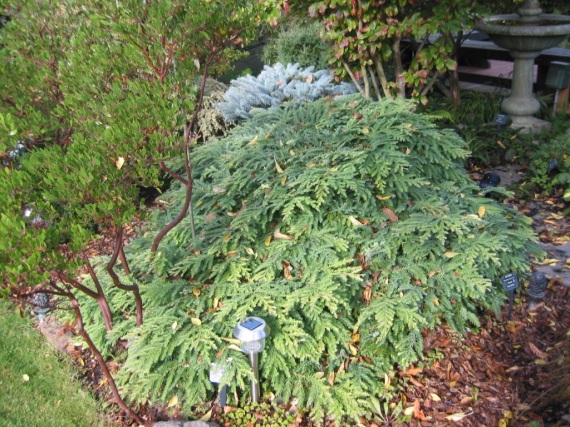 The Persian Ironwood above it – Vanessa
The Persian Ironwood above it – Vanessa The Inner Glade – the Fountain
The Inner Glade – the Fountain Exiting the garden and returning to the real world. Bye, Steve
Exiting the garden and returning to the real world. Bye, Steve
22
Jul
Posted by steven1111 in Conifers, Dwarf Plants, Gardening, Gardens, Sanctuaries, Seeds, Trees, Unusual Plants. Tagged: Dwarf Plants, Gardening, Gardens, Ginkgo, Larch, Metasequoia, Personal Gardens, Sanctuary, Seeds, swamp cypress, Unusual Plants. 6 comments
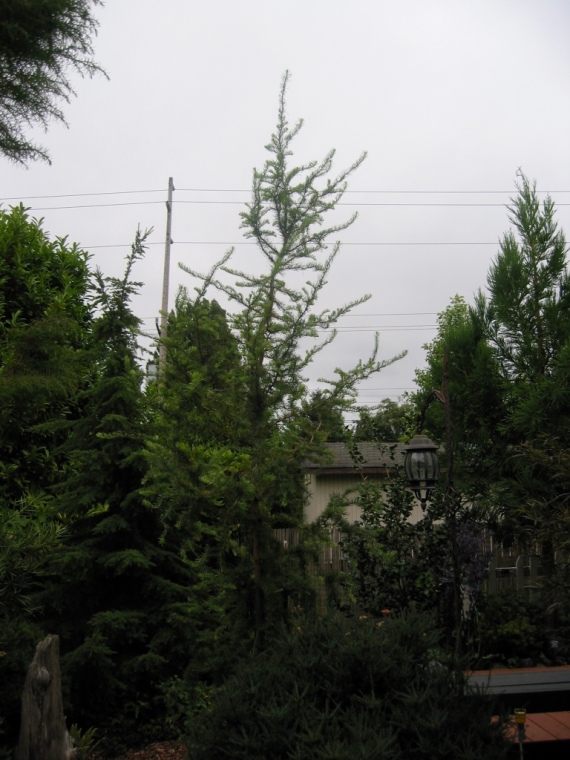
Of the few deciduous conifers that exist on this planet the Larch, or Larix, is probably the best known. There are some 11 species of it that grow from the Western US across the to the Atlantic seaboard and others that grow across Europe to Siberia and into the Himalayas and beyond to China and Japan. The one I’m showing you here is a form of the Japanese Larch, Larix kaempferi, called “Diana”. It’s a uniquely contorted form that bends and twists as it grows fast to a small tree of maybe 30 feet tall, in not much time, given that it’s grown 3 – 3 1/2 feet for the last two years I’ve had it and it’s still growing this year. It turns an amazing golden yellow in fall and can be seen from the house it’s so bright and clear in its color.
We won’t get much shade from this tree but its form and texture makes up for that quite well. This tree is in the Pinaceae, or Pine family, along with another of these deciduous conifers called the Pseudolarix, or Golden larch. It’s not a true larch but sure does look like one. Another great tree for fall color too. It goes bare in the fall too. So don’t be shocked when that lovely conifer you have in the front yard loses its leaves in the autumn. They’ll come back in the spring all feathery and bright green and new.

This tree in the Cypress family, or Cupressaceae, is well know in the south eastern parts of the US. It’s a variety of the Swamp Cypress that inhabits the swamps and wetlands of that area. This is the Taxodium distichum variety called a “Peve Minaret” for the developer of it in Holland. This is a dwarf form of the tree that will only grow to 10-20 feet tall, depending on which web site you read. I’ve only seen them get to 10 feet or so myself so we’ll see how it goes. The species tree grows to 100 -150 feet and is a valuable timber tree for commerce in its native habitat. The wood is known for its ability to withstand rot, as is true with many plants in the Cypress family. Not surprising, as it grows in water. It also develops “knees”, or roots that come up above the water line. Very cool…
This tree turns a lovely shade of orangish brown before it drops its needles in late fall. It’s late to leaf out in the spring too but the foliage is such a treat it’s well worth the wait. It’s one of my “pettable” trees because it’s so soft to the touch and easy to be around. Not prickly like so many conifers are. This tree is only 5 years old from a 5 ft tree, and it’s now over 10 feet tall and 7 feet across so it’s going to get much bigger in time. Maybe it’ll get to that 20 ft. mark. I’d like that, but since it only puts on about a foot each year, as is typical for many mid sized dwarf trees, it’ll take another 1o years or more to get there. I can wait…

This one is perhaps my favorite tree in the garden. Maybe. I have so many I love. This is a variety of the famous Dawn Redwood, or Metasequoia glyptostroboides. This variety is called “Miss Grace” and it’s a weeper that I had to train up to get it to its current height of 9 feet. Though it’s the smallest of the redwoods, the species will grow to over 200 feet tall in central China where it was just “discovered” in the early 1940’s. It was found in the fossil record just before then and was a surprise to be found living still in its native habitat. Its’s endangered there but its seeds have been sent to arboreta and nurseries all over the world. I planted my first one for my folks back in the early 70’s and I sure would like to see it now. It must be close to 80 feet by now I’d guess. Wow! I wish my folks had been able to keep that home…. ah well. But I digress…
The story of this particular cultivar, “Miss Grace”, is that the nurseryman that found it thought it was going to be a weeper and trail along the ground. But overnight the nursery workers tied it up to be a tree, so that’s what happened. I worked hard to get mine this tall but it wouldn’t stay put when I tried it to get it to 10 feet and it fell over about 2 months after I took off the training stakes. So now it weeps down all over itself. It’s another one of my “pettables” because it’s so incredibly soft to the touch. It turns a lovely shade of orangish brown, like the Taxodium, in the fall before it loses its needles. It grows a little slower than the other ones, at several inches a year, so it’ll be a treat to see how big it will get in time. I’m excited to see how it does.

Some folks will say I’m cheating with this one. Many people call this a conifer but it’s not really one. It’s clearly related it’s true, but it’s not truly a cone bearing tree like the confers. It’s a Gymnosperm tho like confers but is closer to the cycads (like Sago Palms…) than the conifers. But I’m including it anyway because so many people call it one, including the American Conifer Society. So I’m fine with putting it in this list. This is a Ginkgo biloba variety called “Jade Butterflies”. It’s a relatively small dwarf tree that will grow to the usual 10-20 feet tall, but so far it’s only gotten to about 8 feet in my garden. It’s grown about a foot a year tho so it won’t take it long to get to full size. The leaves look like small butterflies which is why it’s named for them. I can see it, but it’s a fanciful name, as so many botanical names are. That’s OK, it suits it.
This is a unique tree, being the only member of its family -the Ginkgoaceae – and has been around for over 270 million years in its current form. It’s called a living fossil and it truly is. Here in Washington State we have a State Park called the Ginkgo Petrified Forest and we visited it last year on a trip across the country. It was amazing to see the little leaves in the rocks and to imagine this tree being around way before the dinosaurs and humans by ages. It’s truly a piece of living history. There are some giant trees of this type growing all over the world now so it’s a treat to have a small one here in our small garden.
Well, that’s a tour of some deciduous conifers. The only one I didn’t mention was the Chinese Swamp Cypress (Glypstrobus – like the Metasequoia glyptostroboides which was named for it.) I feel privileged to have at least 3 ( maybe 4) of the 5 (maybe 6) deciduous conifers on the planet. I try to have a great variety of plants in this garden and now have over 200 different varieties or cultivars. It’s a lot of why we call this a Sanctuary, and sometimes a mini Botanical Garden. I purposefully sought out these deciduous conifers for their unique status and their wonderful habits of growth. I like it that they lose their leaves and die back each year. It’s nice to provide a different option for the garden instead of a dark heavy conifer. These are all much lighter feeling and the loss of leaves makes them look delicate and fine. Just my opinion, but I find them fascinating. I hope you do too.
No, they aren’t dead! 🙂
Steve
4
Jul
Posted by steven1111 in Dwarf Plants, Flowers, Gardening, Gardens, Shrubs. Tagged: Daphne, Dwarf Plants, Gardening, Gardens, Personal Gardens, Unusual Plants. 4 comments

This is the plant most folks think of when they speak of a Daphne. This is the classic Daphne odora “Marginata”, perhaps the most fragrant plant in the garden. When it blooms the whole front yard is filled with an intoxicating fragrance that permeates the air from the driveway to the hedge and up to the front porch as well. It even reaches out into the street at times. It’s truly amazing. I wish I could put a smell-o-meter on this post so you could experience what they smell like. These bloom in late Winter – in February and March when not much else is blooming and certainly nothing as fragrant as this plant. It’s one of my favorites in the whole garden. They’re native to Japan and China, as so many beautiful plants are…

This little gem is called Daphne “Lawrence Crocker” a hybrid between D. arbuscula and D. collina. It’s native to the Czech Republic and Slovakia. What a treat it must be to find this perfect specimen in the forests of that region. This is special plant that blooms so often it’s got flowers on it early in the spring and then blooms again later in summer. It’s in bloom now in fact and this picture was taken in April. You have to bend down on your knees to really smell this one, tho you can get a whiff of it standing over it sometimes. Here you can see it surrounded by our native Bleeding Heart and Wild Ginger.

This is the largest growing one I have. It’ll get to be a 4 or 5 foot ball. Its called Daphne transatlantica “Summer Ice” and is a hybrid of garden origin. It’s the one that Really blooms a long time. It starts in early spring with its first flush of flowers and then it begins again in June with another set that will last for weeks. It’ll keep flowers on it for months actually and they smell almost as strong as the Odora. The two plants are only 5 feet apart on opposite sides of the garden in the front yard so we have a plethora of fragrance in that area for months on end. This plant is only about 3 years old so it grows fast. Next to it is another fragrant plant – a Sarcococca ruscifolia – that blooms even before the Daphne odora in January. We have a Very smelly front yard! 🙂

This last one isn’t fragrant at all really – maybe just a touch. But that’s not why we grow it. It’s for the lovely foliage and the wonderful mounding habit it has. It’s called Daphne x Rossetti, a natural hybrid from the Pyrenees Mountains. It’s a bit crowded here with the foxglove that volunteered to grow next to it. I love their flowers so I let them stay, usually. This is a small plant that won’t get more than about 12 inches tall and wide. It’s been here for a couple of years now and has grown wonderfully well. It may not smell but it’s still a beautiful little Daphne.
As you may know Daphne was a figure in Greek Mythology. She was a Naiad, a type of female nymph associated with springs, brooks, wells, fountains and other bodies of fresh water. She was pursued by the god Apollo, whose advances she spurned. He got mad, as those male gods tended to do, and so she had to be rescued by her father, the river god Ladon, who turned her into a laurel tree to save her. Daphne means laurel in Greek and the way it associates with her comes from a plant called a “Laurel Daphne”, or “Spurge Laurel”. Today Laurel is associated with the Bay Laurel (Laurus nobilis) which is the plant whose leaves crowned the victors of the original Olympic Games, and are so good to cook with.
There are some 50-100 species of Daphne over the world, mostly in Asia, Europe and North Africa. They are known for their fragrance and poisonous berries. Lovely to see and smell, but don’t eat the fruit…!! Now where have I heard That before???
Stop and smell the flowers…
Steve
21
Jun
Posted by steven1111 in Dwarf Plants, Garden Construction, Gardening, Gardens, Groundcovers, Unusual Plants. Tagged: Corsican Mint, Dwarf Plants, Gardening, Gardens, Personal Gardens, Unusual Plants. 2 comments
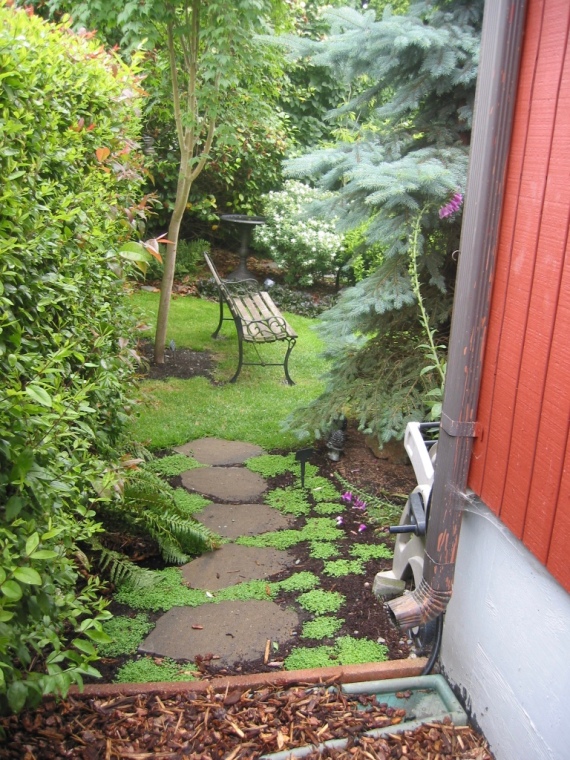
Going into the Front Yard
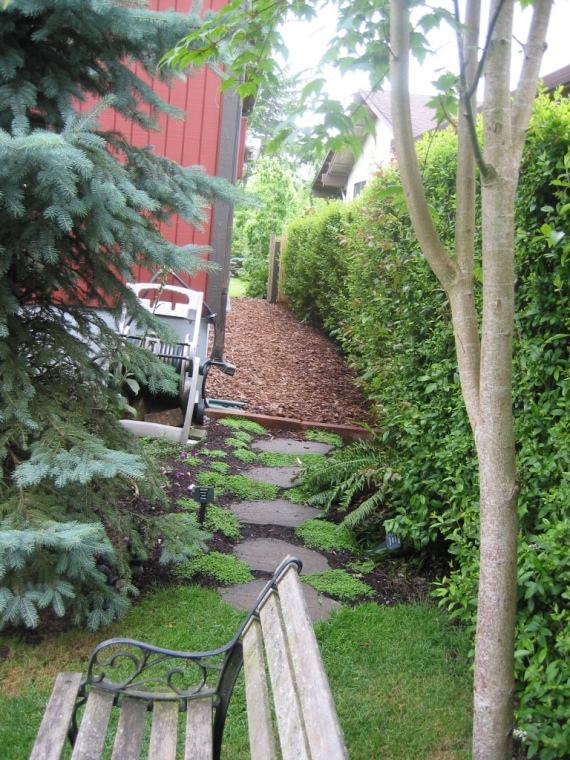
Going towards the Back Yard
This path runs along the north side of the house. It’s shady and grass won’t grow here, and it was all slanted away from the house and muddy in the rains. So we decided to redo it. We leveled the area and brought in several bags of walk-on bark to create a nice walk along the house. Then we tackled the front area which was another muddy spot which sloped to the lawn. We got some nice stones and laid them in a rising pattern going into the back and planted Corsican Mint (Mentha requienii), a lovely ground cover that smells divinely of fresh mint when you bruise it as you walk past. It’s made an ugly eye-sore into a pleasing path from front to back. It ties the whole garden together so we can walk around the house to see everything. Not much work for a nice return…
Walking gently,
Steve
3
Jun
Posted by steven1111 in Conifers, Dwarf Plants, Garden Construction, Gardening, Gardens, Unusual Plants. Tagged: Dwarf Plants, Gardening, Gardens, Personal Gardens, Unusual Plants. 5 comments
-

-
2007
-
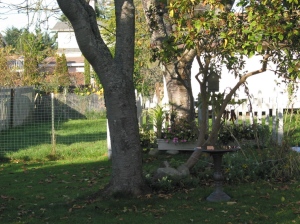
-
2008
-
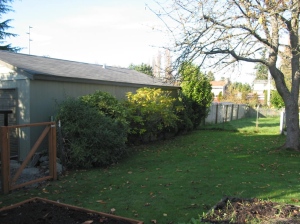
-
2008
-

-
2009
-
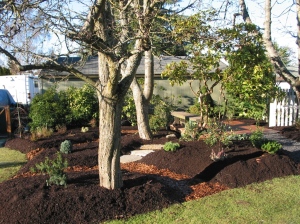
-
2009
-

-
2009
-

-
2010
-

-
2010
-

-
2010
-

-
2011
-

-
2011
-

-
2011
-

-
2012
-

-
2012
-

-
2012
-

-
2013
-

-
2013
-

-
2013
-
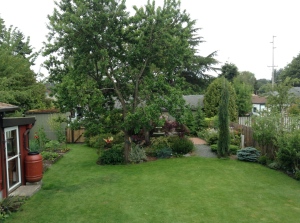
-
2014
-

-
2014
-

-
2014
-

-
2015
-

-
2015
-

-
2015
-

-
2016
-

-
2016
-
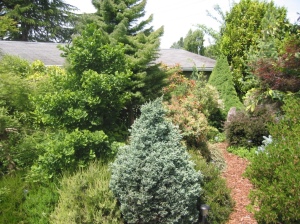
-
2016
I love going thru my photo album and looking back at the garden as it’s grown. I have almost 4,500 pictures so far, dating from 2007 to the present. I’ve been wanting to do a retrospective for some time to show how things have grown over time. So I’ve arranged 3 particular shots over the years in chronological order so we can see each section of the garden and how it’s grown over the years.
Except for the first row where there is no garden, the shots are arranged to show first the front of the garden, then a side view, and finally a back sort of view. Not all these are the same shot of course, but I managed to find ones that seemed to show what I wanted pretty well. Over the time these shots encompass we go from a simple lawn with a few foundation shrubs at the back and some fruit trees to a dense garden full of plants. Unfortunately we lost both of the big Cherries and a large rhododendron. So this garden has a mixture of styles and formats due to the changing of the canopy and other factors.
I might have done things differently if I’d known the trees would die, but who can know those things? I’ve tried to replace them with other trees that will be nice, but there will never be a canopy over it again. That’s OK tho, because there will be a different look to it as the conifers at the back and sides get bigger and provide an enclosure for the garden on 2 sides. Somehow I managed to have all deciduous trees in the middle of everything so in the winter the center of the garden is bare but the sides stay green, and the underplantings stay green too. It’s a nice effect.
If you scroll down each line you can get a sort of slide show effect and see how each area has grown each year. Or you can click on the first one and go thru them that way so you see more. In fact I recommend you do that to see the full pictures.
I took the last set just a couple of days ago so they’re recent. This is how it looks today, tho it’ll be different in a few months after the conifers grow more. It’ll take many years for this garden to mature, and we’ll never get to see it all, but I’m amazed at how much it’s grown in such a short time, so who knows? We’re planting trees we’ll probably never live to sit in the shade of, but other folks will get to. Planning for a future of green…
I hope you enjoyed this look back in time,
Steve
31
May
Posted by steven1111 in Dwarf Plants, Gardening, Gardens, Unusual Plants. Tagged: Dwarf Plants, Gardens, Japanese Maples, Personal Gardens, Unusual Plants. Leave a comment

I have a small garden. So I have to be selective in my choosing of plants. One plant I truly love is the Japanese Maple. It comes in several hundred cultivars and varieties and I have only 9 of them, but I love them all. They’re all unique and none is similar to the others, tho all are Acer palmatums. This first one is a Bloodgood and is considered one of the finest full size Red maples there is. It’s been in cultivation for a long time but it still has admirers. The botanical name is Acer palmatum atropurpureum Bloodgood.

This one is a dwarf and only gets to 4-6 feet tall. It’ll stay in this pot for as many years as I can keep it there. Its called a Goshiki Kotohime, which means Variegated Old Harp. It’s a choice little plant and has several colors in the leaves, thus the name Goshiki, which means 5-colored. The Kotohime means Old Harp, or Koto as most folks know it. A lovely small tree.

This is the first Japanese maple I ever bought for my folks back in the early 70’s ( boy does that date me, eh?). It’s called Kagiri Nishiki, or Roseo Marginatum, which is the name I first learned it by. Its unique in that all the leaves are different and are sickle shaped with beautiful variegation in them, from creamy white to a cool bluish green. It’ll get to about 15 ft tall and wide.

This is another small form that only gets about 8 ft tall and 4-6 wide. It’s considered the best red dissectum there is. It’s called a Red Dragon, as the leaves apparently resemble a dragon’s claws. Very slow growing. I’ve had it for years and it hasn’t grown hardly at all. Oh well, I still love it…

Here’s another red one ( I seem to like colors don’t I?). It’s a Red Pygmy and gets up to maybe 15 ft in time tho it’s only about 7′ now. It has deeply cut leaves that make it look almost like a weeping willow when it leafs out. It turns a luscious golden yellow in the fall. It’s grown fast so far. Beautiful!

This is a well know maple – the Coral Bark or Sango Kaku maple. So called because the red stems look like towers of sea collar rising out of the ocean. It’s a full size one that will get to 25 or 30 ft tall in time. It turns a deep gold with reddish tints in the fall.

This is my newest acquisition. It’s called Shiraz and has incredible variegation in the leaves of a light red darkening to a darker red on the margins. It’s supposed to stay this way for awhile but I just planted it this spring so I don’t know what will happen next. I expect great things from it.
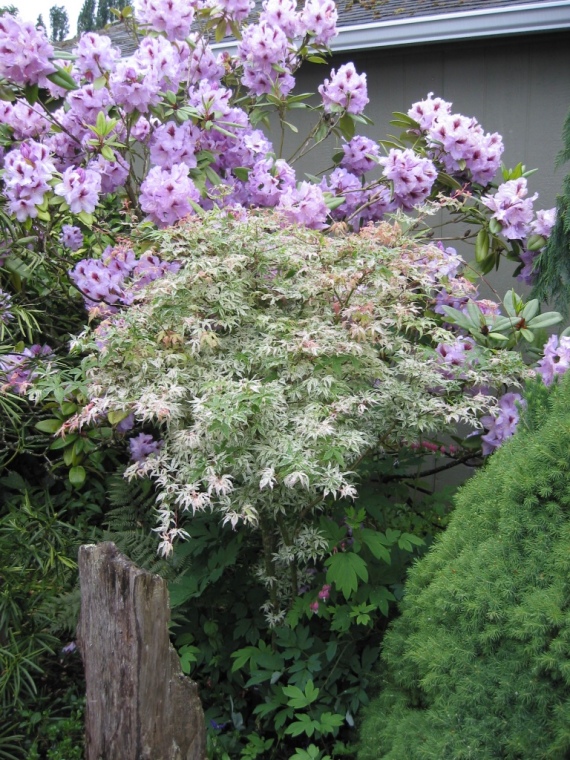
This one has confused me all along. It never has grown more than a few inches each year, and tho it’s gotten much fuller it’s still very small and looks like it’ll be a shrub forever. It’s a lovely form called Ukigumo, or the Floating Cloud Maple. It’s supposed to look like clouds in the sky, and it does against a darker background, which I don’t have. Turns lovely shades of pink in the fall. Behind it is a large Blue Peter Rhodie that has been here for 30 some years. A nice background for this picture…

This is the last one I have. It’s another dissectum called Waterfall. It turns a spectacular golden yellow orange in the fall and is supposed to get to 10 ft tall and 12 ft wide!! Wow! Another time of not reading about the full size till I got home. It’s growing a foot or more a year and I have to prune most of it off because it’s in the wrong place. It’s a beautiful plant still. I’ll get it to fit, just wait…
So that’s the tour. I decided to keep it to mostly pictures this time since I wrote so much last time. I try to balance things out some… I’m glad you could come along on this walk. More pretty pictures to come. 🙂
Thanks for visiting,
Steve
30
May
Posted by steven1111 in Conifers, Dwarf Plants, Gardening, Gardens, Sanctuaries, Unusual Plants. Tagged: Dwarf Plants, Gardening, Gardens, Personal Gardens, Sanctuary, Unusual Plants. 4 comments

I started this blog to showcase the new garden my partner Louie and I planted around our home beginning in 2008 and 2009 and continuing to today. There were some foundation plants here to begin with but we added the bulk of the plants I’ve shown you and will continue to show you in the future, as long as I continue to write this blog anyway. It’s been almost 2 years since I posted to this blog and I figure it’s time to start again, slowly… So, to begin with is some of a retrospective of changes we’ve made since I last posted in 2014. The top picture here is a scene of the whole garden as it exists today. It’s changed quite a bit in 2 years but is still the same as well. I hope you enjoy this tour of what’s new and what’s still growing good. Here we go.

This is a closer view of the picture we just saw. It’s more of an internal view. Since I last posted here we lost a big cherry tree in the center of the yard. It was next to the fountain here and if you look back a few posts you’ll see it and how it looked then. After the tree was removed we planted a new Parrotia persica “Vanessa”, a cultivar of the Persian Ironwood tree that is more columnar and upright in growth so it should fit here well as it grows. It’s chief merit is the amazing colors it turns in fall. It begins in August and continues thru October with colors ranging from deep red to a golden yellow. A very lovely tree, tho it will never provide the garden with the canopy over it as it used to have, but it’ll still be wonderful.

This is a view of the same inner part of the garden from the side area of the lawn. You can see the new Helmond’s Pillar Barberry at the right – an upright growing form of the Japanese Barberry that is purple and columnar and grows to about 4-5ft. In front of it is a Repandens English yew that is beautiful and large. Behind it is the Bloodgood Japanese maple that has gotten quite a lot bigger in the last 2 years. The left side shows the Sequoia Sempervirens “Kelley’s Prostrate” that is now some 8 ft across and about 1 1/2 ft tall. Not as big as they normally get at 379ft or so! This dwarf is still small but it’ll no doubt get bigger in tim, tho I don’t know where it’ll grow since it’s in the paths already. Above it is the Parrotia again. It’s big and floppy from its new growth and still growing but it’ll stand up straighter once the limbs harden off, I hope…
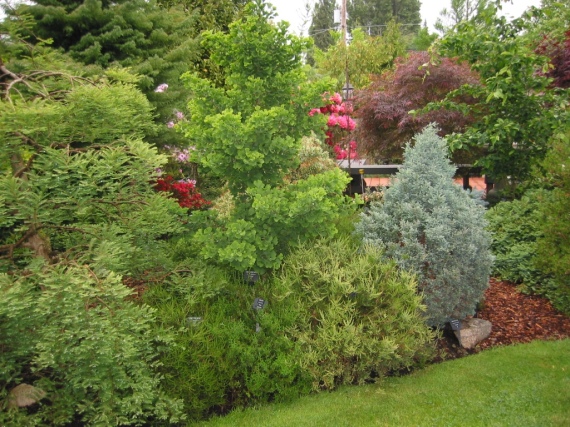
This is another side view farther back showing the “Jade Butterflies” Ginkgo very well. It’s about 7 ft tall now and heading to the 10+ ft it’s supposed to get, tho some say it gets to 20 ft. Who can tell with reading the web sites? They all say different things. I can hardly wait till it gets that big. The little Baby Blue Chamaecyparis pisifera on the right has grown into a 4ft cone now and is getting towards its 6 ft size as well. Still very full and bright blue, it’s a stand out in the garden.

Going around the corner on the path to the left of both of the last pictures leads us to a new plant I just put in last year. It’s a “Diana” Japanese Larch -a deciduous conifer that looses its leaves in the fall after they turn a golden yellow that can be seen from the house. It was planted in the spring of last year and still it grew about 3 1/2 feet the first year! I was amazed with it. It’s grown out to 14 inches already this year so I have high hopes it’ll do well again.

This tree was planted in 2013 to replace the first cherry we lost, and it was only 5′ tall then. In the 3 years it’s grown now it’s up to 13 ft tall. It’s a variety of Cryptomeria, or Sugi as it’s known in Japan, called Radicans, similar to the better know Yoshino but it doesn’t bronze in the winter like the Yoshino does. It’s a real presence in the garden now and tho it will never replace the cherry it was planted for it will still be able to grow to 50 ft here. Next to it is a new Camellia called “Pink Icicle” that was just covered with pink blooms with yellow centers from January thru March. It gets to about 8-12 ft they say.

Moving along the north side of the garden: On the left is the Pendulous Giant Sequoia and next to it is the “Peve Minaret” Taxodium I profiled a little bit ago. You can see it’s grown a lot since the last profile of it. Next to it used to be a Bailey’s Creek Dogwood, but it got way too big so I had to remove it. I replaced it with another Cryptomeria, (I love them…) called Rasen which means barber pole in Japanese. It has rings around all parts of the tree – the leaves curl around the stems and the stems curl around the tree and the bark even has this distinctive swirl to it. Fascinating! It’ll grow to some 20 – 40 ft tall in time and likely will be a bit wonky but most unique. I’ll profile it soon. To its right is another Sugi called “Black Dragon” and next to it is a “Nero” black choke cherry that is the new super fruit called Aronia and is very high in anthocyanins like blueberries, only more so. By it is a fastigiate “Inverleith” Scots Pine that is certainly larger than the 10ft the label said it would be. So much for labels, eh?

I’m jumping to the front yard with a Japanese Katsura tree called Rot Fuchs or Red Fox, for its beautiful reddish blue green color. It’s another fastigiate that will get to 20-40 ft and will grow well here. It contrasts nicely with the Cornus Bailhalo ‘Ivory Halo’ in the back corner (the white one) and the Gracilis Nana Hinoki cypress at its feet in front of it. It’s leaves smell of cotton candy in the fall and turn a luscious golden yellow with reddish tints. Lovely!
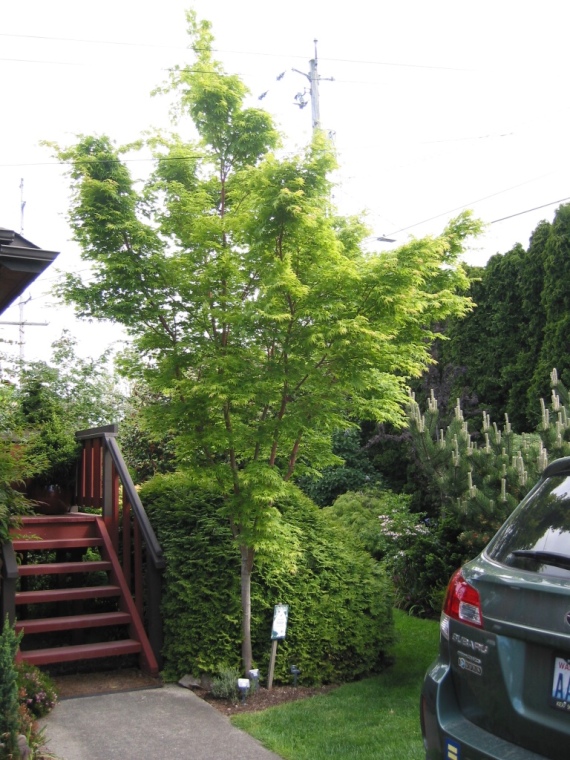
Backing up a bit again now to this Japanese maple called Sango Kaku or Coral Bark maple. Can you believe this tree has only grown here for 6 years so far? This will be its 7th year in the garden and it’s grown from a 6 ft tree to a 16 ft one, or more, since it’s really too high to measure it now. It’s so nice to be able to walk under it as you enter the house. Next to it is the Oregon Green Pine variety of the Austrian Black Pine. I’ll show you a picture of it next.
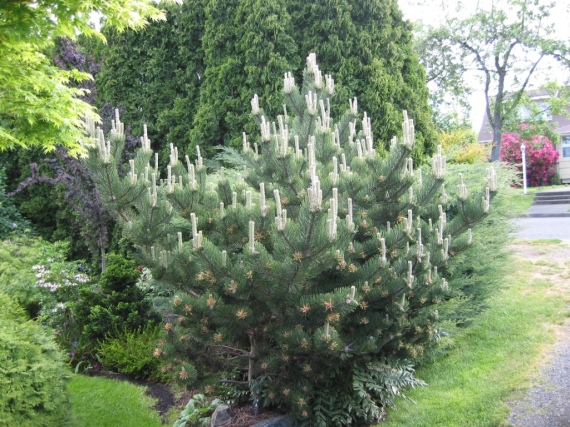
This is the Green Pine with its new candles on it. They look so classy with their bright white color against the dark green of the tree itself. I can hardly believe how big this has gotten in its 7 years there. It provides good cover for the birds and a screen to enclose the garden in front now and makes it all feel like a sanctuary there. It’ll get up to 20 ft tall and wide and it’s about 10 1/2 ft tall now. Not bad for a 4 ft shrub a few years ago…

This is another new tree from a year and 1/2 ago. It’s a truly rare and unique tree – the first rare tree in America. It’s a Franklinia Alatamaha or Franklin tree, named for Ben Franklin himself by the friends of his – the Bartram brothers, botanists to King George III, who discovered it in 1865 along the Altamaha river in Georgia. They couldn’t find it again after 1803 and it’s never been seen in the wild since. All the existing trees come from the ones the Bartrams collected in the 1800’s. It has lovely white camellia like flowers (it’s in the Theacea with camellias) and turns a brilliant shade of reddish purple in the fall. I’ll profile it someday soon too.
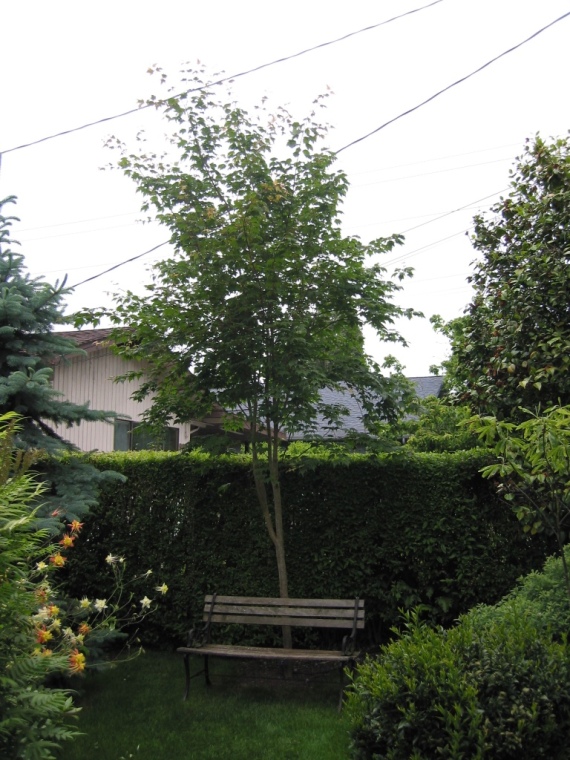
While we’re still in front I’ll show another rare tree. It’s an Acer Tschonoskii ssp Koreanum or Korean Butterfly Maple. It grew 4 feet last year and blew me away totally. It’s too huge now to measure of course but it’s huge. It turns a lovely reddish orange in the fall and is the very first maple to leaf out in mid February, before anything else is moving. It also loses its leaves early, so it balances itself out I guess. A unique specimen and a lovely place to sit on the bench to read or relax.

I’m going to end today with a new garden area we planted this year. In it is a “Teddy Bear” Southern Magnolia. It’ll grow to about 20 ft tall and not very wide. This space used to be a hedge, which you can still see in the back. But we took out about 12 ft and turned it into a tiny garden. This magnolia is going to be blooming soon as you can see with its huge buds and new growth just starting.
So that’s it. I’ve enjoyed showing you some pictures of how the garden has grown. I hope you’ve enjoyed it too. I also hope I can keep up these posts this time but I have some health problems that make that difficult at times. The garden helps me so much with that.
Thanks for reading and happy gardening to you always. It’s nice to be back…
Steve
15
Aug
Posted by steven1111 in Dwarf Plants, Flowers, Gardening, Gardens, Peat Bogs, Unusual Plants. Tagged: Dwarf Plants, Gardening, Gardens, Heathers, Peat Bogs, Personal Gardens, Unusual Plants. 14 comments

I don’t have many Heathers and I’ve tried to group them into a bed by height and size. For once the labels on them were pretty correct and I was able to put the biggest ones in the middle and the smaller ones at the edges, but I don’t prune these so they all are getting quite big and wild looking. I like the look myself. It reminds me of seeing the Heathers on the moors in Scotland when I was there in my teens. This shot shows the whole bed from the south with the Metasequoia at the left side and the Ginkgo in the middle and the Heathers in between them all. I’ll show more with other views of the Heathers.

This one shows the Ginkgo Jade Butterflies in the middle of the bed, and also you can see the Carmina Heather on the left and the Irish Heath in the middle, as well as the Kerstin on the right edge and the Allegro in the top middle.

This is a good shot of the Allegro, the biggest one I have. It’s gotten quite large and is as big as the Baby Blue Pisifera Cypress on the end. It’s in full bloom now.

This one shows the whole bed from the North side. You can see the Rockspray cotoneaster on the end and the Little Heath Pieris in the center before the heathers. At the right side is the side of the Elegans Cryptomeria, and on the far left is a glimpse of the Manazanita, with the Veggie garden in the way back part. The tomatoes are Huge!
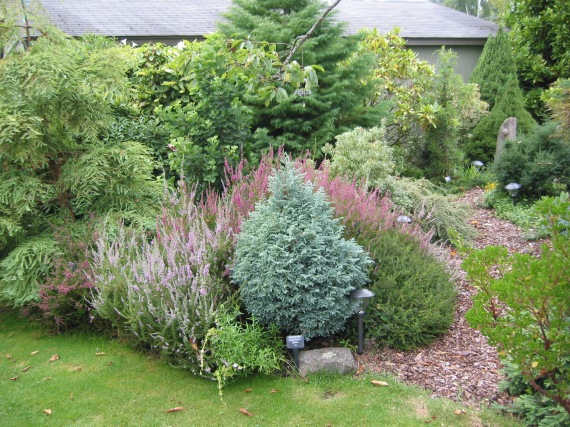
This one is of the edge of the bed from the South east. You can see the Baby Blue Cypress quite clearly It’s grown a lot in the last couple of years and may eventually get to the 6 ft it’s supposed to do. We’ll see. On the right you can see the path that winds thru the garden to deeper parts of it. Looks intriguing, eh? 🙂

This one shows the one Heath in this bed of Heathers. It’s in the front and is a Kramer’s Rote which is covered in deep ruby red flowers in mid winter when all else is bare here. It’s lush green now setting off the flowers of the rest of them. On its right is a H.E. Beale Heather next to the Little Heath Pieris. You can just see the head sculpture next to it on its right. It’s covered up a lot by the growing together of the plants over the years. You can see a clear picture of it on the “Art” page in the permanent archives part of this blog. It’s pretty cool to have art sprinkled around in the garden. It adds a nice new dimension to it all.

Here’s a shot of the Irish Heath close up. It’s a totally different plant than the other heathers and heaths. It’s a Daboecia cantabrica and has these deep blooms that are the typical bell shape of the Heath Family but much larger than the other heathers and heaths. It was a nice find at a local arboretum sale and has grown well in its tight spot. I keep the other heathers pruned away from it cause it’s so special…

Here you can see the wildness of the Allegro in the foreground and an Echinacea purpurea in the background. It’s next to the Elgans Cryptomeria. The Little Heath Pieris is on the right. The Gingko is on the left.
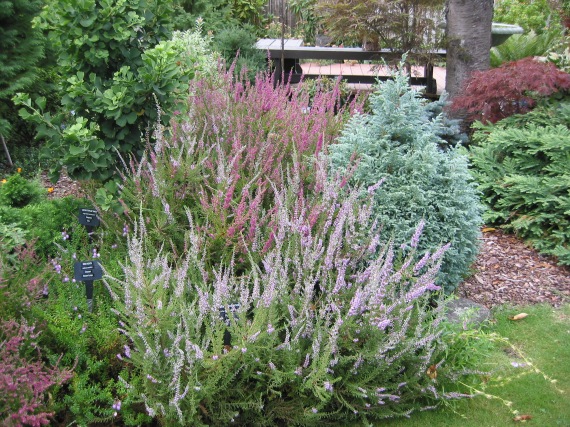
This final shot shows the Kerstin on the front and the Allegro on the back with the Baby Blue Cypress on the right side edge. You can also see the Ginkgo on the left. And to the right edge is the Sequoia prostrate form I profiled recently. I know this isn’t much of a formal Heather Garden but it’s what I’ve got and l personally love the wildness of it all. I may prune them some this year I dunno but I hate to do it. It’s so interesting to see how big they actually get and if they’ll stay green throughout or lose their inner leaves as they often do when left like this. It’s a gamble I’ll admit but I think it’s a good one.
It’s so delightful to see the many varieties of heater that I have in this small space. They all have a different look to them, some of them even turn color in the winter which is nice. It’ll be a thick bed as it already is and it’s grown so tremendously in the last 5 years it’s hard to imagine it was all so small so recently. Our peaty soil does wonders for plants like this in the Heath Family. They really love it as you can see. It’s rich and full of moisture even on hot days so water is still required but not a lot of it. I’m very happy with this bed of Heathers and others, and hope it continues to grow well in the future. Thanks for taking the time to visit me here and see them!
Hooray for Heathers!
Steve
12
Aug
Posted by steven1111 in Conifers, Dwarf Plants, Garden Construction, Gardening, Gardens, Unusual Plants. Tagged: Dwarf Plants, Gardening, Gardens, Japanese Maples, Nature, Personal Gardens, Unusual Plants. 8 comments
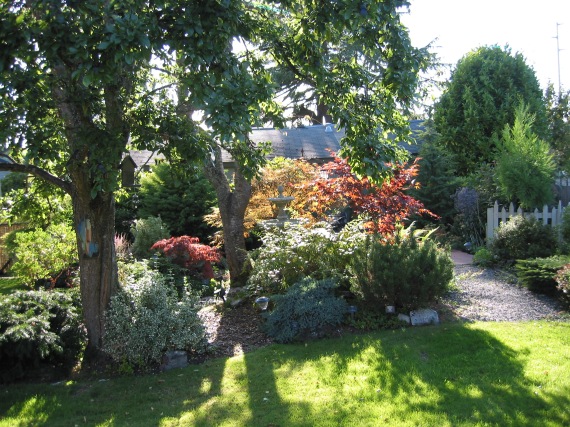
We’ve been lucky to get some sunshine lately and I happened to be out in the back yard the other day when I saw this shot. So I went in and grabbed my camera and took a few photos. (You can click on them to get a larger size shot). I was struck by how beautiful the Japanese Maples look in this picture. From the left is a small dark red one called Red Dragon. It’s a Dissectum type maple and is supposed to be “the best red dissectum”. I’m leery of superlatives but I will say it’s quite beautiful tho it hasn’t grown much in the 4 years it’s been here. But I like it just fine as it stays this dark red all summer long.
The one in the middle is called Red Pygmy and is a Linearlobum type maple. It has strap like leaves that are deeply cut, almost like a dissectum but not as much so. This tree looks almost bronzy golden in the sun but its leaves are actually a light burgundy and look lovely. This tree has grown immensely from a small stick to over 6 feet by 7 or 8 wide. It turns a spectacular golden in the fall.
The third one on the right is a classic Palmatum type of maple called the Bloodgood. It’s an Old standard that has been in cultivation in this country since the Civil War and is named for the Bloodgood Nursery on Long Island in the late 1700’s. It gets to 20 feet tall as opposed to 10′ for the Red Pygmy so it’ll get larger here and fill the space it has to grow into fine.
You can see several other plants in this shot. On the far right is a newish favorite of mine from just a year ago. In that time it’s grown 4 feet and is amazing. It’s a Cryptomeria called Radicans. I have several of the Cryptomerias and I love them all. All are unique and interesting. On the far left is a spreading yew, or Taxus repandens. It’s grown quite a lot in its years here and is a low dark green presence at the corner of the yard. Next to it on the right is a Wintercreeper called Gaiety, or Eunoymus fortunei. It’s trying to grow up the Plum but I’m not letting it do so.
To the left of the Plum is a Manzanita called Howard McMinn that shows off its reddish bark for you tho it’s a bit hard to see. I’ll do a full shot of it soon and show a bit more of it. In the center of this shot is a Leucothoe fontanesiana called Rainbow that turns lovely purples and reds in the fall, tho not as much as I expected. I love the fountain like display it puts on. It loves the water it gets when we clean the fountain too.

In this next shot of the garden a few steps closer, you can see the maples better and also the Blue Star juniper in the middle of the front row. Next to it is a Mugho Pine called Pumilio. It’s done well so far but not gotten too big which is fine with me. It holds down the corner of the garden there near the path. I should mention the two big trees you can see as trunks are an Italian Plum on the left that feeds many of the food bank folks we give the plums to. We like to eat them too but we get so many it’s good we can share them with others. The other tree trunk is a Queen Anne cherry that gives a lot of fruit to the birds but we rarely get any of them. Oh well, it’s a lovely tree and gives some shade to the otherwise open garden.
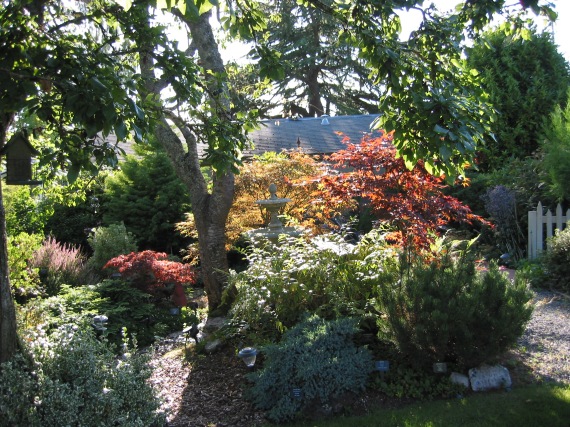
This is the closest picture of the garden and in it you can see the Heather blooming in the left of the shot, and next to it is another Cryptomeria called Elegans, for its elegant look and soft quality of its leaves. I’ve profiled it before and it’s one of my “Petable” trees. It’s grown from about 1 foot and 1/2 to over 9 feet in 5 years. Wow! I’m impressed. Also here are on the right side you can see the Variegated Sea Holly with its purple cast of blooms near the white picket fence. It’s the most bee friendly plant I have in that it attracts several varieties of bees and is covered in them at times in the sun. What spectacular sights to see and it holds its color for several months quite nicely. Also in the middle of the shot is the Coast Redwood I profiled a week ago – the Kelly’s Prostrate. It’s just to the left of the Red Dragon maple in front of the Heather.
So that’s the pictures of the garden in the sun. It’s so lovely when it shines thru things like it does now. I like how it illuminates them from behind like this. I was lucky to catch it when I did as we haven’t had much sun since this happened a couple of days ago. It’s still been in the 90’s tho, which is very hot for us here in Seattle. We’re melting…. 🙂
Japanese Maples rock!
Steve
19
Jul
Posted by steven1111 in Dwarf Plants, Gardening, Gardens, Groundcovers, Unusual Plants. Tagged: Dwarf Plants, Gardening, Gardens, Groundcovers, Personal Gardens, Unusual Plants. 4 comments
-

-
Elfin Thyme
-

-
Irish Moss
-
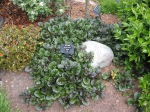
-
Ajuga “Black Scallop”
-

-
Bunchberry
-

-
Corsican Mint
-

-
Bearberry, Kinnickinnick
-
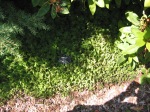
-
Redwood Sorrell
-

-
Viola
-

-
Black Mondo Grass
I often write about all the small plants I have in this garden. Mostly that means dwarf and naturally small growing plants. But today I’m going to feature a few of the really little plants I have here – the ground-covers. Some of these have been growing for years and others only a few months but all of them are special to me and provide a really unique aspect to the garden in places. I love seeing them as they spread out and fill the spaces around them and provide a green swath of color and beauty to their spots.
I’m starting off in the front yard with the Elfin Thyme. I just love that name and it sure does fit it well. I planted it about 5 years ago from a 4″ pot, and it’s grown slowly but consistently to fill this spot among the stones that lead to the bird feeder in front. It’s in bloom now and I hope you can see the little purple flowers on it here and there. I haven’t seen it bloom before this year so it’s a treat to see. A very lovely plant that does a fine job of softening the stones and making the spot seem gentle and smooth.
Next to it in both the tour and in the garden is an Irish moss. I only planted this last fall but it’s growing well since then and is in bloom as well as the Thyme. It’s got little white flowers that cover areas of the plant and it looks so lush and bright green like an Irish Moss should. It’ll fill in more and smooth the area between more of the steps to the feeder. A favorite of mine for many years.
And next to them in the garden is a patch of Ajuga “Black Scallop” so named for its dark leaves. It’s not quite in bloom yet but it has spikes of lovely purple flowers about 5 inches high that coves the plant. It grows really fast and I only planted these starts from another spot last fall when I did this whole bed. It’s grown really fast and is covering up the area well. It looks so neat and tidy now and does so for most of the year. I love the dark color of the leaves.
I move into the back yard now and show you the Bunchberry. It’s actually a dogwood if you can believe it! Just a small dwarf plant it only grows to several inches tall and has creamy white dogwood flowers in the spring and covers this area between the mugho pine and the bluestar juniper well. I’ve been fond of this plant for a long time and am happy to have it thriving here in my garden.
The Corsican Mint is probably well known as it’s a staple in many gardens that can’t handle the cold for baby tears which it looks a lot like but is more cold hardy. It smells so strong that if you step on a corner of it the whole area is inundated with aroma and you can touch it and carry the smell on your fingers for hours. Truly one of my favorites. It seems to die off regularly and then comes back again each spring and I dunno why but I like it even so.
The Bearberry, or Kinnickinnick as the Indians called it, is a wonderful ground cover Manzanita in the heath family. It grows pretty wide but so far I’ve kept it from growing onto the path near it. It’s a special plant in the mythology of many native people as they use it in their smoking blend they use in the Sacred Pipe Ceremony. I’ve also used it in a smoking mixture I used to make in my Wildcrafting business I did while I lived in the Okanogan I profiled a couple of posts ago. This is a variety called Vancouver Jade that seems to be more compact than the species and is full and lush here in this back spot in the garden.
The Redwood Sorrel has been a mixed bag for me. I love the plant so I had to plant it, but little did I realize what a pest it can become. It spreads way too well and has covered up much of the space around it and even killed a couple of plants by smothering them. It also broke a branch on my Red Dragon Japanese maple by pulling it down and snapping it. I guess I wasn’t paying as good attention as I should have been but I try now to keep this lovely plant somewhat controlled so it can’t do that anymore. It’s a drag to have to pull it all the time but I keep it off the paths and in a smaller area than it wants to be. In one place I’ve given up and just let it grow. So far so good and it seems the plants there can handle it. It has lovely white flowers on it in spring. I just love it despite its problems. It gets about 8 inches tall and is very full as you can see. It reminds me of the Redwood forests in California where it covers miles of ground.
A friend gave me this Viola and I’m not entirely sure which one it is but she warned me that it was very invasive so I planted it the fern bed so it can’t escape too far and cover too much space. But it does a good job of that in the bed anyway. It fills the whole area around many of the ferns but they can handle it it seems and I pull it back some to keep it from the lawnmower and the different plants in there with it. It not only spreads by roots but by seeds too very easily so it’s truly an invasive and and it’s beautifully full but I’d recommend it be planted like I did in some place where it can’t take over the whole darn garden…
This last one isn’t exactly a ground cover but it’s close to one. It’s a Black Mondo Grass that I’ve loved for ages. I’ve grown it before and they always seem to do well. This one has spread for years to cover this small area near the garage entrance so it’s close up to see it whenever we go to the garage. It’s got little purple flowers on it now and is quite lovely. It only gets about 6-8 inches tall so I included it here as it does cover the ground and spreads slowly so it’s a ground cover to me.
So that’s the tour. It’s a short one but I don’t have that many of these tiny tiny plants. Someday I’ll cover the miniature conifers I have that are one step up from these ground covers. But this time I wanted to stay small and give you a few pictures of what is under the other plants and fills so many areas with color and green.
I hope you’ve enjoyed this little tour of little things. Some time it’s nice to honor the smallest things among us and reflect on how much joy they can bring even tho they are so small and tiny. I’m fond of all of these plants and they all occupy a unique place in my heart. I hope you like them and that even if you’ve seen them before they still please you to see them again….
For the little ones,
Steve
3
Jul
Posted by steven1111 in Conifers, Dwarf Plants, Gardening, Gardens, Peat Bogs, Unusual Plants, Wet Soils. Tagged: Dwarf Plants, Gardens, Peat Bogs, Personal Gardens, swamp cypress, Unusual Plants, Wet Soils. 12 comments
-
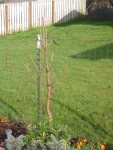
-
4/5/11
-
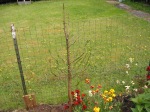
-
5/30/11
-

-
6/24/11
-

-
7/9/11
-

-
11/18/11
-

-
6/16/12
-
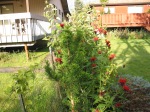
-
7/19/12
-

-
11/12/12
-

-
7/11/13
-

-
8/10/13
-

-
9/16/13
-

-
10/30/13
-

-
11/13/13
-
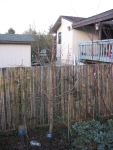
-
2/14/14
-
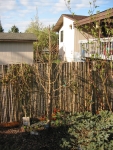
-
4/9/14
-

-
4/23/14
-

-
5/28/14
-

-
7/3/14
I wrote a profile of this plant a year and 1/2 ago, but it’s grown so much since then and all I posted then was a single shot, so I thought I’d do a pictorial journey thru this plant’s life here in our garden. We planted it in early April 2011 so it’s only been growing for 3 years and a bit. It grows pretty fast for a dwarf. This is a cultivar from Holland of the Swamp Cypress that grows all over the Southeast of the US and is endemic to the swamps and wet places of the region.
As a tree it gets quite big, but this little dwarf will only get to some 10 feet by 3-4 feet , or so they say. It’s already that wide or wider but only about 6-7 feet tall so far, tho it’ll be taller in a couple of months as the top grows. I’ve noticed an interesting thing about this tree, and several other conifers, that intrigues me. It starts to put on growth at the bottom of the tree first and then works its way up to the top after several weeks of growth. It’s in that stage now where it’ll put on a new top, and it should put on a foot of growth there if it does what it did last year, which is no definite indication but hopefully it will do so. It also tends to put on several tops and then reduce them to just one. I’d heard that you had to prune the extra ones out, but that’s not true. The trees know what to do I’ve noticed so I just let them do it. Sometimes it’s best Not to prune…
I did a lot of research on this tree, as I outlined in my previous post I did on it here: https://gardeningingreenwood.wordpress.com/2012/11/28/the-persistence-of-greenery/. I’ll try not to repeat too much of that post but I want to talk about it a bit. It’s a unique plant in that it’s one of only a few conifers that lose their leaves in the fall and renew them in spring. The others are the Larix, or Larch, the Metasequoia, or Dawn Redwood, and the Ginkgo, or Maidenhair tree. There’s some debate about whether or not the Ginkgo is really a conifer right now but I like i that way so I’ll include it anyway. I have a Metasequoia and the Ginkgo in the garden as dwarfs but no Larix, yet… I haven’t found a dwarf of it and I wouldn’t have space to put it anyway so it may not be in my agenda. But we’ll see.
This plant loves wet places to grow as I mentioned and that’s the primary reason I planted it here. This is a really wet spot in this peat bog we garden in, and we lost a few other nice plants here before I did the research to find this one that loves having its feet wet. It’s thriving where it is so I think I made the right choice. I also planted a creek dogwood and a choke cherry along this fence line as they also love the wet soil, as do the dwarf Cryptomerias along the edge of the bed. The only original plant I put in here that survived is the Inverleith Scotch Pine and I’ve read that Scotch pine like it a bit wet too so that makes sense. It’s doing great too and it is now over 10 feet tall, it’s supposed height, tho some say it gets much bigger. I assume it will.
This plant is one of my “pettable” trees because it has such gloriously soft foliage and is so nice to touch and stroke. The others are the Metasequoia and the Cryptomeria elegans that both have very soft foliage and don’t feel like most conifers at all. I’m fond of touching the plants I grow just to get a”feel” of them and so I notice little things like soft foliage on conifers. It’s a treat to feel them. I have a few really prickly plants too, like the Oregon grape and Mahonia charity and even the Osmanthus goshiki, so it’s nice to have others that you can actually touch, tho the others are so soft when they put on their new growth it’s hard to imagine how tough they will become.
I’ve arranged these pictures in chronological order so you can get a sense of how fast this tree really does grow. I’m really amazed by this and it’s good for me as I’m pretty impatient at times and it’s hard to wait to watch plants grow slowly when you want them to get big fast. It’s a trap of course and it’s a joy to watch the Chamaecyparis obtusa Nana only putting on about a 1/16″ of growth a year. You can just see it on the tips of the branches. The same is true of many other dwarf confers, like the Cryptomerias Tansu, Pygmaea and Vilmoriana. They all just barely let you know they’re growing and it’s so cool to know they are and yet don’t show it much. Slow has it’s place just as fast does.
So I hope you found this enjoyable to see how this lovely tree grows so nicely and fills out so well as time goes on. If it does grow this much in only 3 years it’ll become a larger tree in time I think, despite the things they tell you on various websites when you look them up. I’d love it if it did get bigger than its supposed 10 feet but if it doesn’t do that I’ll be happy too of course. I just have to keep the creek dogwood next to it away from its top so it can get there. I have to do a bit of pruning to keep all the plants in their spaces and be cool with one another in their growth habits. It’s a nice challenge to grow this garden and I’m so glad you stopped by to see some of it.
Good growing to you!
Steve
15
Jun
Posted by steven1111 in Dwarf Plants, Flowers, Gardening, Gardens, Greenhouses, Unusual Plants. Tagged: Dwarf Plants, Gardening, Gardens, Greenhouses, Personal Gardens, Red Plants, Unusual Plants. 22 comments
-

-
Red Yarrow “Paprika”
-

-
Red Dragon Japanese Maple
-

-
Red Pygmy Japanese Maple
-

-
Bloodgood Japanese Maple
-

-
Weeping Purple Beech
-

-
Red Fox Katsura
-

-
Physocarpus “Seward”
-

-
Blue Peter Rhodie
-

-
French Lavender
-

-
Garden Sage
-
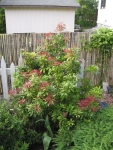
-
Mountain Fire Pieris
-

-
Columbine
-

-
Heuchera “Coral Bells”
-

-
Anna Rose Whitney Rhodie
-

-
Crimson Pygmy Barberry
-

-
Unknown Azalea
-

-
Ward’s Ruby Azalea
-

-
Bow Bells Rhodie
-

-
Ken Janeck Rhodie
-

-
Tulips
-

-
Elephant Ears
-

-
Thrift
-

-
Lawrence Crocker Daphne
-

-
Native Bleeding Heart
-

-
Blue Diamond Rhodie
-
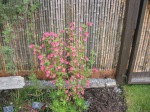
-
King Edward VIII Currant
-
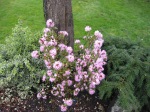
-
Racemosum Rhodie
-

-
Winter Daphne
-
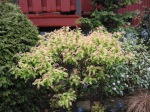
-
Ural False Spirea
-
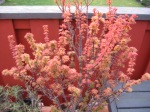
-
Goshiki Kotohime Japanese Maple
-

-
Kramer’s Rote Heath
-

-
Persian Cyclamen and Tradescantia
-

-
Nandina “Moyer’s Red”
And Pink, and Purple, and some in between colors too, but they all fit in the spectrum of Red. I’m amazed by all the plants I have that have red tones to them. It’s obviously a pretty popular color. I’ve tried to add them to the garden because they add so much interest and I love the varied hues they represent. Some of them are in the leaf and others are in the blooms, but all are in the reddish range and provide some intense color to the garden at most any time of the year. These pictures cover the last few months since things started to bloom and leaf out well, tho they’re not in any particular chronological order.
First up is a Yarrow that just keeps getting better each year. It’s called Paprika and has intense red blooms with yellow flecks in the centers. Then are 3 different red Japanese maples that are even named red, like the Red Dragon and Red Pygmy, and the Bloodgood is considered the most excellent red cultivar of Japanese maples you can find. It’s been in circulation since the 1800’s sometime as I recall.
The weeping beech I planted as a memorial for my brother and it has his ashes underneath it. It’ll get taller eventually but since I stopped staking it up it’s stopped getting taller for now. I’m hoping it’ll mound up on itself as time goes on but it may just get wider I’m not sure. The Red Fox Katsura is hard to see I know but it has deep purple blue green leaves that are even more red at first growth. It hasn’t grown this year at all which concerns me but patience is called for here and I’m trying my best to just allow it to grow on its own pace. It’ll be a lovely tree in time.
The Physocarpus, or Ninebark as they’re called, is a small shrub with deep maroon leaves and light pink flowers that didn’t bloom much this year but it grew well. While the Blue Peter Rhodie has been here for years and always puts on a fine display of flowers. The lavender and the sage are in the Herb bed and I’ve gotten a lot of good food from this bed. I harvested my savory and oregano awhile ago while it was in fresh growth and some rosemary too. I’ll have a good stash for cooking this year.
The Mountain Fire Pieris, or Lily of the Valley shrub, has such fine red tones when it first leafs out that turn to a light mahogany and then to green as time goes on. Buds will set on it from this fall and it’ll bloom in winter with white blooms. I’m rooting for this one to get bigger so it screens us from the neighbors on the deck. It takes time tho so I have to be patient again. It’s required when you a start a garden mostly from scratch and use smaller plants like we did. It takes time and waiting is hard for me but I do it because what else can one do?
I know the Columbine I showed is more blue than red but it’s so beautiful I had to show it. It’s a self sown seedling that just came up in a bed of them I let happen. I love them so much I just let them grow since they aren’t in the way at all. The Heuchera is in the front yard and adds some nice color to that area there with its delicate blossoms and fine maroon leaves. The Anna Rose Whitney Rhodie is in the back of the whole garden and will be a foundation of the corner of the yard as it gets bigger which is doing well now.
The Barberry is a small shrub that has to compete with the Spruce next to it on one side and the Giant Sequoia on the other. It seems to be holding its own tho so I’m not worried. A little bit of pruning on the spruce and it looks fine. The next azalea is one Louie planted years ago so I don’t know its name but it’s sure lovely isn’t it? Bright and lush it always makes me smile. So does the Ward’s Ruby, one of my favorite azaleas. It’s a kurume so it doesn’t get too big but has loads of blooms when it does so. The Bow Bells and Ken Janeck Rhodies both come on light pink and then one changes to deep pink and the other to white as they age. Both are lovely. The Ken Janeck is a Yak rhodie, a small form with huge leaves that I love. Very cool.
Clearly the Tulips have been here for awhile and it’s amazing that they still come up thru the soil we put there and the plants grow thru them now. They add some bright color to the winter garden when they bloom. The Elephant Ears or Saxifrage, are in the front of the whole garden and provide a soft haven of their flowers with their lush foliage. I love the deep color they have.
The Thrift, the Daphne and the Bleeding Heart are all in the same area and are quite wonderful when they all bloom together. The Daphne is so fragrant too, it’s possible to smell it standing up next to it but if you really want to smell it you have to get down on your knees. It’s wonderful. The Blue Diamond Rhodie has grown a lot this year but only bloomed a bit. It’s so healthy tho I’m happy with it. The currant is blooming well in this picture but hasn’t grown much yet this year, as have so many plants. It seems to be the year of patience for me this year as I’ve said before. Ah well, as long as they keep growing I have faith that they’ll do well in time.
The Racemosum Rhodie is a species Rhodie that has wonderful light pink blooms at an early stage in the season. They come when you’re just tired of winter and need a bit of color in the garden. They provide some wonderful blooms. The Winter Daphne has wonderfully fragrant flowers in pink and the Ural False Spirea has such cool pinkish tips to its growth I’ve included both which live next to each other in the front yard. You can smell the daphne all over he yard when it blooms.
The Goshiki Kotohime maple means “variegated old harp” in Japanese. It supposedly reminds one of the Koto, a stringed instrument that is endemic to Japan. A lovely plant and a wonderful instrument. This is the new growth that is so very bright and then fades to green as the year progresses. Very lovely. The Heath is in the Heather garden and adds some blossoms in winter when the heathers are dormant.
The next shot it is of under the starting bed in the greenhouse and has a Persian cyclamen and a Tradescantia which both are doing well this year. They get a bit of water from the bed but we still give them extra to keep them going well. Last is a Moyers Red Nandina in full color with both leaves and berries red as can be. It’s a nice one to finish off this tour of red shades I think.
I hope you enjoyed this tour of Red. I’ve done blue before but never red and it seemed like it was time to do so. With all the maples in particular and the other plants now in such fine colors I just had to share them. They brighten up the garden like nothing else and are so varied as you can see that they provide much interest even beside the color. The forms and the textures too add dimensions to the whole interplay of color and style in this garden as they do in so many others.
Red Rules!
Steve
15
May
Posted by steven1111 in Dwarf Plants, Flowers, Gardening, Gardens, Unusual Plants. Tagged: Dwarf Plants, Flowers, Gardening, Gardens, Personal Gardens, Unusual Plants. 14 comments
-

-
Pieris Little Heath
-

-
Pieris Mountain Fire
-

-
Kramer’s Rote Heath
-

-
Winter Daphne
-

-
Lenten Rose, Hellebore
-

-
Elephant Ears
-

-
Rhododendron racemosum
-

-
CA Dutchman’s Pipe
-

-
Wild Ginger
-

-
Trillium, Native
-

-
Red Flowering Currant
-

-
Rhododendron Blue Diamond
-

-
Rhododendron Patty Bee
-

-
Bog Rosemary, Andromeda
-

-
Daphne Lawrence Crocker
-

-
Thrift
-

-
Rhododendron Dora Amateis
-

-
Rhododendron Curlew
-

-
Candytuft
-

-
Viburnum davidii
-
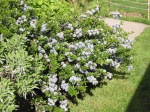
-
Pt. Reyes Ceanothus
-
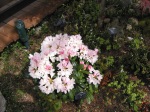
-
Rhododendron Ken Janeck
-

-
Aronia, Choke Cherry
-

-
Azalea Ward’s Ruby
-

-
Rhododendron Bow Bells
-

-
Viburnum rhytidophyllum
-

-
Azalea, Unknown variety
-

-
Daphne Summer Ice
-

-
Columbine
-

-
Columbine, naturalized
-

-
Rhododendron Anna Rose Whitney
-

-
Western Azalea
-

-
Rhododendron Sappho
-

-
Common Sage
-
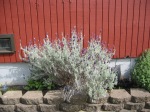
-
French Lavender
-

-
Rhododendron Bue Peter
I went back thru my archives to see how many plants I could find that have bloomed so far this year. They all started with the two Pieris, which were blooming in March when I took the first pictures. As we move thru time and space with the rest of these shots you’ll see them in a chronological order as they come into bloom, or as I get the chance to photograph them. I took the last few shots this morning before I wrote this post so it’s pretty current, tho I didn’t really include everything I could have because the list was getting so big. So here they are as they came into bloom. As you can see there have been flowers here for months and months.
After the Pieris, which really started to show themselves with their buds way back in winter, the next things to bloom were the heaths. My Furzy heaths didn’t look so good this year so I didn’t include them but this Kramer’s Rote is lovely and adds flowers to the Heather Garden at a much different time than the heathers, which bloom in summer. The Little Heath is in there too so the bed is nice at an early date.
The Winter Daphne filled the whole yard with its fragrance for many weeks as it was simply covered with blooms this year. I was amazed and thrilled to see and smell it. Later on I’ll show two more Daphnes -a Summer Ice and a Lawrence Crocker. The first gets to about 4 feet but the other is a dwarf and only gets to about a foot or so but still has an incredible smell to it, if you get down on your knees!, as does the Summer Ice. All 3 Daphnes are wonderful to have here both for their blooms and for their fragrance.
I imagine most folks know the Lenten Rose and the Elephant Ears. Both bloom early and then put on lovely foliage to show us later on so they stay nice for the year. Next is a species Rhodie called Rock Rose Rhododendron that bloomed wonderfully then froze so it’s not looking so nice right now but it’s coming back slowly. This was a hard winter and I lost several plants altogether as well as a lot of burning on others. I’m lucky that so many survived as well as they did I suppose but I always feel bad when things die on me. Oh well, such is life, eh?
I’ve shown the Dutchman’s Pipe and the Wild Ginger before so I won’t go into them again but I wanted to include them as they were in bloom at this time. The next two are natives. One is a Trillium I collected near the road when we were in the mountains, ( I did it right so don’t worry about mal-harvesting… ) and the Red Flowering currant grows in the Cascades and in other woods. It’ll get to about 6-8 feet tall in time and have currants on it at some point, I hope….
The next two are Rhodies that bloom mid season. The Blue Diamond gets about 4 feet tall and the Patty Bee is a clear yellow, unusual in Rhodies and bred in Ireland so the name fits it well. Next is another Heath family member called a Bog Rosemary or Andromeda. I have another form of it too but it didn’t flower too well this year so I didn’t include it but it is quite nice as well, with larger flowers.
Next is one of the Daphnes I talked about earlier, the dwarf form. Next to it is a small Thrift which has such lovely pink flowers and is small at the foot of the fountain where it gets plenty of over splash of water and grows very well. Following them are two Rhoodies. One is the white-with-a-splotch Dora Amateis which is a 3 foot dwarf and the next is an even smaller dwarf with a clear yellow color called Curlew, another species Rhodie. Both are early and lovely.
The Candytuft surrounds our mailbox out front and is visible to all who drive by and see it. It blooms for a long time. I only have one of the David’s Viburnum so I don’t get berries but I love the plant and the flowers it puts on. Later on I’ll show another Viburnum, the Rhytidophyllum, or Leatherleaf Viburnum, that gets 12 feet tall and will require some work to keep it in place as it grows I’m afraid. It’s doing well now tho it went thru some hard times last year before it came out of it.
The Pt Reyes Ceanothus, or California Lilac, has a nice smell to it and attracts lots of bees when it’s blooming tho it’s still early when it does so. The Ken Janeck Rhodie starts out pink and then turns a clear white as it opens fully. The flowers stay on the plant for a long time.
The Aronia is the new super food I’ve found out. It’s super high in those purple/red Phyto Nutrients that help our bodies heal and grow and I intend to make juice out of them this year as it put on tons of flowers and will have lots of berries. They are a bit tart so the juice is good mixed with a sweeter type or some sugar or honey I’ve heard. I’m excited to see how the juice turns out this year. A lucky coincidence, as I didn’t know its attributes when I planted it. I did it because it likes wet soils and it’s very wet where it is…
The Ward’s Ruby is a Kurume Azalea and is covered with small blossoms when it blooms. I love the deep red of it and you can see it from many vantage points it the garden it stands out so well. The Bow Bells is at the foot of the fountain and seems to like it there a lot. It’ll get up to the edge of the fountain someday but it’ll take awhile to do so. Next is the Viburnum I talked about a bit ago that gets so large. It bloomed well this year.
The Azalea is one Louie planted years ago and I don’t know the name of it but it sure is a stand out in the front yard. Very nice. Next is the Daphne Summer Ice I mentioned above and following that are shots of two forms of Columbine that grow in the garden. I love these airy plants that add such an element of grace to the garden. The one set came up all by itself from plants I planted years ago. Amazing!
Next are 3 Rhodies – the Anna Rose Whitney in the back corner of the garden, the Western Azalea, the native that grows in the western mountains and is a parent of the Exbury and Mollis hybrids from England that all smell so sweet. They get that smell from this plant. The last is a Sappho that Louie planted a long time ago. It’s so incredible in the front yard and is dominant there now.
The last row starts out with a Common Sage that has amazing purple flowers that the bees love now. As they do the French Lavender flowers that are coming on strong now. The last is a large purple rhodie, a Blue Peter, that Louie planted and has become a big part of the back drop to the whole back garden. I love the purple flowers with their darker splotches of purple in their centers. It’s probably the largest rhodie we have but some get Much bigger. Some are even trees! I wish I could plant one of them but we just don’t have the room.
Still I’m very content with this amazing garden we have here now. There are almost always things blooming somewhere all year long and if not flowers then the foliage gives us many colors to view and textures and structures that make the whole thing work well. I hope this hasn’t been too long a tour. I kinda got carried away when I started to put out all the things that have bloomed so far this year. I found that it’s quite a lot when I did it. I hope you still enjoyed it all. 🙂
Flowers Rule! (sometimes…)
Steve
9
May
Posted by steven1111 in Conifers, Dwarf Plants, Ferns, Gardening, Gardens, Unusual Plants. Tagged: Dwarf Plants, Gardening, Gardens, Personal Gardens, Unusual Plants. 25 comments
-

-
From the Front Porch
-
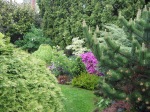
-
Entering the Front Garden
-
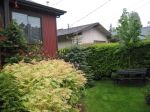
-
Through the Front Garden
-

-
Looking Back to Where We Came
-

-
Into the Back Yard
-

-
Much Color at Edge of Garden
-

-
Looking Along the North Fence
-

-
Main Path Into Back Garden
-

-
Looking Back at Conifers
-

-
Red Maples Fountain and Fern
-

-
Acros the Deck to Bench
-

-
Close up View
-

-
Naturalized Columbines
-

-
NW Back Corner of Garden
-

-
Across the South Side
-

-
Into the Garden From the South
-

-
Looking West by North
-

-
Across the Whole Back Garden
It’s not a great day out to be gardening, but it’s a wonderful one to be out, with a good hat and coat on, just to wander around and see what’s happening while it’s all wet and feels so fecund and fertile. I love being in the garden when it’s raining. It just feels so intensely alive and filled with water, that blood of life that gives our plants their existence, and ours as well of course. Maybe it’s because I’m a Scorpio, a Water Sign, that I feel this so much, but water has always been amazing to me and I treasure it when I hear it on the greenhouse roof or on the leaves around me as I walk thru the plants. So here’s a few pictures from a walk around on a rainy day.
I started out on the front porch and this is what it looks like when we come outside here. It’s immediate and right in your face. I love it that way. You can see over so much of it from here. Next I wandered down into the garden and through it til I came to the end and looked back for a second. Lots of color in these shots. The Ural False Spirea (Sorbaria sorbifolia “Sem”) is lovely with its light pinkish green new growth. And the Waterfall Japanese Maple is just intense with its bright green new leaves. You can just get a touch of the blue spruce in the back corner but it’s just starting to bud out now and will grow a foot and more if we’re lucky .
Next I walked back along the north side of the house and came into the back yard. You can see the north side fence line here as it goes on back to join the garden. I stopped to take a shot of the colors near the entrance. The Globe Blue Spruce and the bright green Bird’s Nest Spruces are lovely next to the dwarf Barberry in between them. The dark green of the Pendula Sequoia is a nice contrast for them all. Looking along the next shot you can see to the back corner of the garden and the Cryptomeria Radicans that is on the left which is just starting to grow, as are the other slower conifers.
The next path takes us into the garden proper and towards the deck. I stopped and shot a few pictures on the way. First I just looked back at those lovely conifers from the opposite direction from before. Then I took a shot of the 3 red Japanese Maples we have in the garden. On the left is a Bloodgood, in the center is a small Red Dragon and on the right is a larger Red Pygmy, all doing well I’m glad to say. The Bloodgood put on over a foot a half this year which amazed me no end. The fern is a Polystichum setiferum, sometimes called an Alaska fern or a Soft Shield fern.
I next looked across the deck towards the back walla and got a nice far shot of the Wards Ruby kurume azalea and the Ukigumo Japanese maple with the Podocarpus macrophyllus in the middle of them. The next shot is a closer view of them. In it you can see how light the Ukigumo maple is now. It’s not grown much for me but it keeps going on so I have faith it’ll take off someday like the Bloodgood just did after a couple 0f years of sitting there. Plants are funny that way aren’t they? Sometimes they just sit there for a long time and other times they take right off. It’s so interesting to me….
I planted some columbine here a few years ago and since then it seems they decided they liked it here a lot. This year I have yellow, blue, pink and red ones and I only planted the blue ones, I think… Maybe I did some of the yellow too, I can’t recall. I love the heck out of them and they look pretty there so I’m leaving them until I see a reason to cut them back. They’re so airy and light I just find them beautiful. I turned to the left for then next shot and got to see back into the corner of the garden to where the Anna Rose Whitney Rhodie is about to begin to bloom. Behind it the Fatsia is putting new leaves on now and you can just see their lighter color if you look hard. This is a wildish area with the redwood sorrel covering the ground in front of the plants and the the Mountain Hemlock to the left a bit. It feels very cool back here I think…
Next I wandered over to the south side of things and took a couple of shots from there to finish off things. The first is actually from the lawn to the east looking west across the yard. Then I looked back to the north and got a nice shot of the fountain with the Bloodgood and the Leucothoe at its base with the native Bleeding Heart in front of them all. I like this view a lot. Next I looked west and could see to the wall again and across the Howard McMinn manzanita, which froze badly this year so I had to cut it back a lot and leave a spare form but I love the red-brown bark so I get to see it more so now. Finally I stand at the front of the Heather garden and look all the way across the garden to the north side. You can see the Ginkgo Jade Butterflies just leafing out in the midst of the heathers and the new growth on the heathers as well.
I suppose I could have taken a few more shots of this but I was starting to get really wet so in spite of my hat and coat I decided it was time to call it a day and start to write this post. So many things are coming out to show us their beauty now it’s hard to pick a lane, so to speak, as far as which plants to feature an show you. They all excite me but then I’m a geek at this so that’s to be expected. I can’t expect everyone to share my extreme love of this artform of gardens that nurtures both our bodies and our spirits as we wander thru them in the rain. I hope you get the chance to be wandering in your special place soon too. It’s time to really get into working at it again, as soon as it quits raining… 🙂
Wet but Happy,
Steve
20
Apr
Posted by steven1111 in Dwarf Plants, Gardening, Gardens, Nature, Sanctuaries, Unusual Plants. Tagged: Dwarf Plants, Gardening, Gardens, Nature, Personal Gardens, Sanctuary, Unusual Plants. 24 comments

I just happened to look out the back window yesterday afternoon and saw this scene, so I went and grabbed my camera and took this picture. I love the way the sun in lighting up the Red Pygmy Japanese maple as well as the smaller Red Dragon on the left and the Bloodgood on the right. The fountain drops add an extra element of delight to me. The Native Bleeding Heart can be seen blooming on the middle left under the Leucothoe, which is just about to start to bloom. This is a shot of the heart of the Sanctuary and these maples are really growing fast now. I’m so excited by all of this… Wow… 🙂
Happy Spring!
Steve
18
Apr
Posted by steven1111 in Conifers, Dwarf Plants, Gardening, Gardens, Nature, Unusual Plants, Vegetables. Tagged: Dwarf Plants, Gardening, Gardens, Nature, Personal Gardens, Unusual Plants. 20 comments
-

-
Front Entrance w/OR Green Pine
-

-
Front Entrance w/Sango-Kaku
-

-
Front Yard w/Butterfly Maple and Red Fox Katsura
-

-
Center Front from Back
-

-
North Side from Front
-

-
Overview of Garden
-

-
South Side Path w/Podocarpus
-

-
Back Path w/Metasequoia
-

-
Heather Garden w/Ginkgo
-
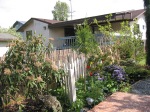
-
Side Back w/Cryptomeria
-

-
Back Path from the South
-

-
Back Path from the North
-

-
On Back Deck w/Red Pygmy
-
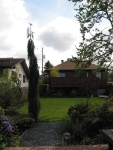
-
From Back Deck w/Sequoiadendron
-

-
North Side Yard
-

-
Central Garden w/Bloodgood
-

-
Fountain in Flow
-
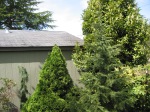
-
Back Corner w/Alberta Spruce and Mountain Hemlock
-

-
Vegggie Garden
-
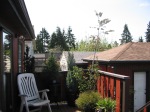
-
House Deck Garden
-
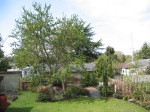
-
Overview from House
So much has been happening in the garden lately I don’t really know where to begin. So I thought I’d do a little tour of the whole place to show what’s happening in a general way. I started out in the front yard and worked my way around the side to the back and then did some shots there touring the garden. I tried to put the most significant plant names in the pictures so you’d know them.
I began at the front entrance to the garden where the Oregon Green Pine shares the space with the Globe Arborvitae which still has its lovely bronze winter color. The next shot shows the Sango-Kaku Japanese maple starting to leaf out. It’s a bit slower than some of the others but it’s starting t0 look like a real tree again now. Lovely new leaves shine against the red stems.
This is a shot of the main front yard looking towards a couple of new trees since last year. In the center is a maple called a Korean Butterfly maple from North Korea, also known as Acer tschnoskii ssp. Koreanum. Very rare I understand and quite lovely. Across on the right is a purple leaved form of Katsura called the Red Fox, or Rot Fuchs in Germany where it was found. It’s a smaller form of the larger growing species. On the left is a Sorbaria sorbifolia “Sem” or Ural False Sprirea. It’s the one with the pinkish leaves.
Looking out from the back you can see the center of the yard from a different perspective. We like to sit on the bench that sits here to just relax and look at the garden in the evenings or whenever we have some spare time. It’s cool to see it from this way where it’s so very private in the yard and we hear the street but can’t really see it. Nice….
Here’s a look down the north side of the house to the back, showing off the Vine maple I just planted a few weeks ago. I’ve had it in a pot for years and it’s good to get it in the ground finally. I had to find a place for it first but I did eventually. It’ll grow to shield us from the neighbors a bit and give an arching entryway to the back yard from the front. As well as turning lovely fall colors it’s a beautiful tree all year and a native too.
Next is a shot of the whole garden from the deck. You can see how it all fits together here, more or less. Next I moved to the south side of the garden and shot a picture of the path that walks into it towards the Yew Pine or Podocarpus macrophyllus. It’s grown all over in the Central Valley of CA where I grew up but is rare here. It gets 20-30 feet tall eventually but it’ll take awhile, like so many others I’ve planted. I must think I’m gonna live a Long time, eh? 🙂
The Metasequoia Miss Grace holds the edge of the path to the back of the garden and you can see the Cryptomeria elegans a bit in back of it too, tho its winter color is fading to green now it’s still beautiful and about to start growing now. Most of the other Cryptomerias are growing now so I’m excited about that.
The Heather Garden has as a centerpiece a Ginkgo called Jade Butterflies that gets about 10 feet tall and will provide a unique aspect to this area. It’s very unique and a living fossil. In the next row is a side path view of the deck of another Cryptomeria called Radicans, that put on a full foot and 1/2 of growth last year after I planted it in June. Amazing! I think it might put on 2-3 feet or more this year. I sure hope so! You can also see the Viburnum rhitidophyllum next to it on the left. I thought it was going to die a year ago but I pruned it back and eventually it came out great and now grows fully and is about to bloom. Wow, the resilience of these plants amazes me.
Next you see the Metaseaquoia again as we look to the north along the back path. And then we look at the same path from the north looking south. You can see the Mountain Hemlock on the right side and perhaps the Wissel’s Saguaro Lawson Cypress on the left down low. They’re very interesting with their arms like a Saguaro cactus. I’m waiting patiently for them to grow their 6 inches a year…
The Red Pygmy Japanese maple is leafing out and putting on some 6-10 inches of growth. I didn’t really realize these maples would put on so much growth in such a short time. These had leaves come on in about a week or so. Incredible and beautiful. Also from the deck you can see the Sequoiadendron giganteum “Pendula” on the left here along the edge of the walk from the deck to the lawn as we look at it. It’s growing more than anything I’ve got so far I think, tho the Radcans might just surpass it.
Here’s one of the north side of the yard with the Inverleith pine starting to put on its candles, and the Choke Cherry “Nero’ covered in bloom buds. The Black Dragon Sugi is putting on new growth too and the Baileys Creek Dogwood is putting on leaves and about to start to grow. When it does I’ll have to be ready to prune it cause it grows Fast and Full. I’ll have to keep training it up to be a tree for me.
This is a common Bloodgood Japanese maple that has just sat here for the last two years but this year it’s putting on that 6-10 inches of growth the Red Pygmy is doing. I’m amazed and thrilled to see this finally. I’d wondered if something was wrong but it takes time for things to establish themselves at times and that’s what happened here. You can perhaps see that the new growth is flimsy and flows down to the ground but it comes back up in time. I’m very happy about this plant now.
This one is of the fountain in full flow. It’s sound is just so soothing to listen to when we’re out in the yard working or just sitting and relaxing, tho we don’t really do that enough. It’s been a treat tho we had to replace part of it that froze this winter cause we didn’t drain it. Ooops! Oh well it’s OK and working fine now that we replaced the broken piece. It should be cool now, for awhile, till the next bad freeze anyway. Maybe we’ll drain it this year….
The back corner has the Alberta Spruce putting on lot of new growth and looking lovely. The Mountain Hemlock is much later so won’t put on growth for another month probably. It’s a high elevation plant usually so that makes sense it’d grow later. This corner is one of the parts of the garden that has a real NW flavor to it when you sit there. It just feels like it belongs here so well. And the hemlock has grown a lot in the few years it’s been there too.
Here’s a lone shot of our poor veggie garden. I was very late getting my seeds started this year so will have to see what happens with my tomatoes in particular. The onions are growing well and the radishes and even the lettuce as well as the India mustard that overwintered along with the Swiss Chard in the back beds. We’ve planted greens but they haven’t come up yet or the carrots either. But they will soon as well as the corn we have starting in the greenhouse to plant out soon. We’re still eating the onions we grew last year so we get good return from this garden and it’s so much fun to do. It isn’t really cost effective but it soothes our souls and make us happy to do so it’s totally worth it.
This is a shot of the garden from the deck outside the back door of the house. In the middle is a new addition – a Sciadopitys verticilatta or Japanese Umbrella Pine. They say of it that it’s a pine but it’s not a pine… In other words it looks like one, sort of, but not really. It looks like it’s made of wax or plastic almost but it’s so slow growing that it’ll stay in its pot for years. I’m thrilled to have this new plant in the garden, even on the deck.
The last shot is another view of the overall back garden. The Plum is almost done blooming now and we did some pruning of it recently to lighten the load but we have more to do still. The cherry in back is in full bloom still but will be finished soon. It’s been pruned a bit to to get off the dead wood.
Overall this garden is very small but it’s got a lot of components to it that make it feel much bigger. Especially once you get into it you feel the size of it more and I’ve tried to give you a sense of what it’s like to walk around in it while it’s a bit sunny out today. I hope you’ve enjoyed this bit of a tour. I’ll do more on specific plants later on.
Hoping Spring is Springing for you now!
Steve
1
Apr
Posted by steven1111 in Dwarf Plants, Gardening, Peat Bogs, Unusual Plants, Wet Soils. Tagged: Dwarf Plants, Gardening, Peat Bogs, Unusual Plants, Wet Soils. 26 comments
-

-
Ginger Patch
-

-
Ginger Flower
-

-
Ginger Plant
-

-
Dutchman’s Pipe
-

-
Dutchman’s Pipe
-

-
Dutchman’s Pipe
The Aristolochiaceae is a very interesting family. To me the two most well known members of this family are both growing in my back yard right now. Both of them have extremely fascinating flowers. I’ve tried to give you a glimpse of what they look like here. Both are very unique and unusual. I like that a lot about them. And they’re also useful.
The first is the Wild Ginger, or Asarum caudatum. It grows wild in the wet forests of the Pacific Northwest and there’s also a related species called Asarum canadensis that grows in the middle of the country and north into Canada, as the name implies. Dan Riegler at Apothecary’s Garden has some great recipes on how to make wild ginger candy. You can see his recipe for his candied Ginger here: http://apothecarysgarden.com/recipes-2/candied-wild-ginger-a-recipe-from-fresh/.
My patch doesn’t look that great right now at the end of winter and is just starting to put on new growth. The flowers can barely be seen in a couple of these shots and you can see how very weird they look. I love the deep burgundy color and the “wings” it has on the sides of the flowers. I’m not sure what they’re called but they look cool to me.
The other notable plant in this family is the California Dutchman’s Pipe. I showed it earlier when it was just starting to bud out and promised I’d show it in bloom, so here it is. I’ve tried to get shots of the whole vine in one picture with others of a closeup of the flowers themselves. They’re quite interesting and unique aren’t they? They really do look like a pipe don’t they?
They call it insectivorous even tho they don’t actually eat insects. They do entice them to crawl down into the flowers tho and pollinate them and then they release the bugs to go on their way. A very civilized system of pollination I’d say. These grow as tremendous vines in wetlands in California. I’ve seen them there and their swamps are very cool and weird too. They can cover large areas and I saw a particular place in their range where the Forest Service had built a walkway over the water so we could walk among them. Very cool.
So that’s it. A simple post for a change. Just wanted to show these extraordinary plants while they were in bloom and looking good. I don’t have enough ginger to really try Dan’s recipe yet but some day I hope to be able to. It sounds too good to miss out on and having unusual foods in my own garden is really wonderful. I hope you’ve enjoyed this mini tour of some unusual plants.
Happy gardening!
Steve
16
Mar
Posted by steven1111 in Conifers, Ferns, Gardening, Nature, Parks, Sanctuaries, Unusual Plants, Wet Soils. Tagged: Dwarf Plants, Nature, Parks, Sanctuary, Unusual Plants, Wet Soils. 19 comments
-

-
Entering the Reservation
-

-
Quinalt Lodge front
-

-
Rain Gauge
-

-
Back of Lodge
-

-
Fireplace
-
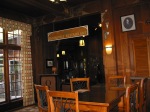
-
Entrance to Dining Room
-

-
History of Building
-

-
View from the Terrace
-

-
Licorice Fern
-

-
Edge of the Woods
-

-
In the Forest
-

-
Willaby Creek
-

-
Deer and Sword ferns
-

-
Deep Woods
-

-
Lichen
-

-
Nurse Log
-
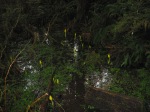
-
Skunk Cabbage
-
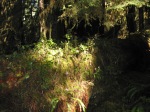
-
Nurse Log
-

-
Nurse Stumps
-

-
Looking Down
-

-
Quinalt Lake
As I mentioned in my last post we just spent a week at the ocean near the Quinalt Indian Reservation. One day we took ourselves into that forest and to the Lodge there for lunch and to tour the area. The first shot is entering the Reservation tho most of the time we were slightly out of it on Park land. The first few shots are of the lodge. It was built in 1937 starting in early June and finished by late August the same year. Teddy was coming and they had to have suitable accommodations.
In 1937 Teddy Roosevelt visited the Olympic Rain Forest and was met by hordes of school children holding signs saying “Please Mr President, we children need your help. Give us our Olympic National Park”. Roosevelt said it was the “most appealingest appeal” he’d ever heard, and in June 1938 he created a 648,000 acre National Park and made it part of the National Park system. It’s now over a million acres. It celebrated its 75th anniversary last year. The lodge is at the southern most tip of the Park at the southern end of Lake Quinalt.
Looking at this structure it’s amazing to imagine them building it in under 3 months back in 1937 without the power tools we rely on today. It’s s a huge place as you can see from the picture that shows it from the back outside on the lawn. The rain gauge on the terrace shows that the highest rainfall they ever had was around 14 feet. Last year is it was 12 1/2 or so. It gets very wet here…
There are a couple of shots of the interior of the Lodge, showing the fireplace that takes 4 foot logs and the entrance to the Roosevelt Restaurant. The picture of all the photos shows the construction of the Lodge from start to finish. It’s hard to read of course but you can see the building going up fast and beautifully. The view from the Terrace shows the Lake as you see it from the dining room windows where we ate lunch. It was amazing and we saw a bald eagle perched in the top of the big Fir at the lawns edge.
Next we start to go on some walks and first encountered this tree covered with Licorice fern which I have growing in my garden. It does this thing where it grows on trunks of trees all over, even here in Seattle, but this was a fine stand of it. Next is a shot of the edge of the woods looking into the depths of the forest. Then we went on a hike on a Nature Trail and took a lot of shots along the way.
Willaby Creek runs under the road here and we can see it as it falls near the bridge and runs under it. It’s a fast flowing stream that gets pretty big in the winter season as it is rushing now. The trail follows its canyon for quite awhile till it turns back to the start of it. There are many fine ferns to see all over. Here are the Deer fern and the Sword fern, two common NW natives that I have in my yard at home. Here they cover the whole area. Quite a sight to see.
Once again we look into the deep woods and see as far as we can into them. It’s not easy as these woods are so dense. I’d never want to bushwhack in them, tho I have. It’s too dangerous and very wet. Lots of water everywhere here. It makes for a lush forest and lots of good growth. Here’s a shot of some kind of weird lichen someone put on a stump so it could be seen well. I dunno what it is but it’s beautiful up close like this.
Next I show a few nurse logs and stumps. These are decaying trees or stumps that serve as homes for new life. In some cases even big trees start out on these logs and create a new forest that way. It’s fascinating. In the middle of them is a picture of a skunk cabbage patch just starting to grow into its fluorescent yellow. Pretty cool, eh?
Next is another picture looking down into the depths of the forest. It’s just so full of life here it’s amazing how it can all fit. But each plant and animal has its role to play and together they all create this incredible ecosystem that ends with a shot of Lake Quinalt from a nice picnic area near the entrance to the Reservation.
It’s a large lake and only is used by the Native fisher folk now because of all the troubles with non-native invasive water creatures being brought in by outside anglers and boaters. Now only the Tribe can use the lake for fishing and I think that’s a good thing. It’ll preserve it from the encroachment of more of the usual development that has already happened here.
Lots of controversy is brewing out here to keep the Olympics wild, tho some locals want it kept for themselves to log and cut down the forest. You can probably tell where my sympathies lie. I sympathize with the local folks but this is a National, even a World Class, Treasure, and it needs to be protected. I think the Tribe will do a much better job of that and maintaining more of the land will only make more trees safe from the chainsaw.
I hope it happens well for all concerned and that some sort of compromise can be worked out to save this forest and keep people’s jobs as well. It’s not am easy task. There are signs all over the area saying to “Stop the Wild Olympics” and let them log it. I personally feel that Old Growth trees should Never be logged, ever again. We won’t have more of them in our lifetimes and even our great grandchildren won’t have them if we don’t save this incredible Sanctuary now. It’s the right thing to do for the generations to come and for the earth itself.
From the Rainforest,
Steve















































































































































































































































































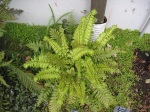


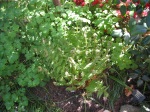





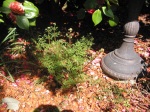
























































 The Maple you enter under – Sango-Kaku, Wissel’s Saguaro Cypress to the left
The Maple you enter under – Sango-Kaku, Wissel’s Saguaro Cypress to the left

 At the end of it – Korean Butterfly Maple, Blue Spruce
At the end of it – Korean Butterfly Maple, Blue Spruce
 The whole thing
The whole thing



 Elegans Sugi
Elegans Sugi
 Back thru the garden
Back thru the garden A dwarf Sequoia – Kelley’s Prostrate
A dwarf Sequoia – Kelley’s Prostrate
 The Inner Glade – the Fountain
The Inner Glade – the Fountain Exiting the garden and returning to the real world. Bye, Steve
Exiting the garden and returning to the real world. Bye, Steve
















































































